PROTECT YOUR DNA WITH QUANTUM TECHNOLOGY
Orgo-Life the new way to the future Advertising by AdpathwayWelcome to our extended coverage of the coolest bits from around the pits at the 2025 Motocross of Nations. For the first part of this feature, in case you missed it, head here: Pit Bits | MXoN 2025 - Part One
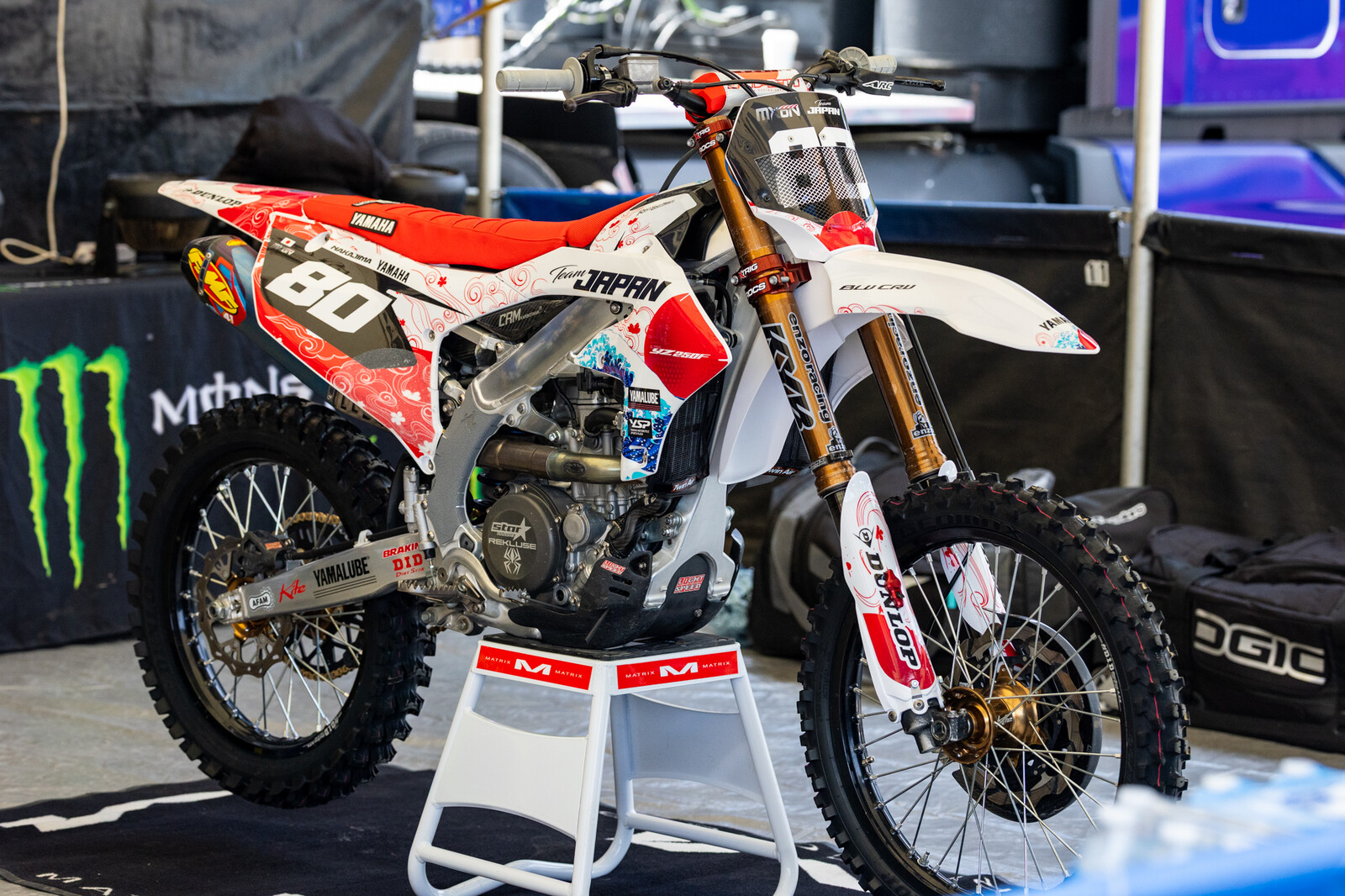 Team Japan's MX2 rider, Nakajima, is a factory Yamaha racer in Japan and the current 250 champion. With a little pull, he was able to secure a loaner machine and support from the Star Racing for the weekend.
Team Japan's MX2 rider, Nakajima, is a factory Yamaha racer in Japan and the current 250 champion. With a little pull, he was able to secure a loaner machine and support from the Star Racing for the weekend.
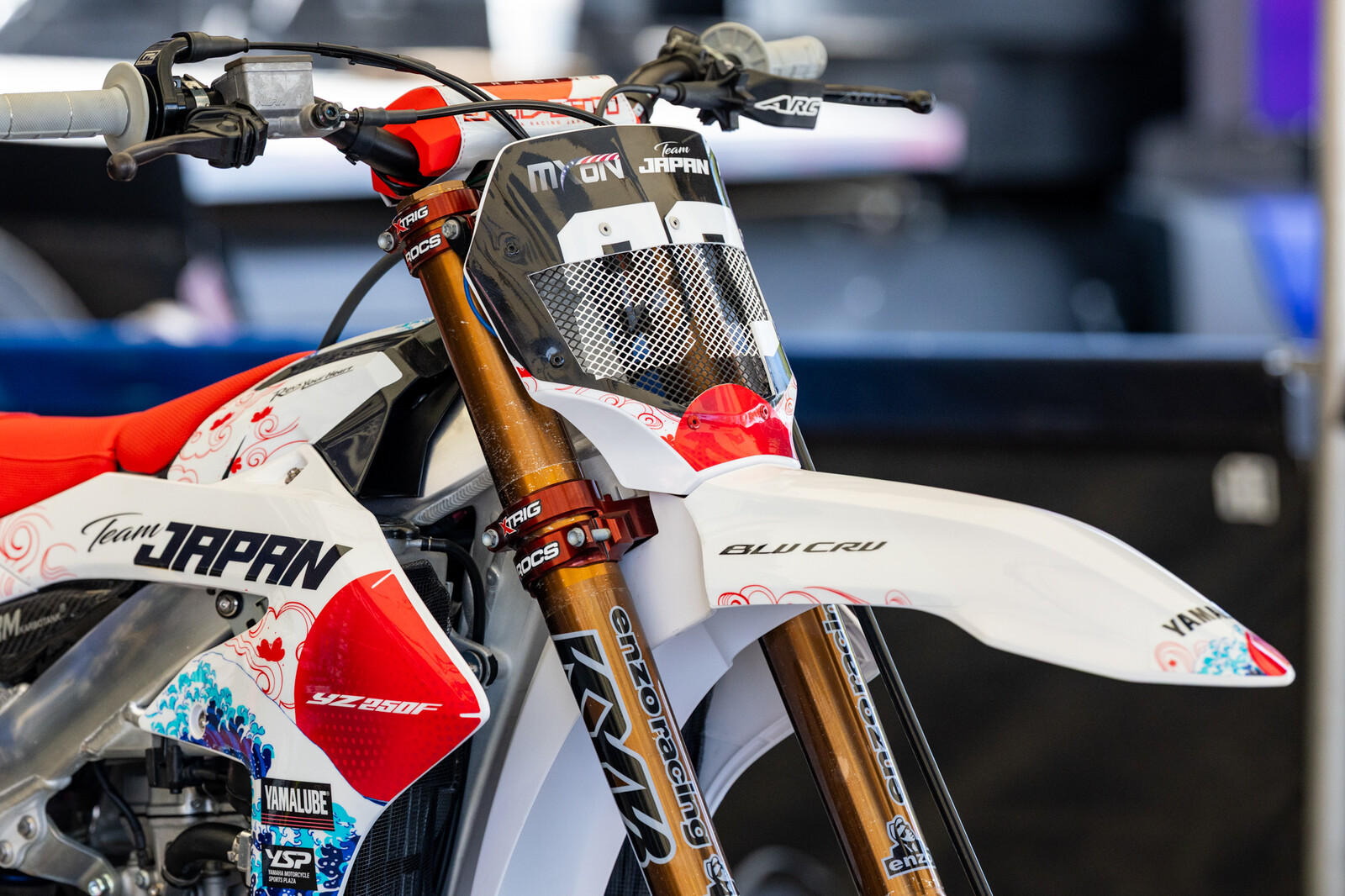
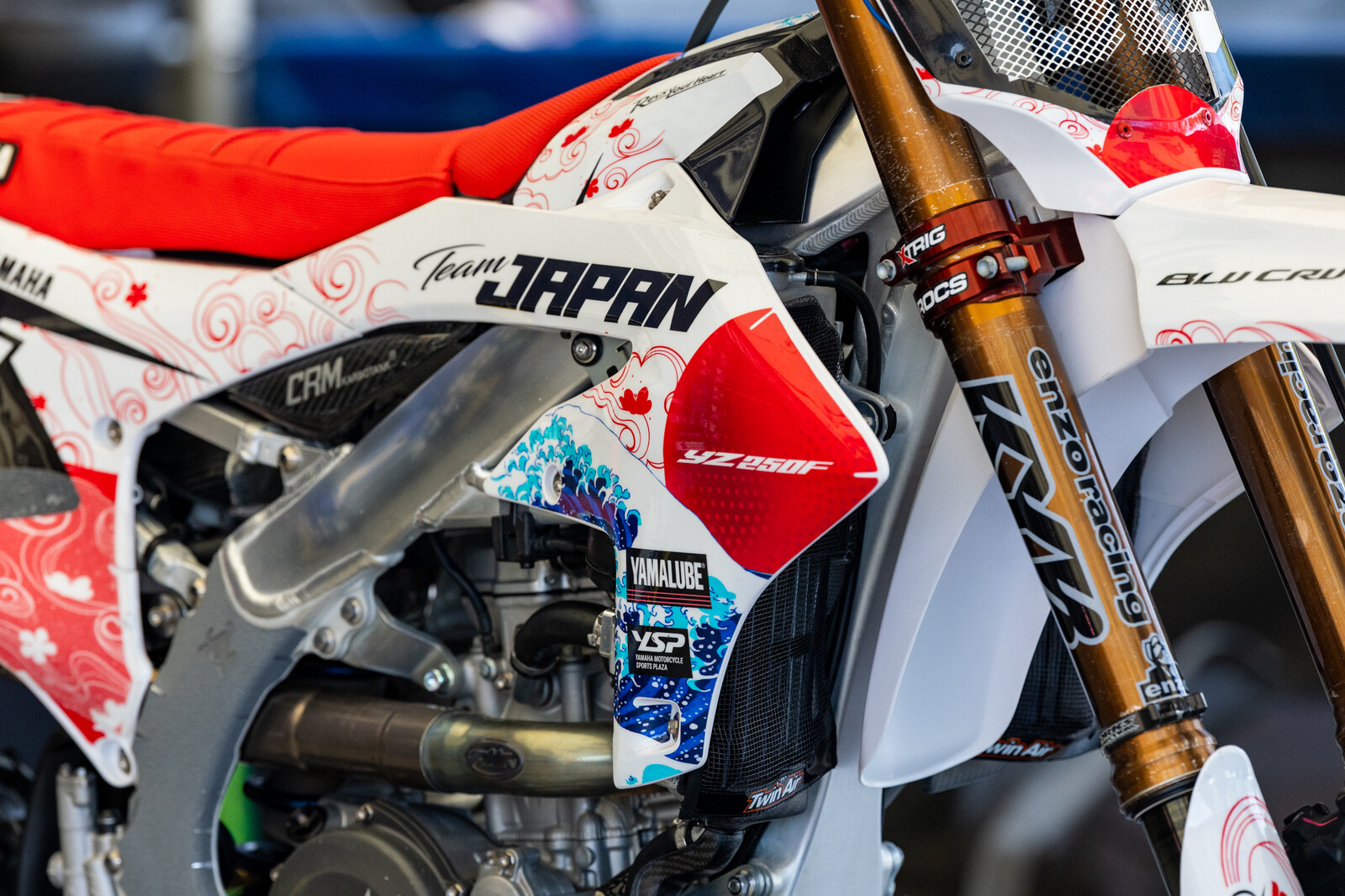 Team Japan's graphics always pop.
Team Japan's graphics always pop.
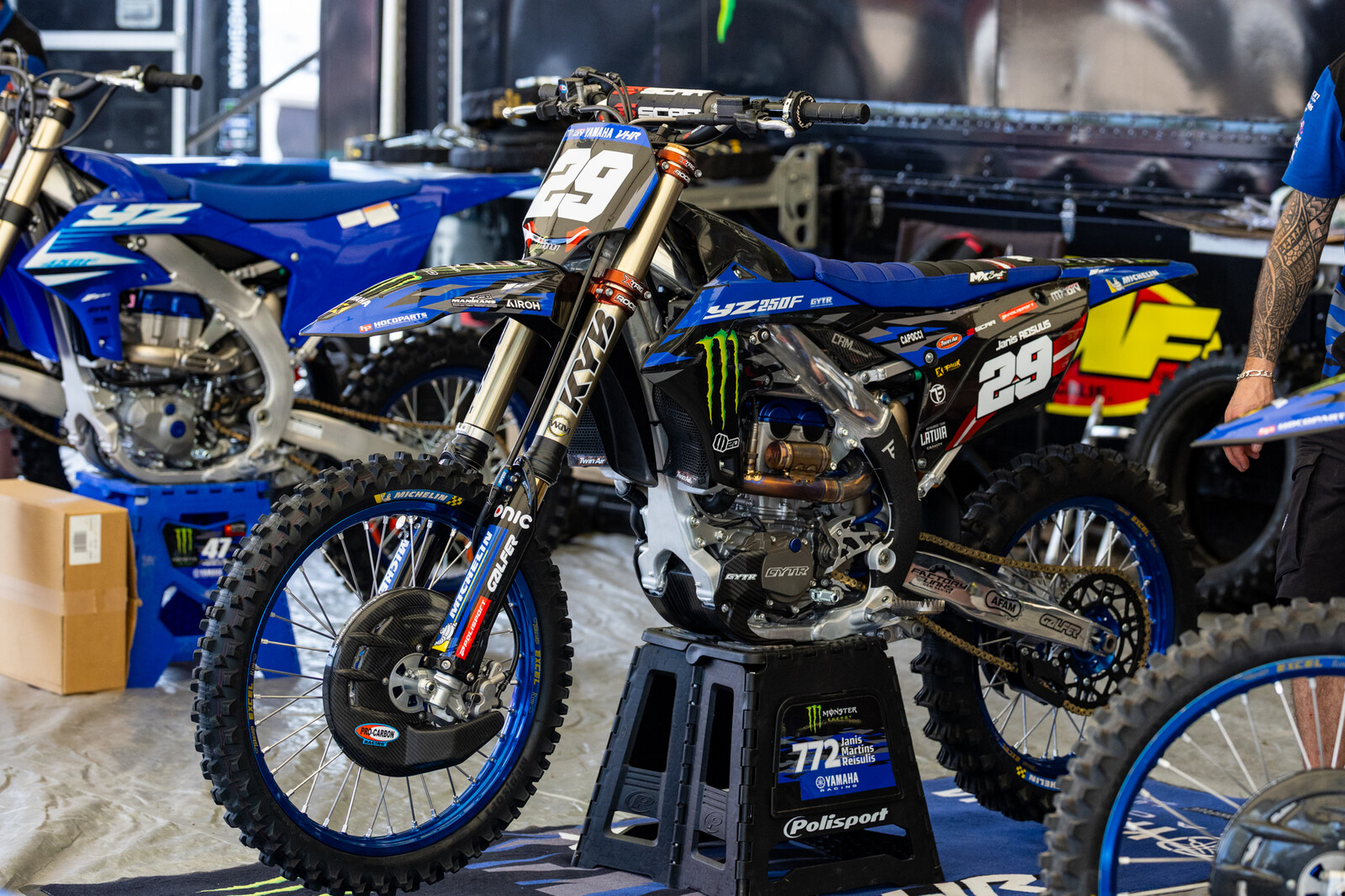 Team Latvia was made up Pauls Jonass and the two Reisulis brothers, the younger of whom was aboard his VHR VRT Yamaha for the last time. As he will be moving to Yamaha's official MX2 team, Hutten Metal, for the 2026 season, alongside his brother.
Team Latvia was made up Pauls Jonass and the two Reisulis brothers, the younger of whom was aboard his VHR VRT Yamaha for the last time. As he will be moving to Yamaha's official MX2 team, Hutten Metal, for the 2026 season, alongside his brother.
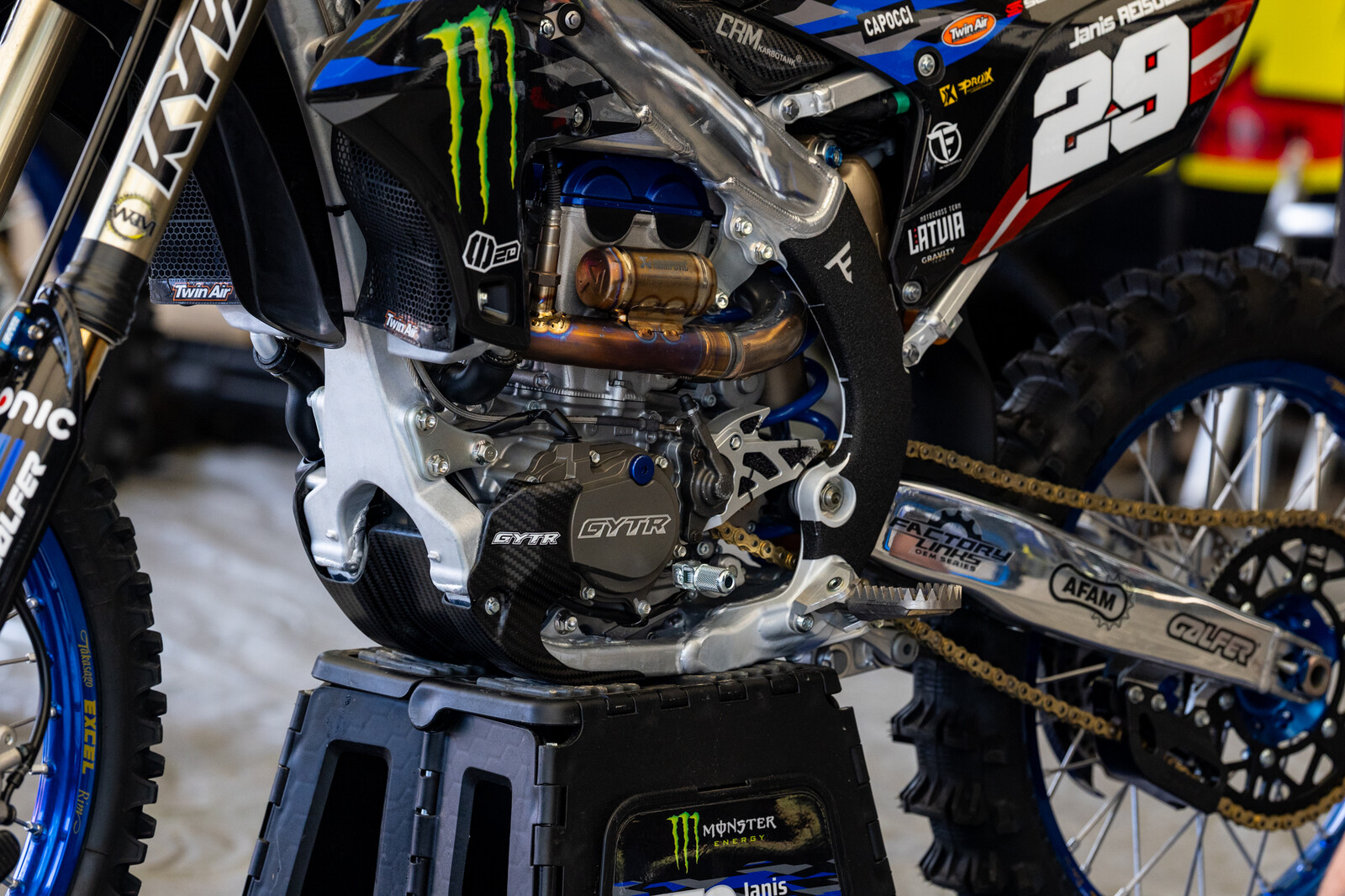 VHR is Yamaha's official EMX250 team and has some GYTR and factory goodies sprinkled throughout.
VHR is Yamaha's official EMX250 team and has some GYTR and factory goodies sprinkled throughout.
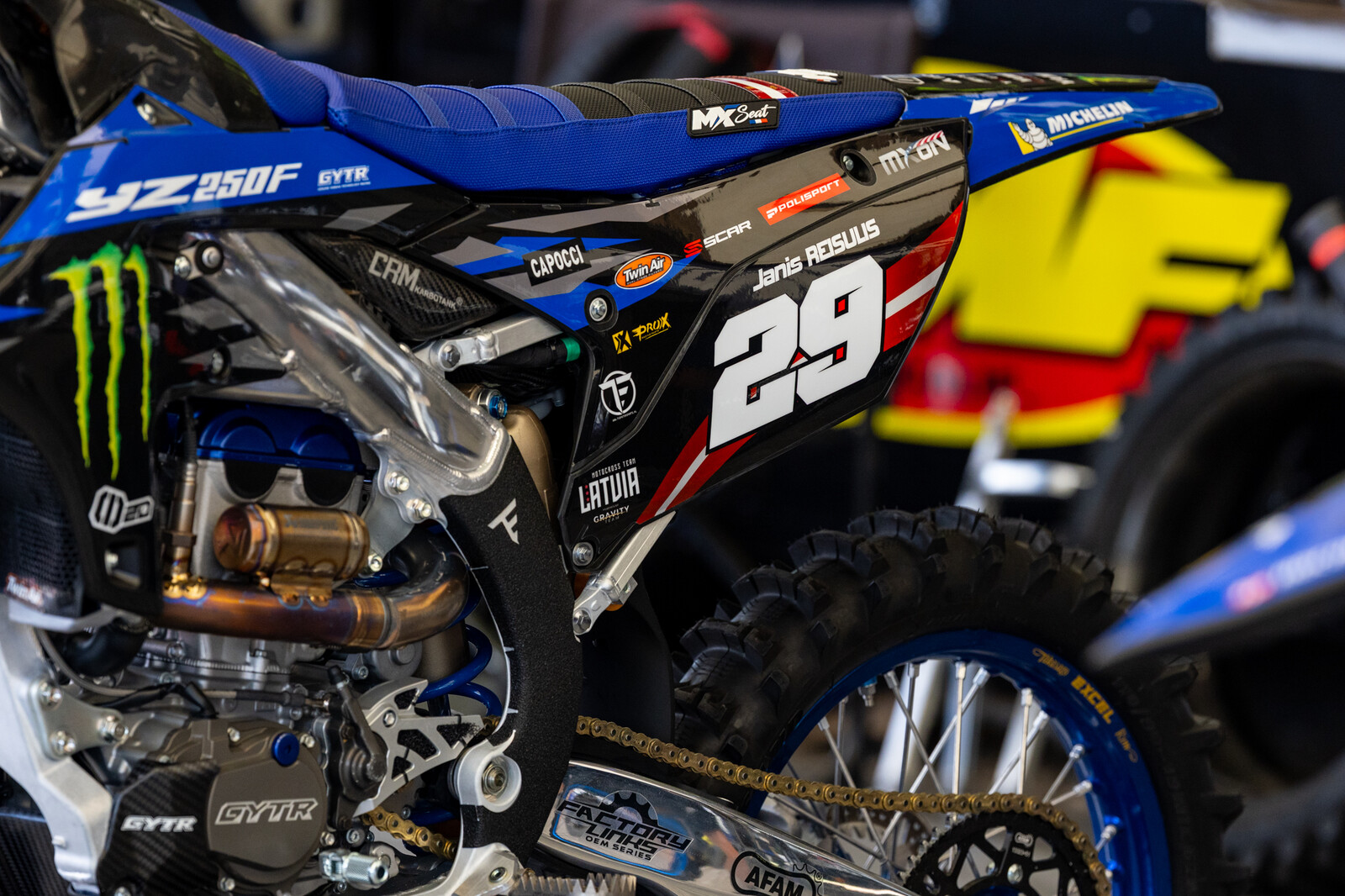
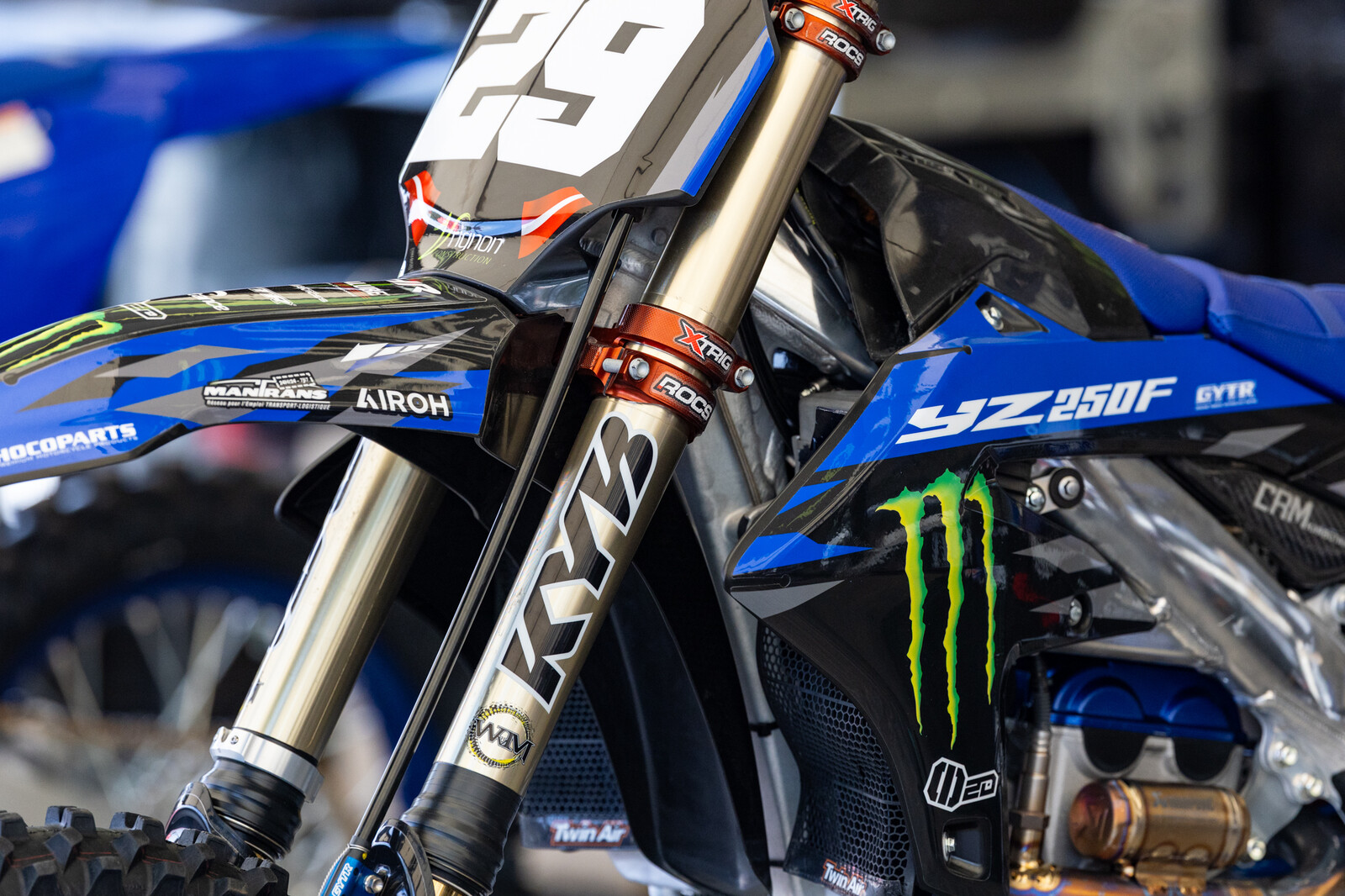 While the upper fork tubes scream stock...
While the upper fork tubes scream stock...
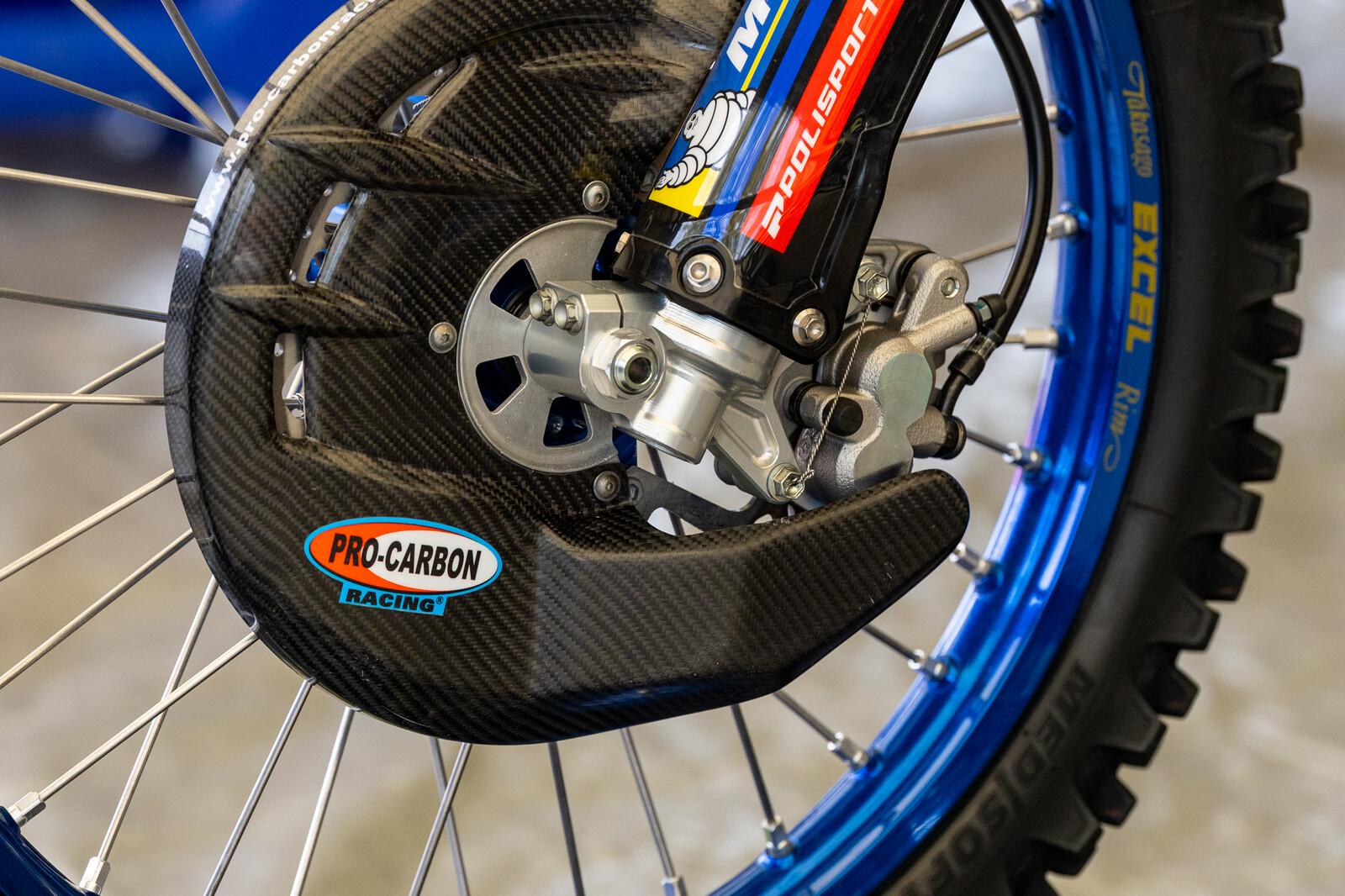 They surprisingly have billet/works lugs and other coatings if you look around enough. Also, nice attention to detail on the wire-tie there.
They surprisingly have billet/works lugs and other coatings if you look around enough. Also, nice attention to detail on the wire-tie there.
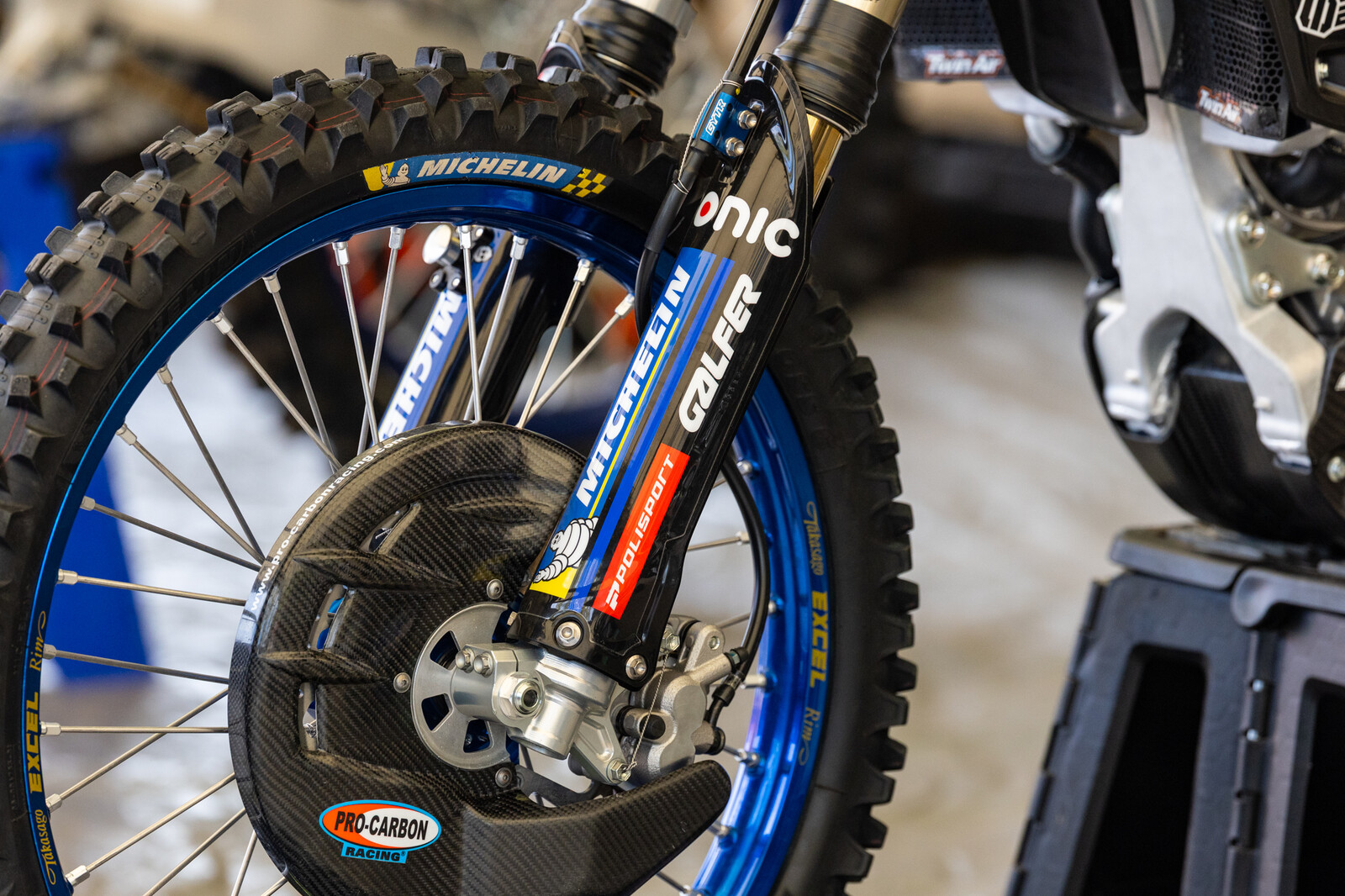 Michelin isn't a name we see very often in motocross/Supercross, as their US racing support has been more off-road for a while.
Michelin isn't a name we see very often in motocross/Supercross, as their US racing support has been more off-road for a while.
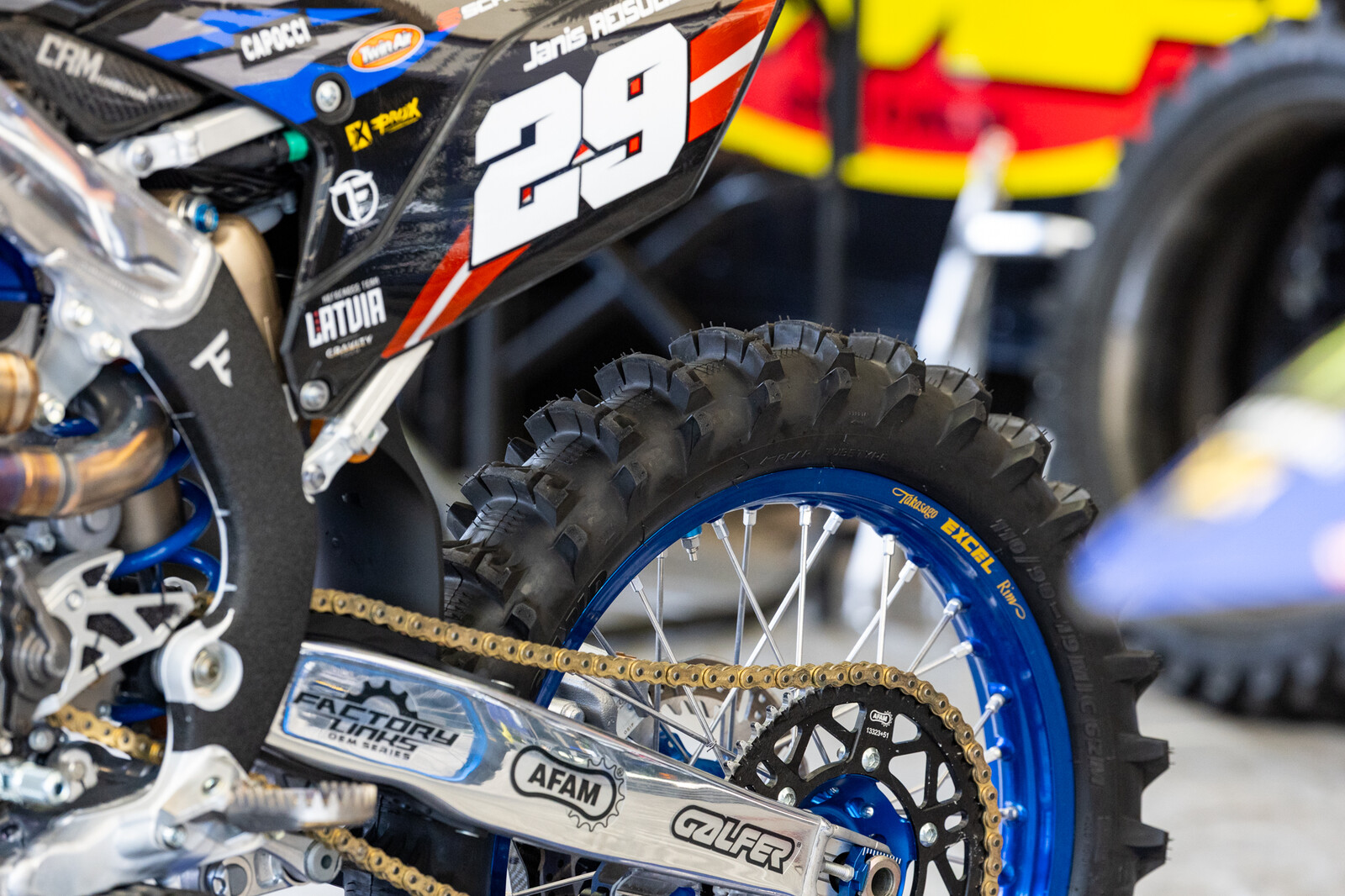 Yes, Michelin has a "scoop" tire.
Yes, Michelin has a "scoop" tire.
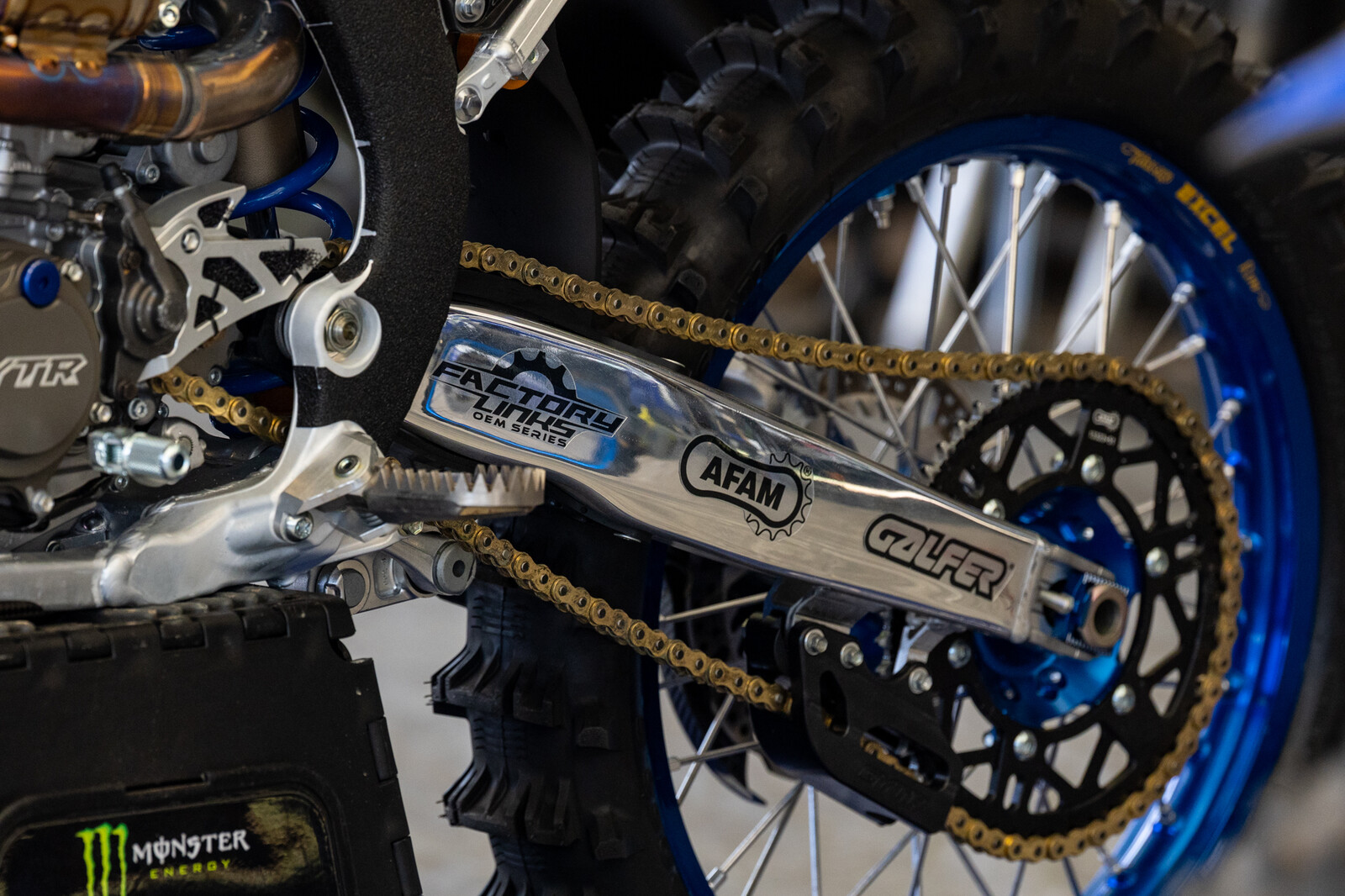 Wow...that's a polished swingarm.
Wow...that's a polished swingarm.
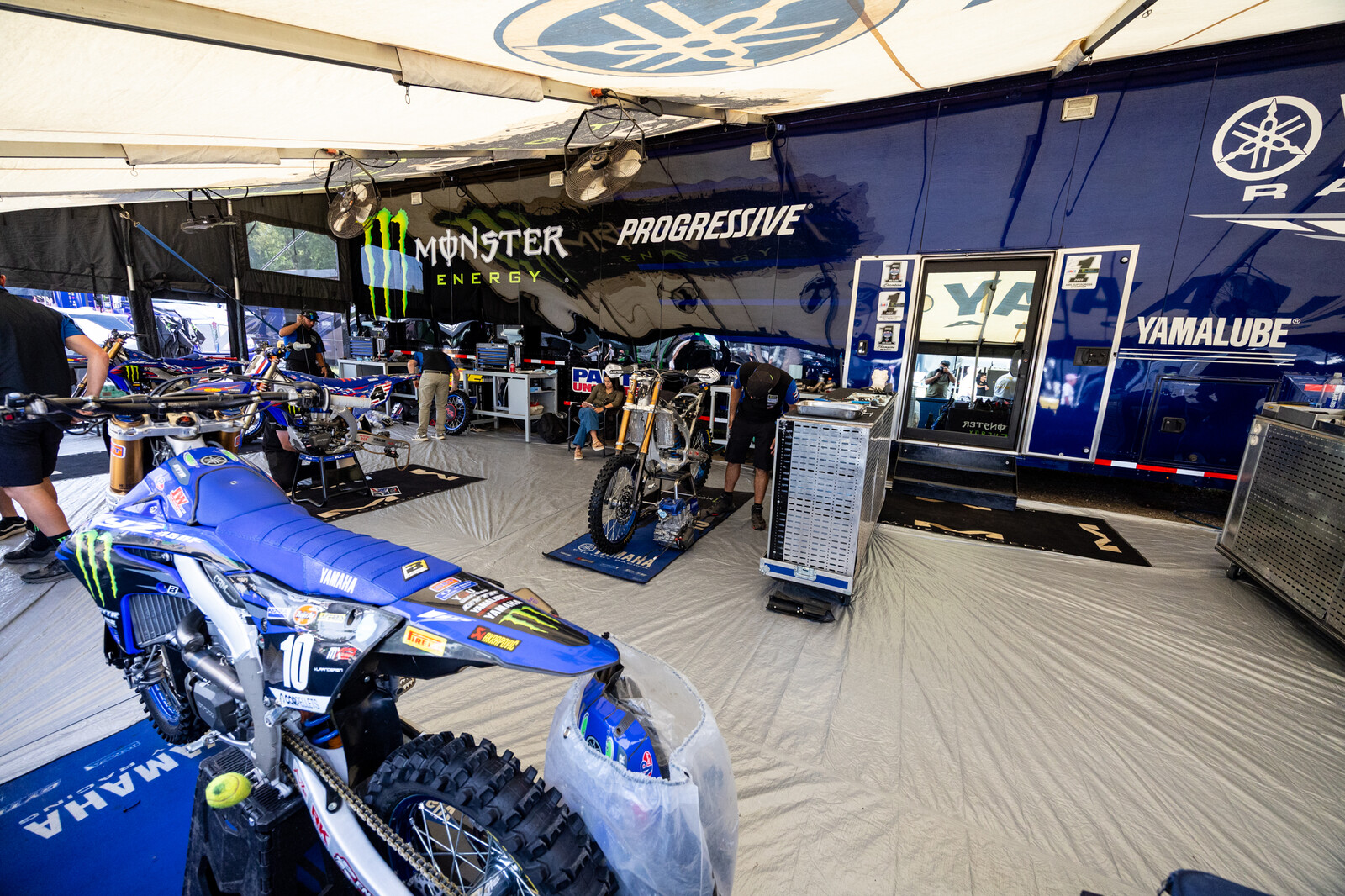 While Japan's MX2 rider and the two Reisulis brothers were housed under Star Racing's 250 rig...Tomac, J-Coop, and Maxime Renaux found themselves under Yamaha's factory 450/Star awning for the weekend.
While Japan's MX2 rider and the two Reisulis brothers were housed under Star Racing's 250 rig...Tomac, J-Coop, and Maxime Renaux found themselves under Yamaha's factory 450/Star awning for the weekend.
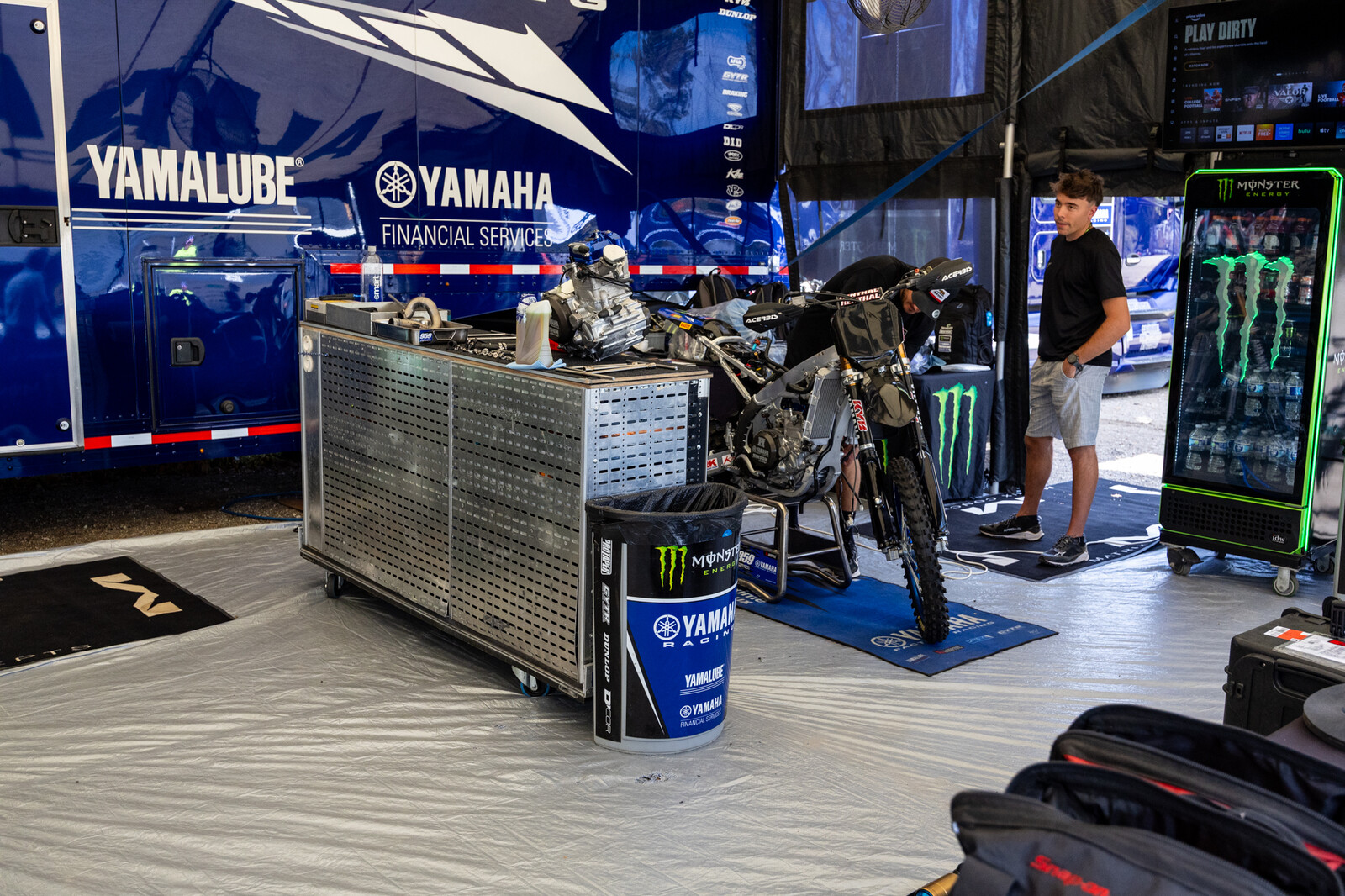 Renaux's Factory MXGP Yamaha YZ450FM being assembled on Thursday.
Renaux's Factory MXGP Yamaha YZ450FM being assembled on Thursday.
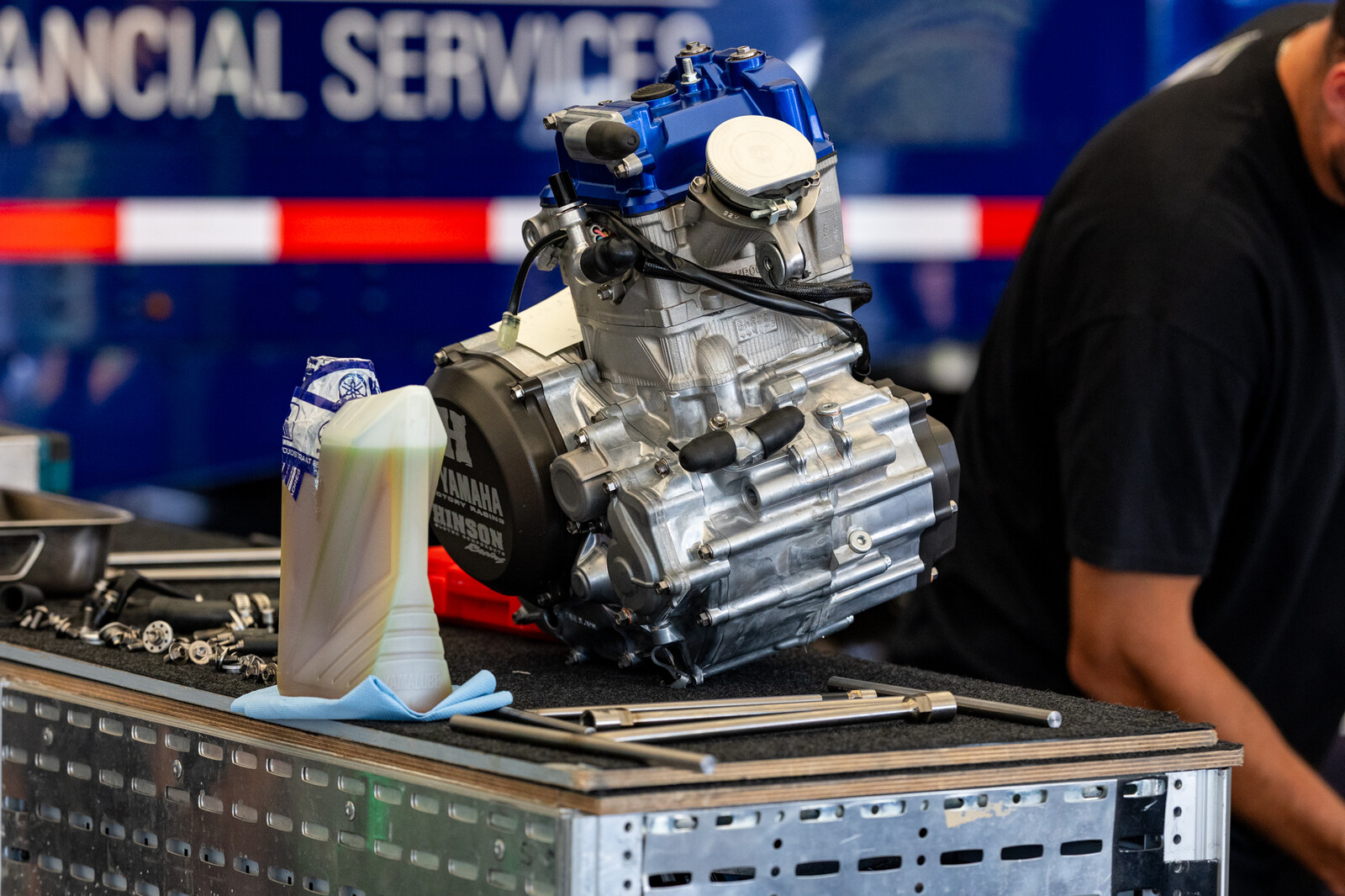 Engine spec has been a point of controversy and murmuring with Yamaha's MX2 and MXGP programs the past few years. After years of Rinaldi support, Star engines were brought into play for a couple of years and then pushed out, back in favor of Rinaldi. What they're on now, not quite sure, and we're curious to see how much of changes with Tim Gajser incoming for 2026.
Engine spec has been a point of controversy and murmuring with Yamaha's MX2 and MXGP programs the past few years. After years of Rinaldi support, Star engines were brought into play for a couple of years and then pushed out, back in favor of Rinaldi. What they're on now, not quite sure, and we're curious to see how much of changes with Tim Gajser incoming for 2026.
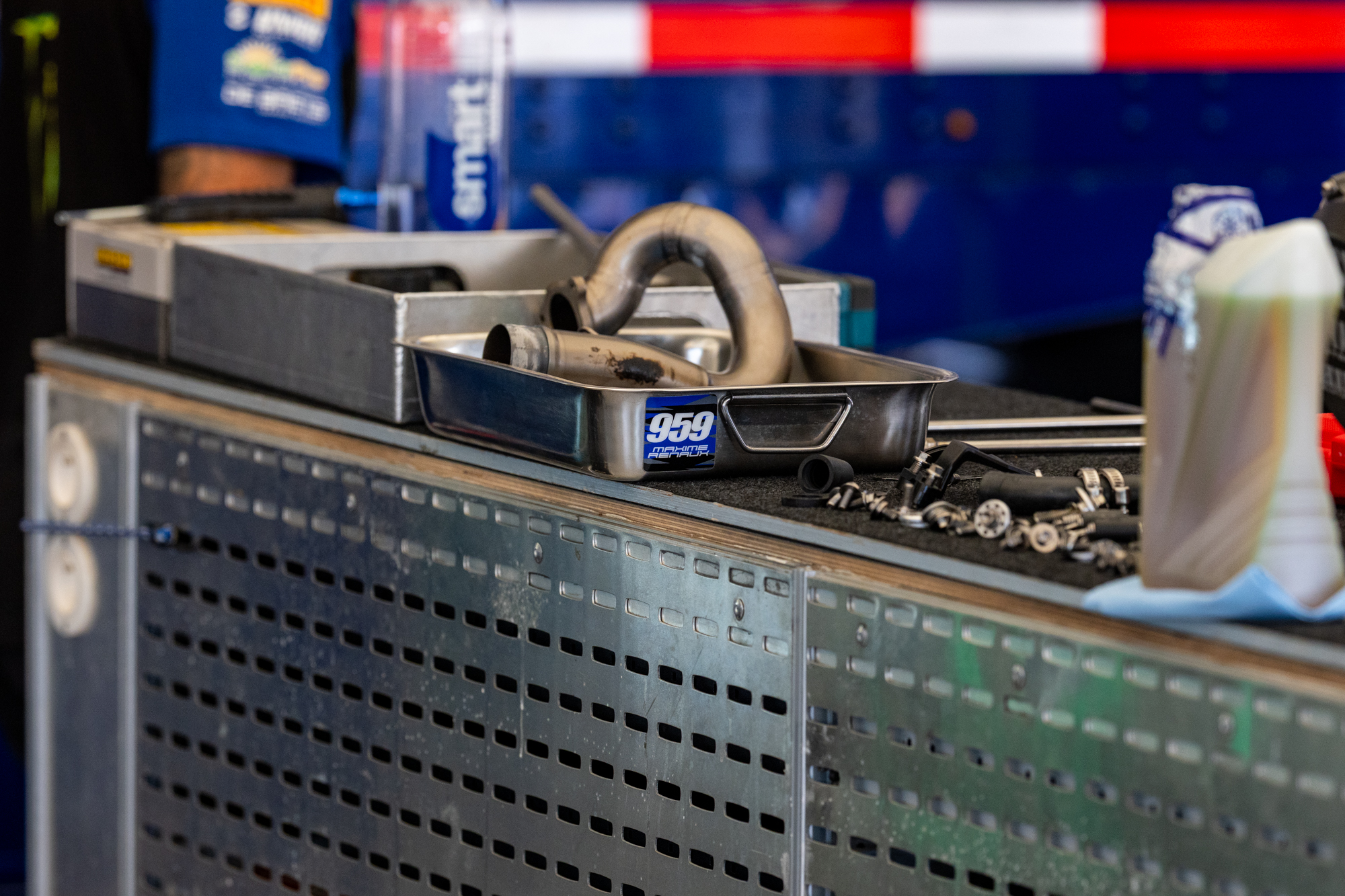
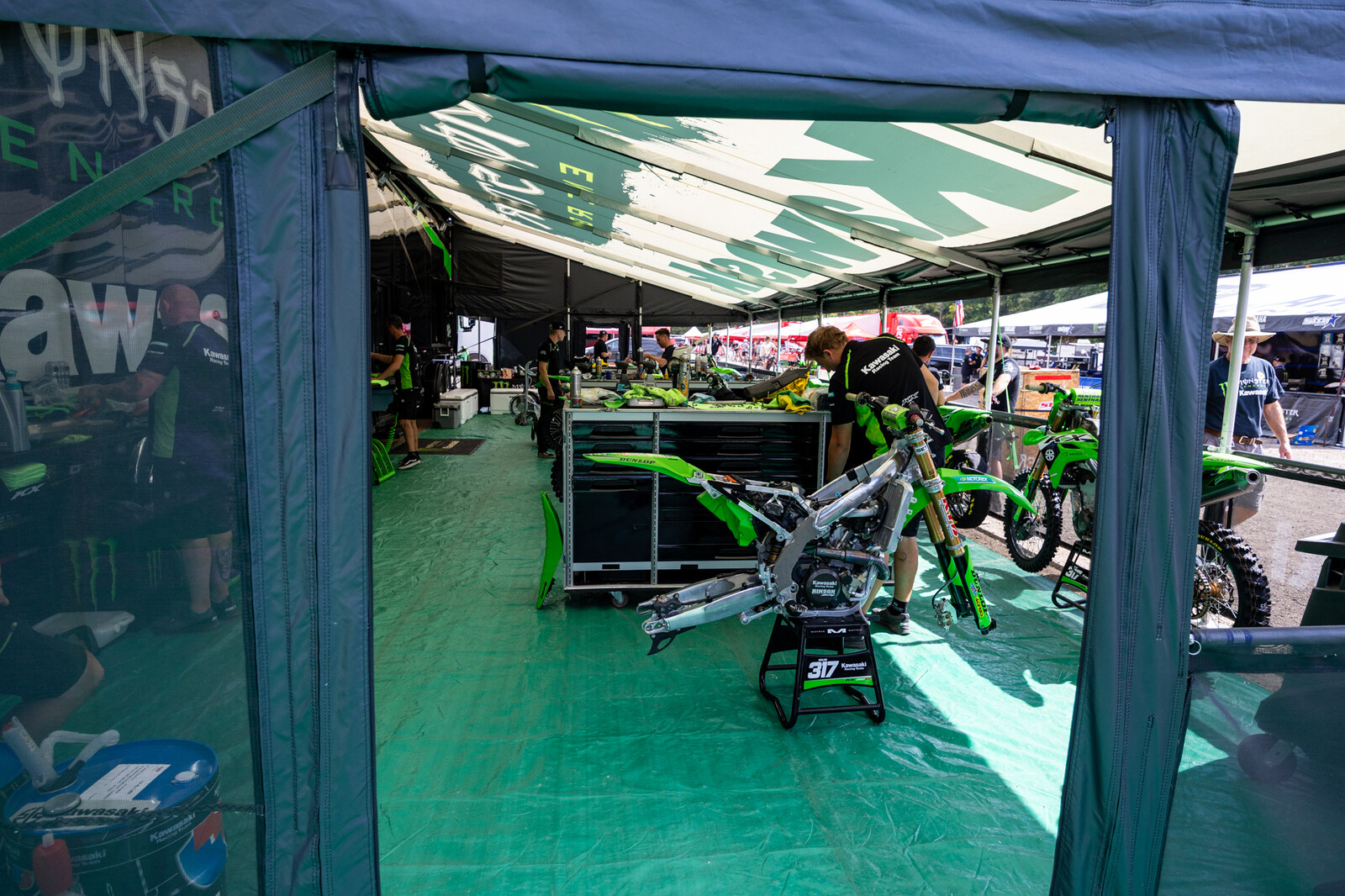 The Monster Energy Kawasaki team hosted the three bikes from the KRT MXGP effort, including Romain Febvre and Mathis Valin of Team France, along with Pauls Jonass for Team Latvia.
The Monster Energy Kawasaki team hosted the three bikes from the KRT MXGP effort, including Romain Febvre and Mathis Valin of Team France, along with Pauls Jonass for Team Latvia.
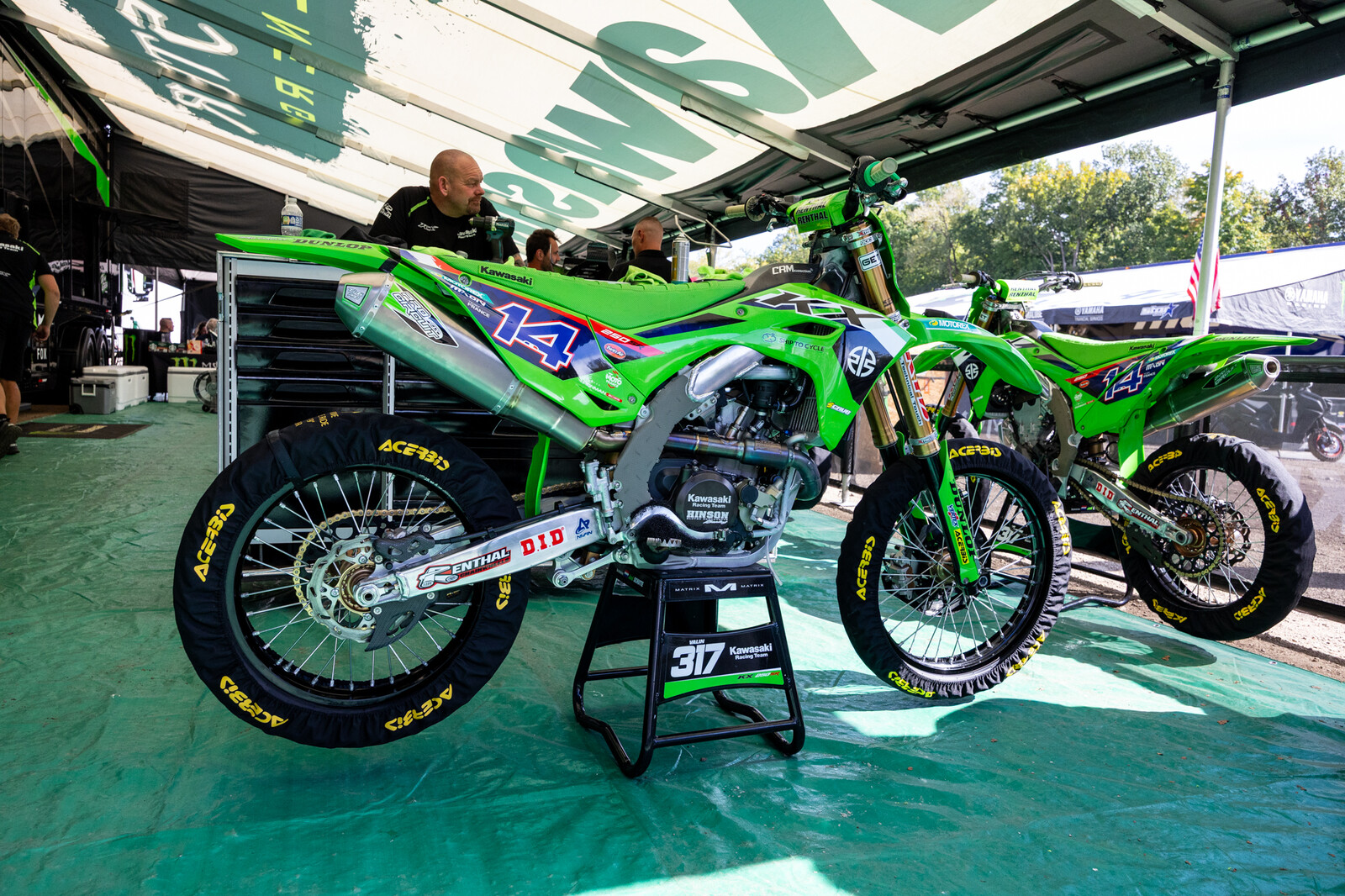 Mathis Valin's Kawasaki KX250SR was one we were excited to see, as it represents Kawasaki's first factory entry into the MX2 class in absolute ages...
Mathis Valin's Kawasaki KX250SR was one we were excited to see, as it represents Kawasaki's first factory entry into the MX2 class in absolute ages...
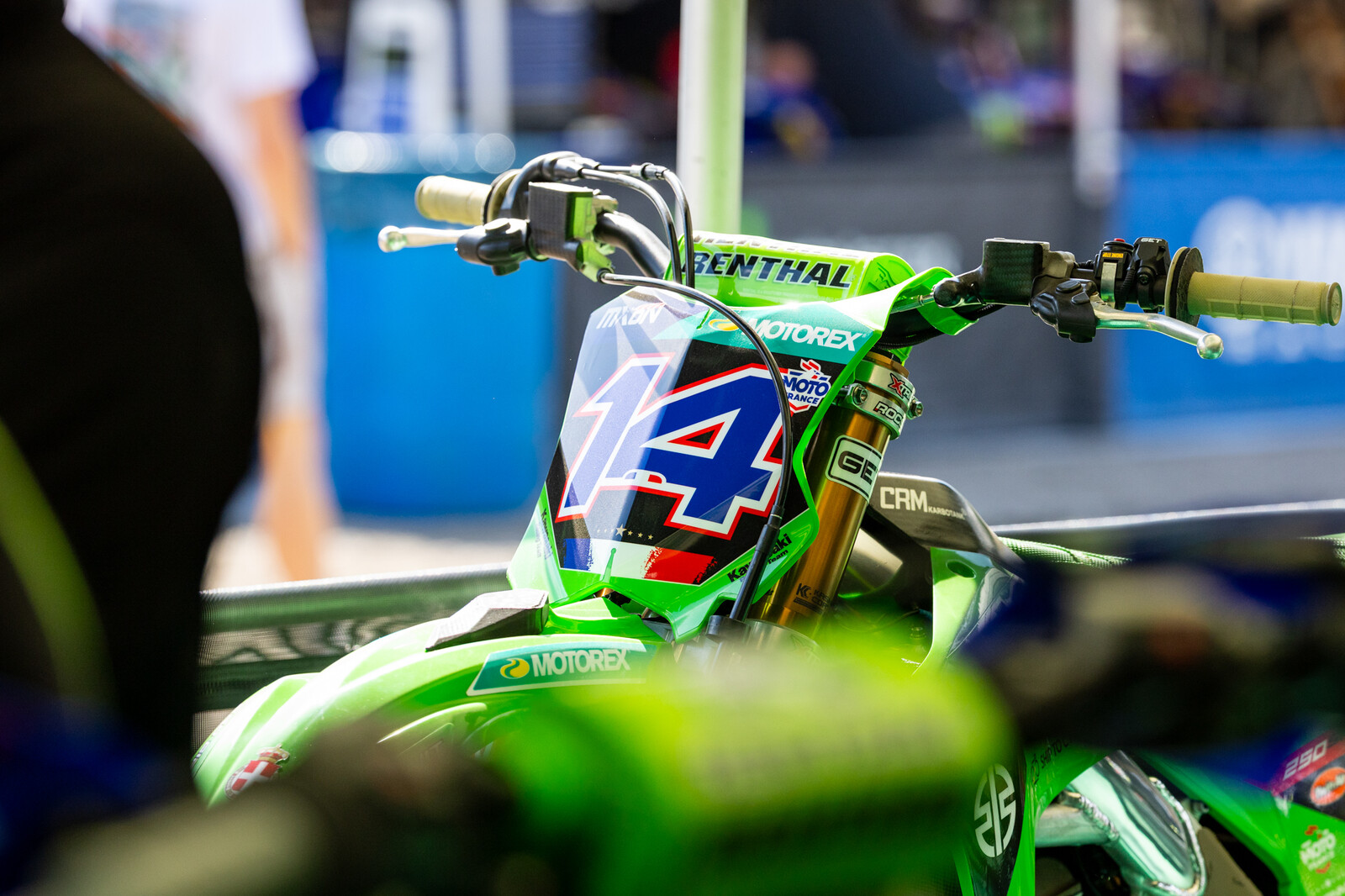
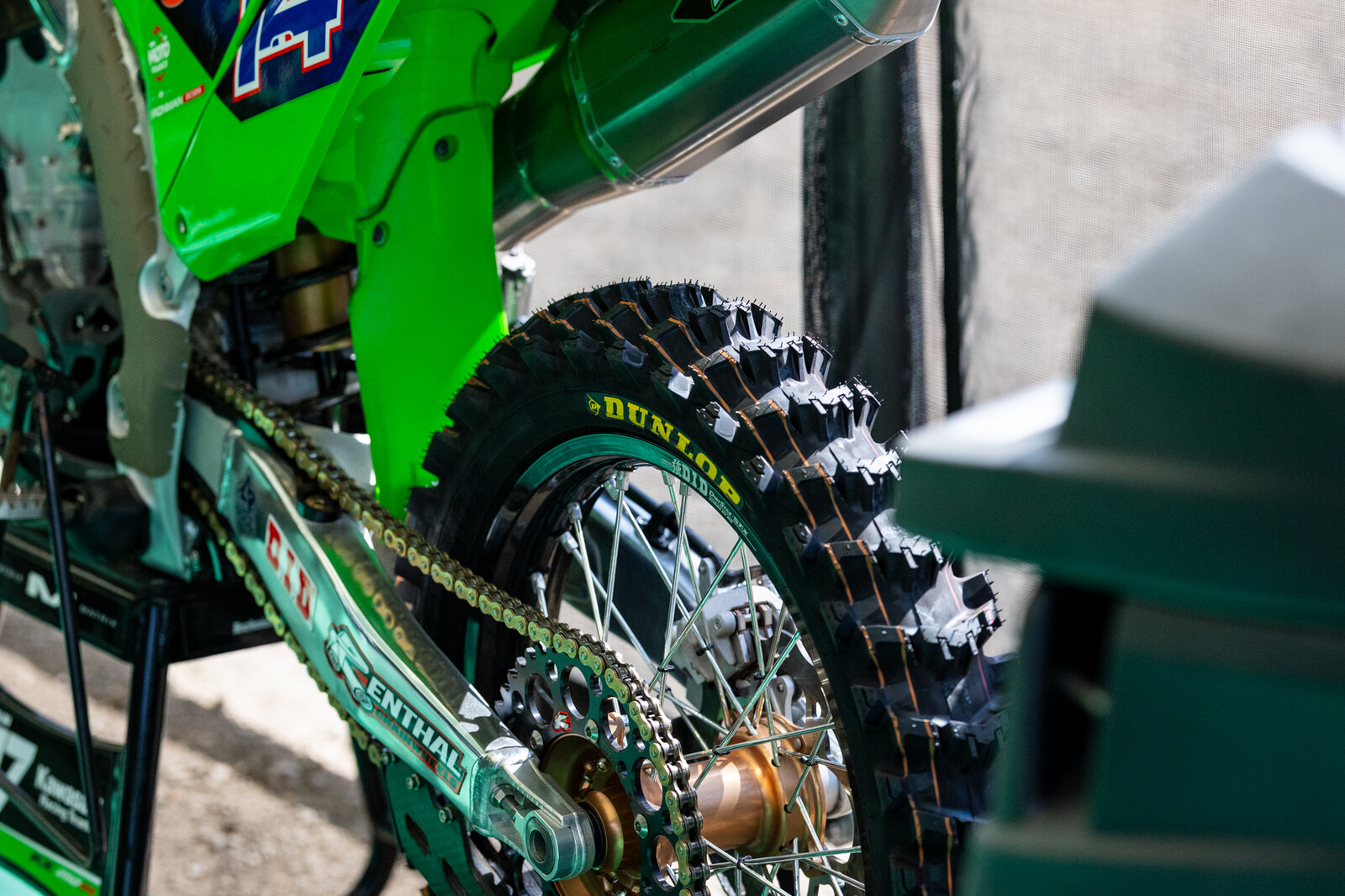 Dunlop nailed in their first MXGP premier class championship with Romain Febvre this year, following up on Kay de Wolf's title for the brand in MX2 in 2024.
Dunlop nailed in their first MXGP premier class championship with Romain Febvre this year, following up on Kay de Wolf's title for the brand in MX2 in 2024.
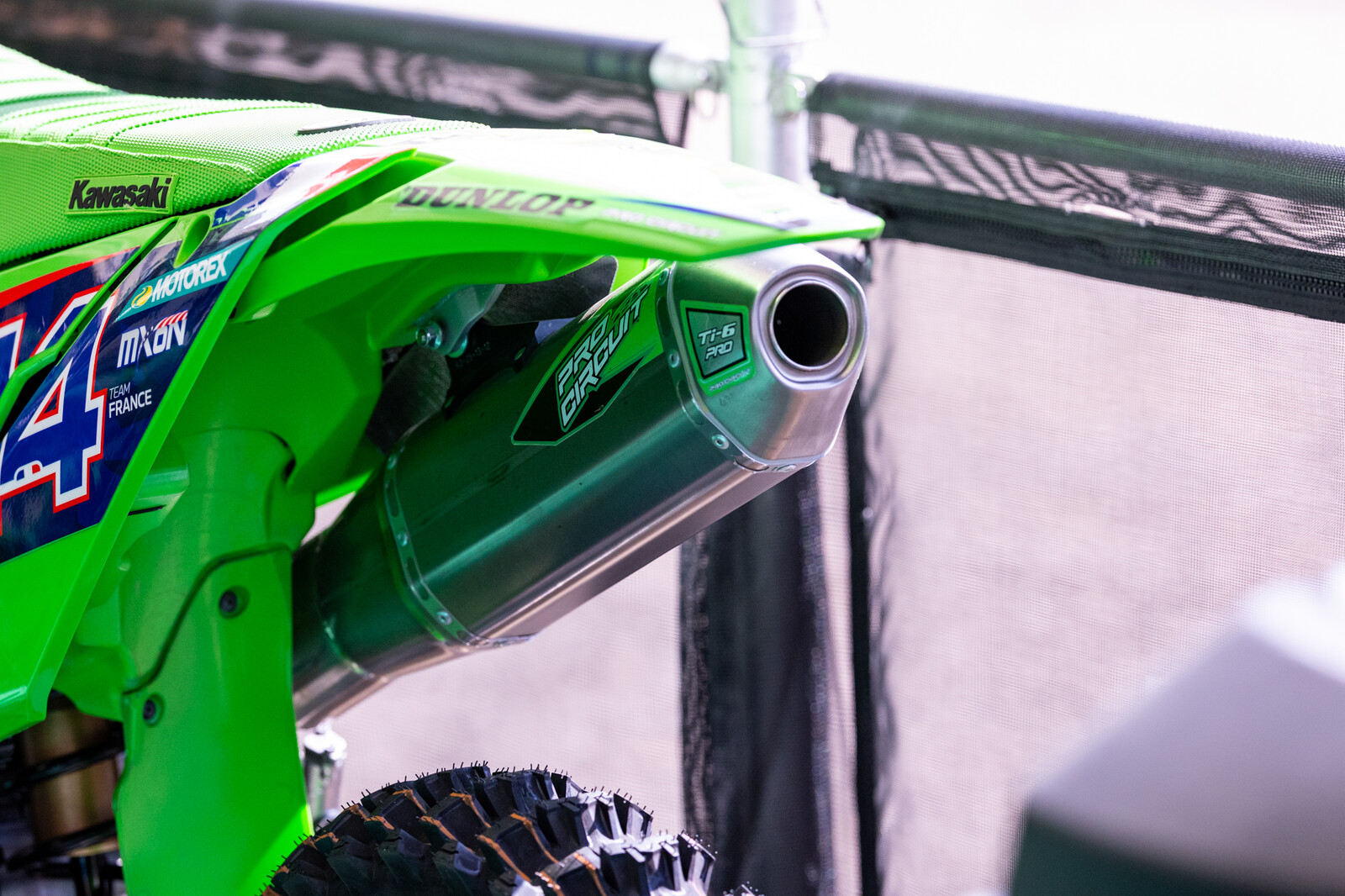 Pro Circuit's MXGP spec muffler.
Pro Circuit's MXGP spec muffler.
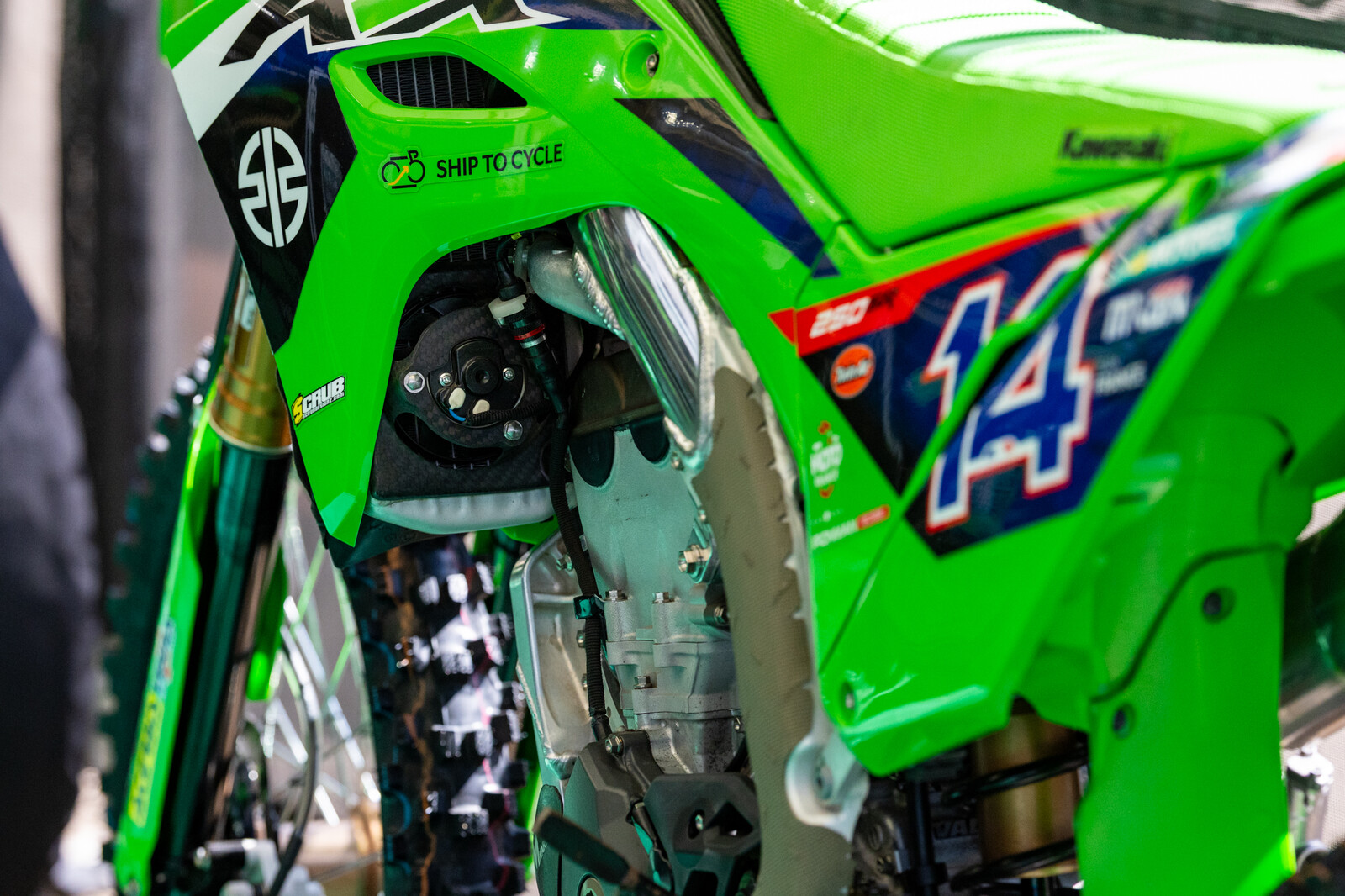 Radiator fan.
Radiator fan.
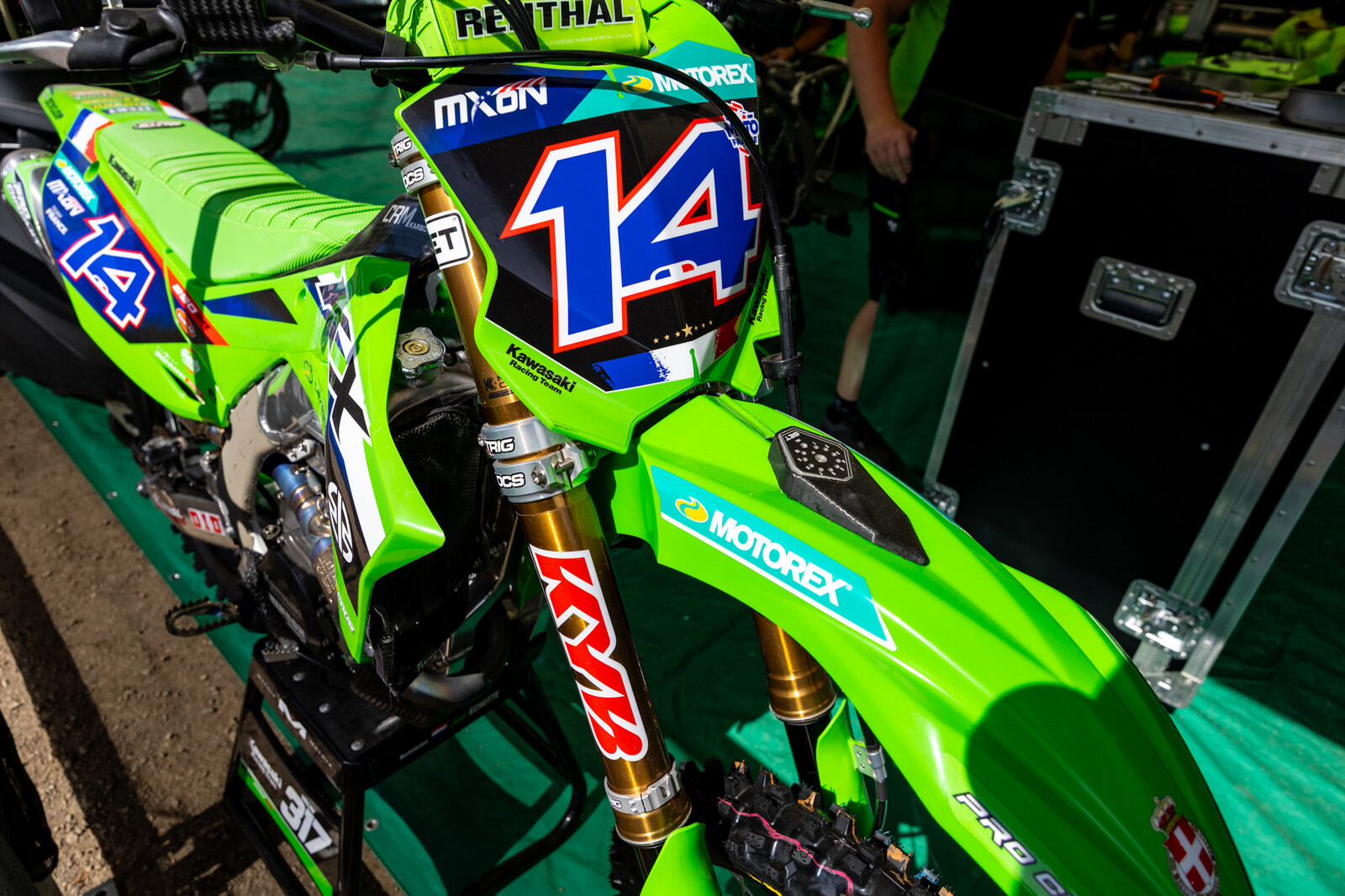 In prior seasons, Kawasaki's MXGP effort has always had one rider on Showa and one on KYB. With the inclusion of a 250 rider this year, both 450 riders were on Showa while the KYB duties were left to Valin on the 250.
In prior seasons, Kawasaki's MXGP effort has always had one rider on Showa and one on KYB. With the inclusion of a 250 rider this year, both 450 riders were on Showa while the KYB duties were left to Valin on the 250.
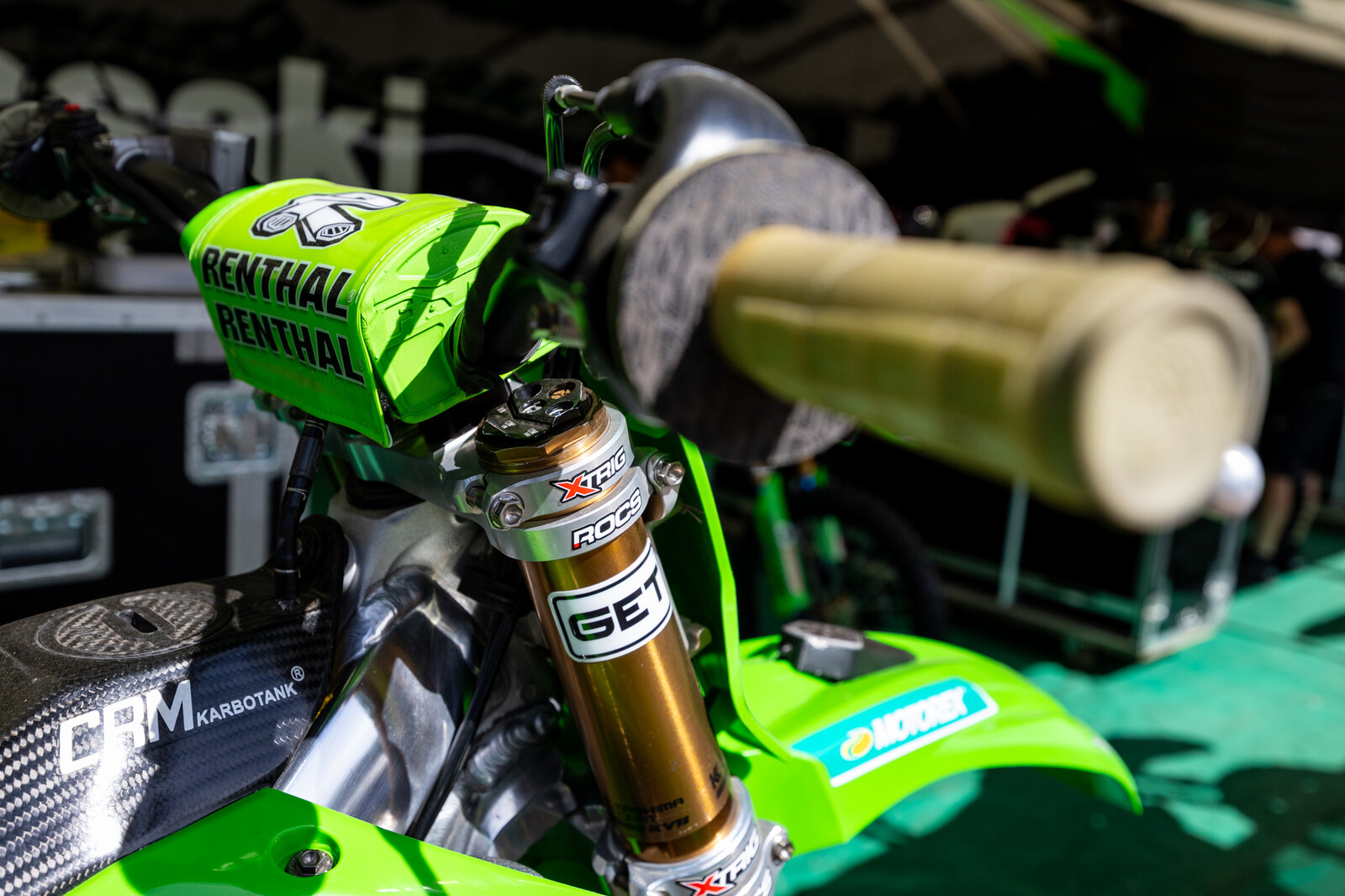 In the USA, these caps are usually associated with Star's 450 program and either an LSF or PSF1 works fork. However, in GPs they're a bit more common, and this set is a spring fork.
In the USA, these caps are usually associated with Star's 450 program and either an LSF or PSF1 works fork. However, in GPs they're a bit more common, and this set is a spring fork.
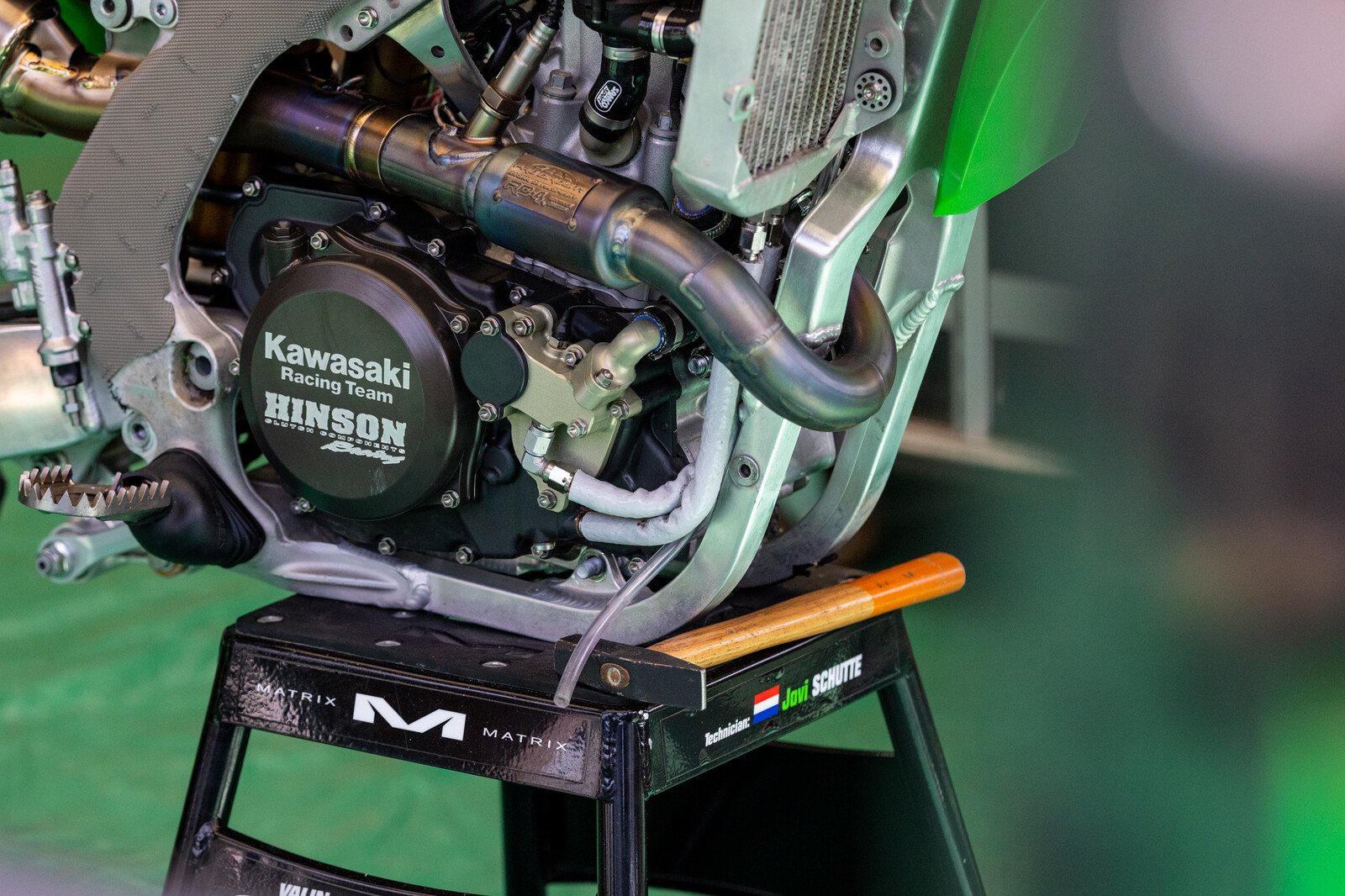 Little goody here, as Valin's KX250SR features a KRT works oil filter and water pump housing, featuring an oil temp sensor and oil lines. The feed line goes from the housing into the oil cooler/radiator area, then feeds back into the bottom end of the engine.
Little goody here, as Valin's KX250SR features a KRT works oil filter and water pump housing, featuring an oil temp sensor and oil lines. The feed line goes from the housing into the oil cooler/radiator area, then feeds back into the bottom end of the engine.
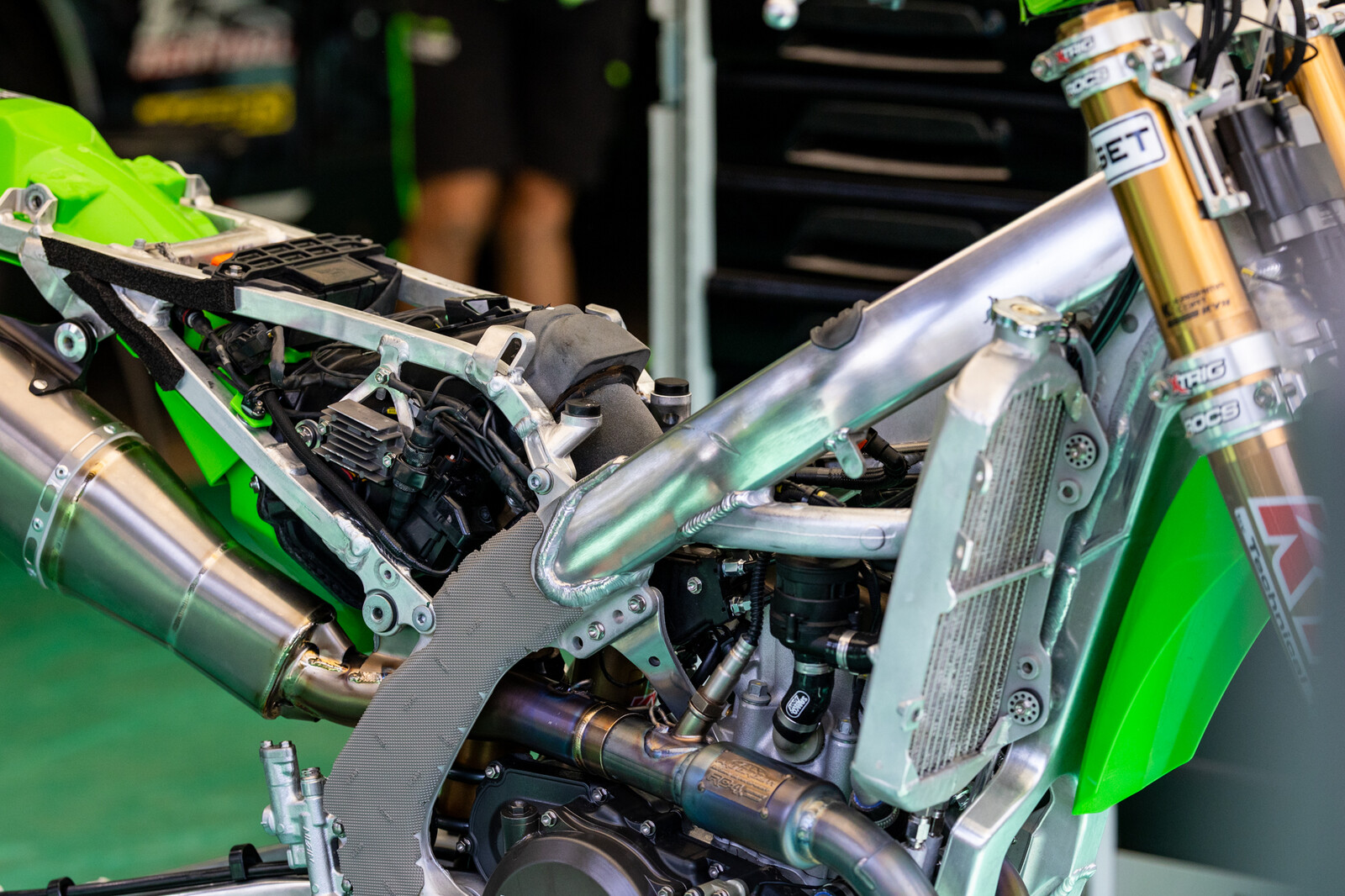 This is an area of the bike we wished we could've spent more time around. Since Kawasaki has moved to their latest airbox and intake system, it's been identified as a point where performance can be found. Clearly, the team has a wildly different airbox concept this year and a different intake tract. We have a filter side view from Febvre's bike that is quite unique, further down in this feature.
This is an area of the bike we wished we could've spent more time around. Since Kawasaki has moved to their latest airbox and intake system, it's been identified as a point where performance can be found. Clearly, the team has a wildly different airbox concept this year and a different intake tract. We have a filter side view from Febvre's bike that is quite unique, further down in this feature.
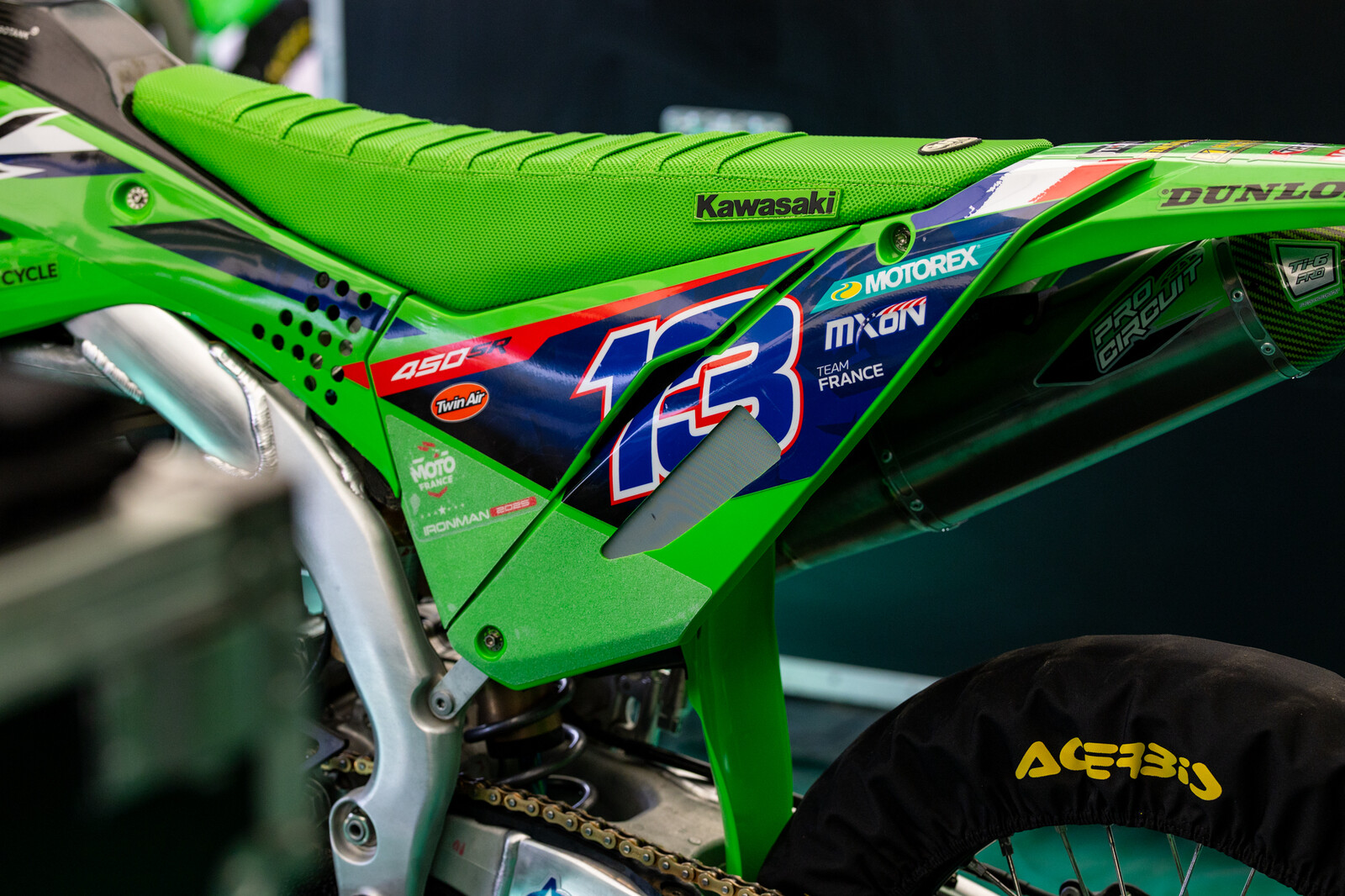 Where the PC team in the US utilizes an airbox cover that has a cutout to mimic the 2024 bike and the Factory 450 US team uses venting on the lid to feed a works filter layout like their older models...the MXGP team has closed their's off even more and rerouted the feed to the intake through the back of the sideplate. The last two years, the MXGP team used the filter and airbox layout that the US Kawi team now uses.
Where the PC team in the US utilizes an airbox cover that has a cutout to mimic the 2024 bike and the Factory 450 US team uses venting on the lid to feed a works filter layout like their older models...the MXGP team has closed their's off even more and rerouted the feed to the intake through the back of the sideplate. The last two years, the MXGP team used the filter and airbox layout that the US Kawi team now uses.
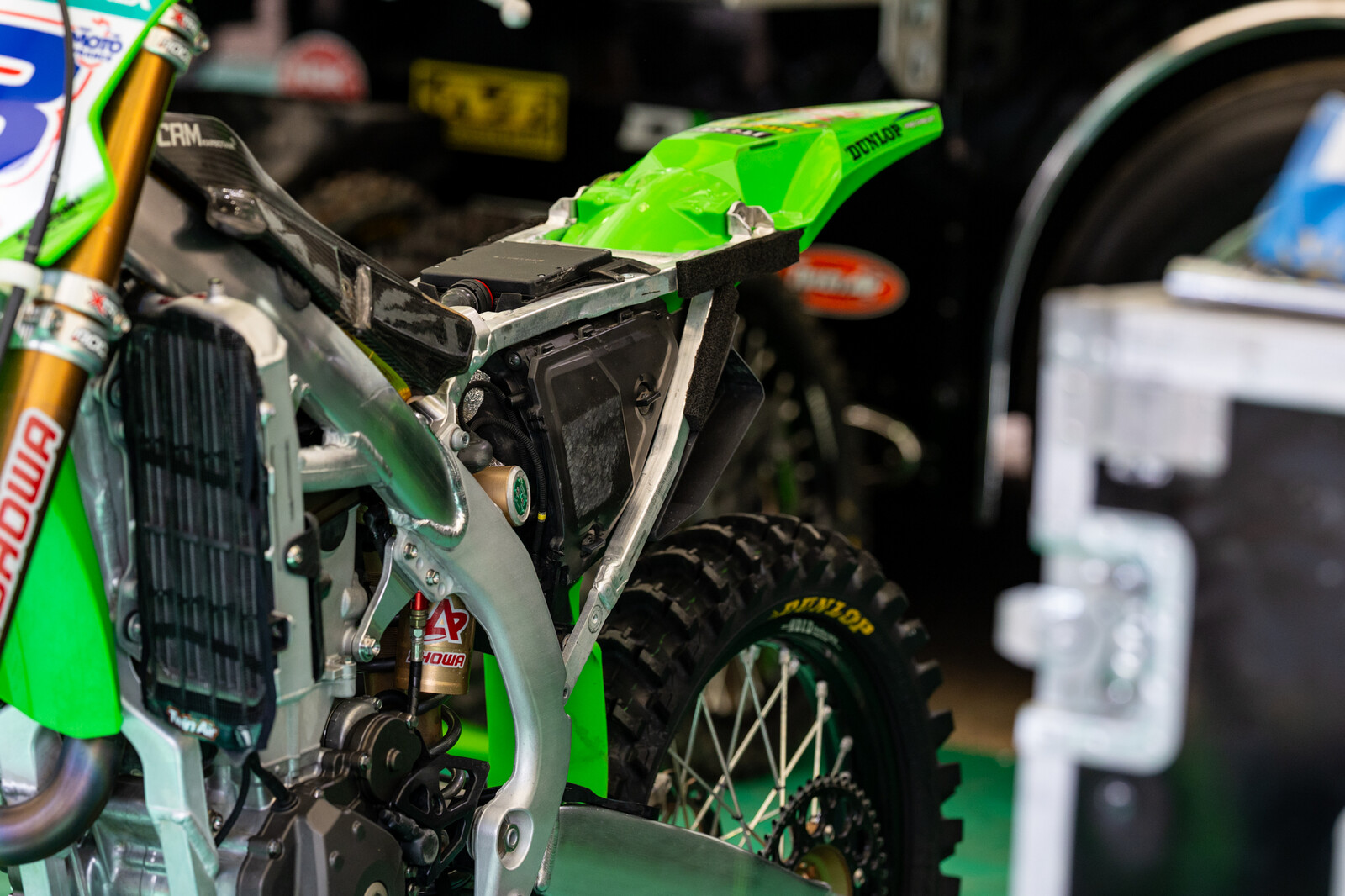 The filter area has now been closed off behind the movable door, with the intake being moved behind it.
The filter area has now been closed off behind the movable door, with the intake being moved behind it.
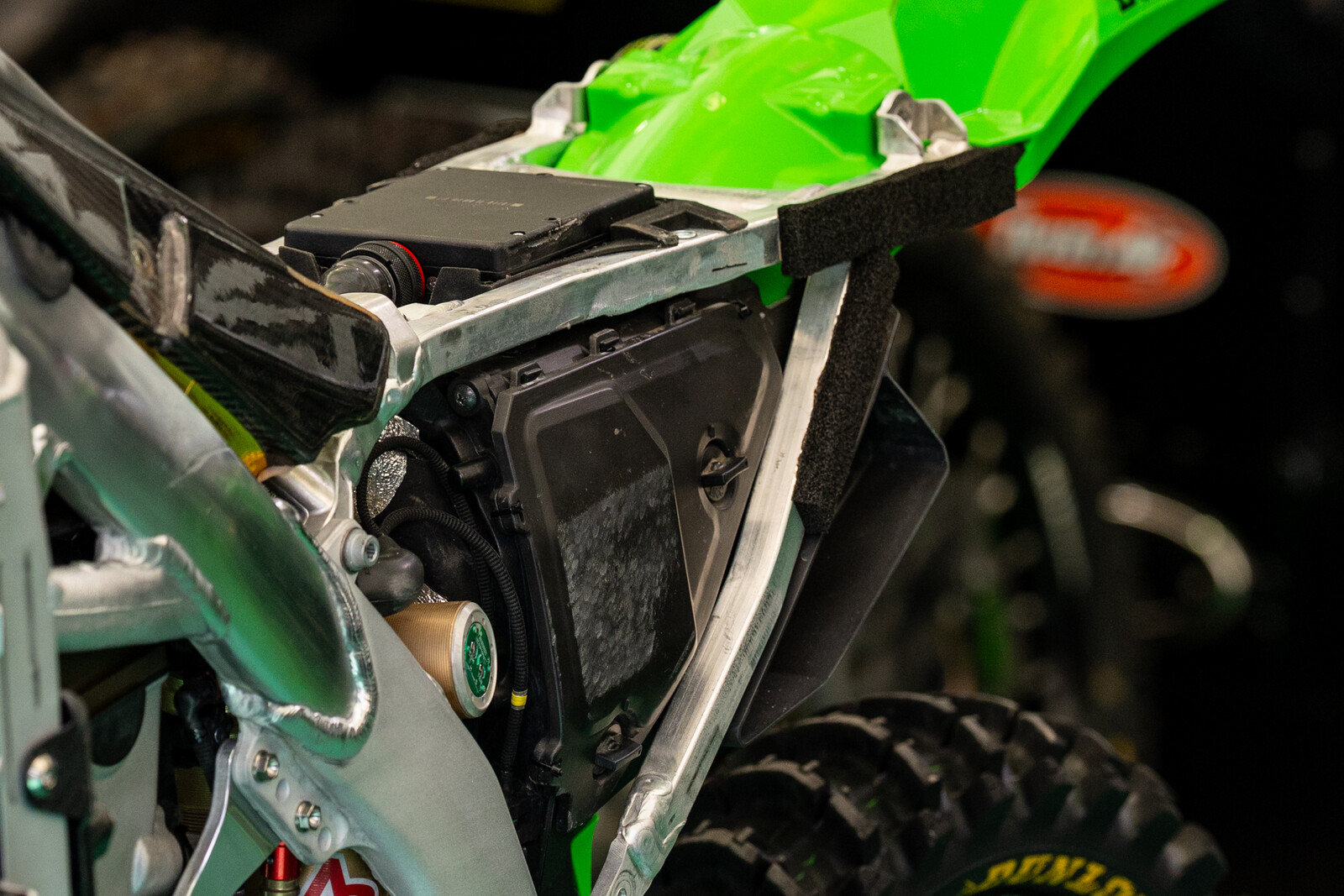 The intake scoop behind the subframe kind of reminds us of the route Honda went with their production airbox on the last generation CRF450R, when the filter was upside down in the airbox and the scoop fed it from below. The only logical reason we can come up with for this box design is that it was the best way to maintain power while meeting the new 109 dB sound test that was introduced into MXGP this year, down from 112 dB the year before.
The intake scoop behind the subframe kind of reminds us of the route Honda went with their production airbox on the last generation CRF450R, when the filter was upside down in the airbox and the scoop fed it from below. The only logical reason we can come up with for this box design is that it was the best way to maintain power while meeting the new 109 dB sound test that was introduced into MXGP this year, down from 112 dB the year before.
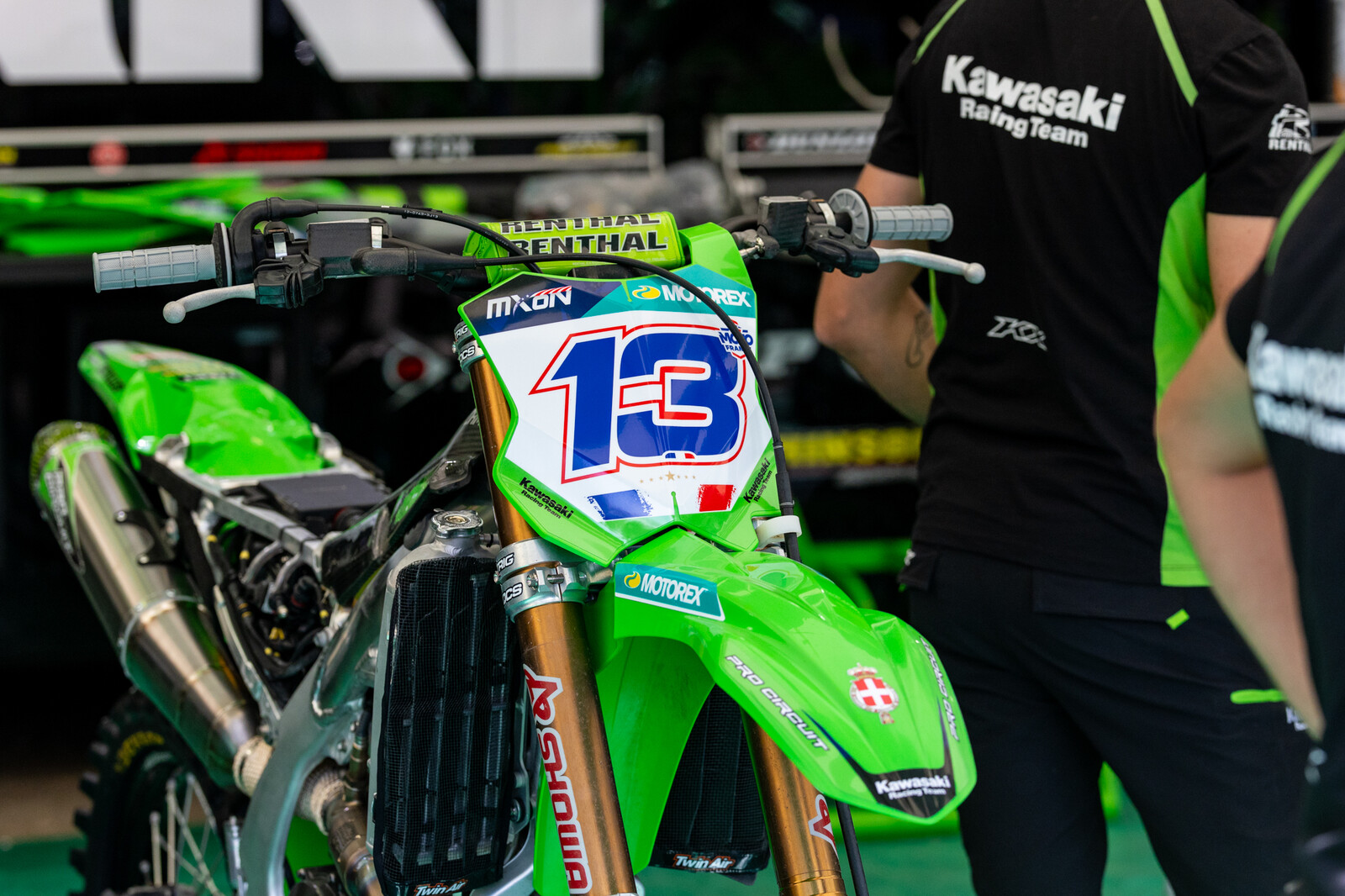 Romain Febvre's Factory Kawasaki KRT MXGP KX450SR.
Romain Febvre's Factory Kawasaki KRT MXGP KX450SR.
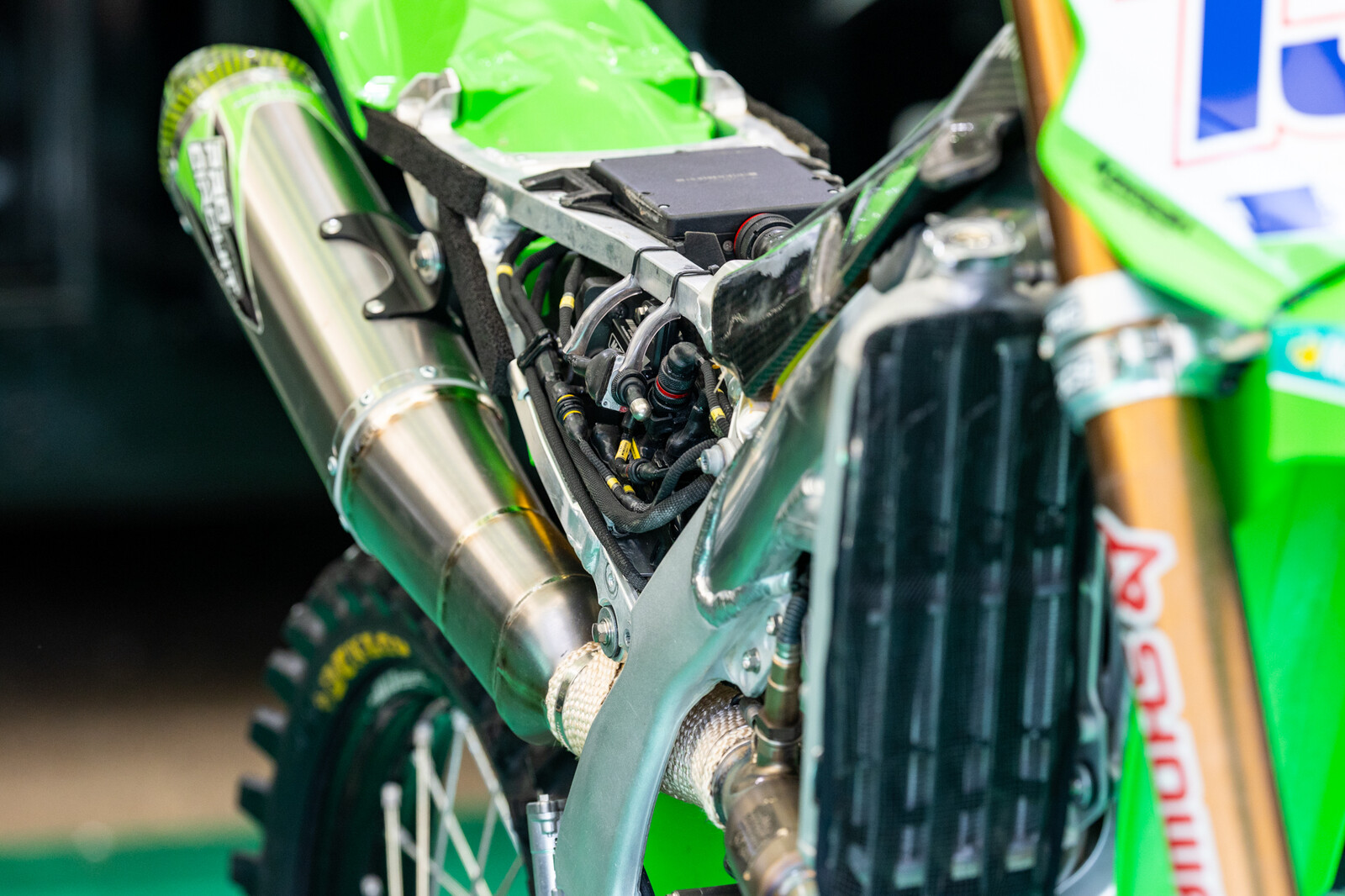 The "IceOne" Kawasaki team adopted the electronics from the prior KRT team (now Triumph MX2 program), by using Motec electronics and the biggest engine control module we've ever seen on a dirtbike. The weight that the system and all the wiring brings...
The "IceOne" Kawasaki team adopted the electronics from the prior KRT team (now Triumph MX2 program), by using Motec electronics and the biggest engine control module we've ever seen on a dirtbike. The weight that the system and all the wiring brings...
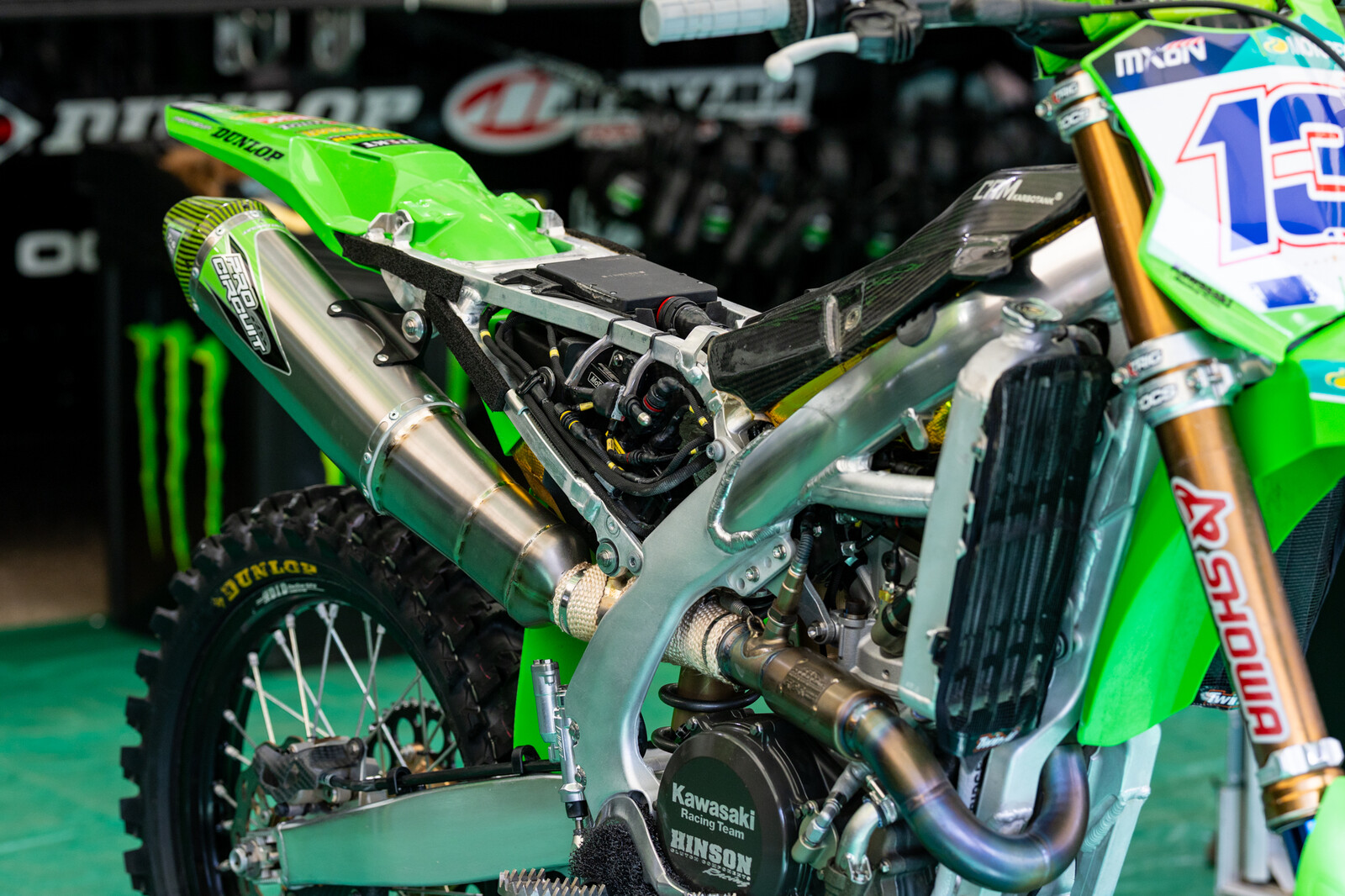 We believe the toggle switch is to power down all the data logging system and ECM on the bike, not to drain the battery...but we could be wrong there.
We believe the toggle switch is to power down all the data logging system and ECM on the bike, not to drain the battery...but we could be wrong there.
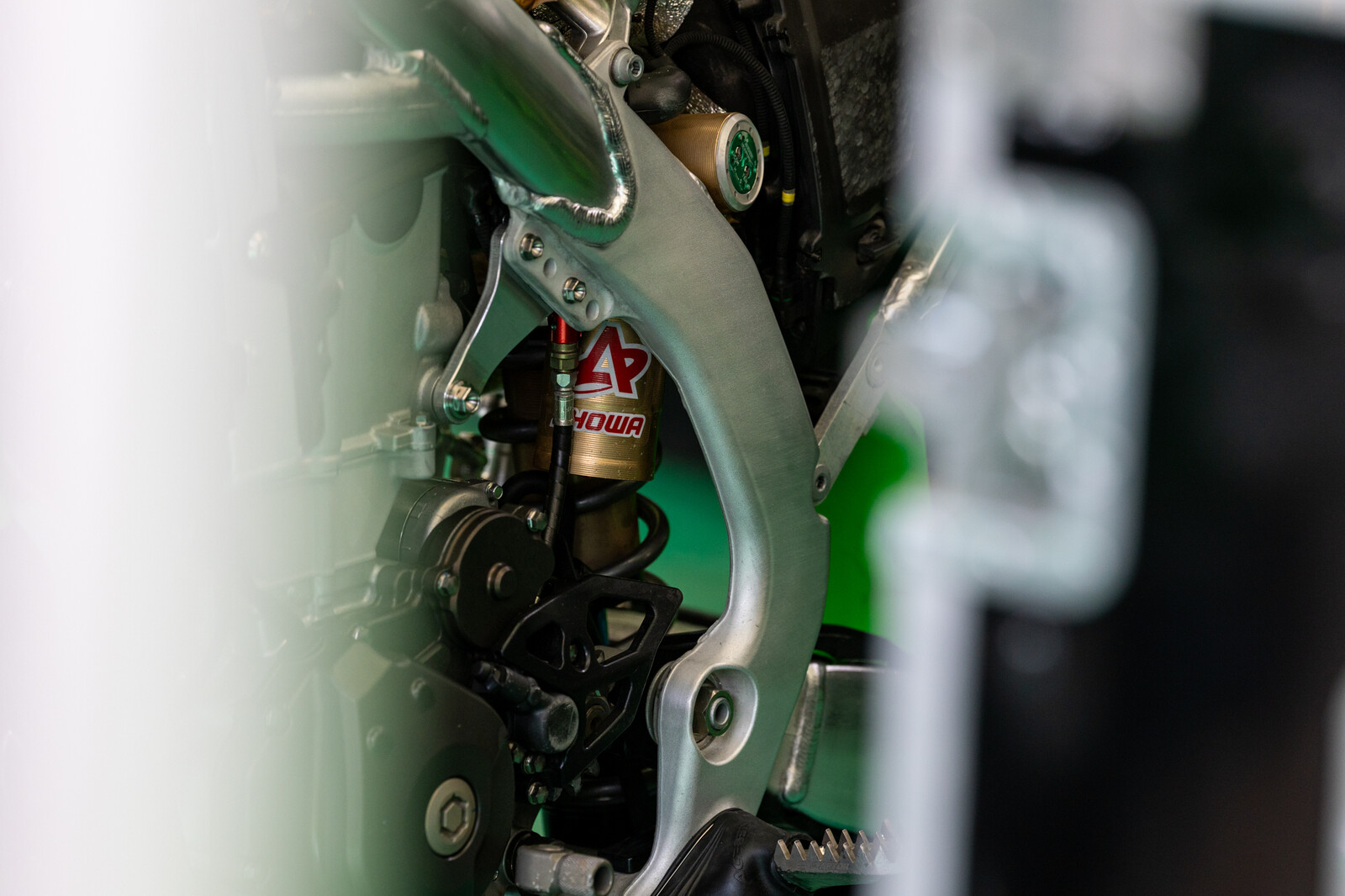 Also, the BFRC lives on! Romain Febvre still uses one aboard his KX450SR.
Also, the BFRC lives on! Romain Febvre still uses one aboard his KX450SR.
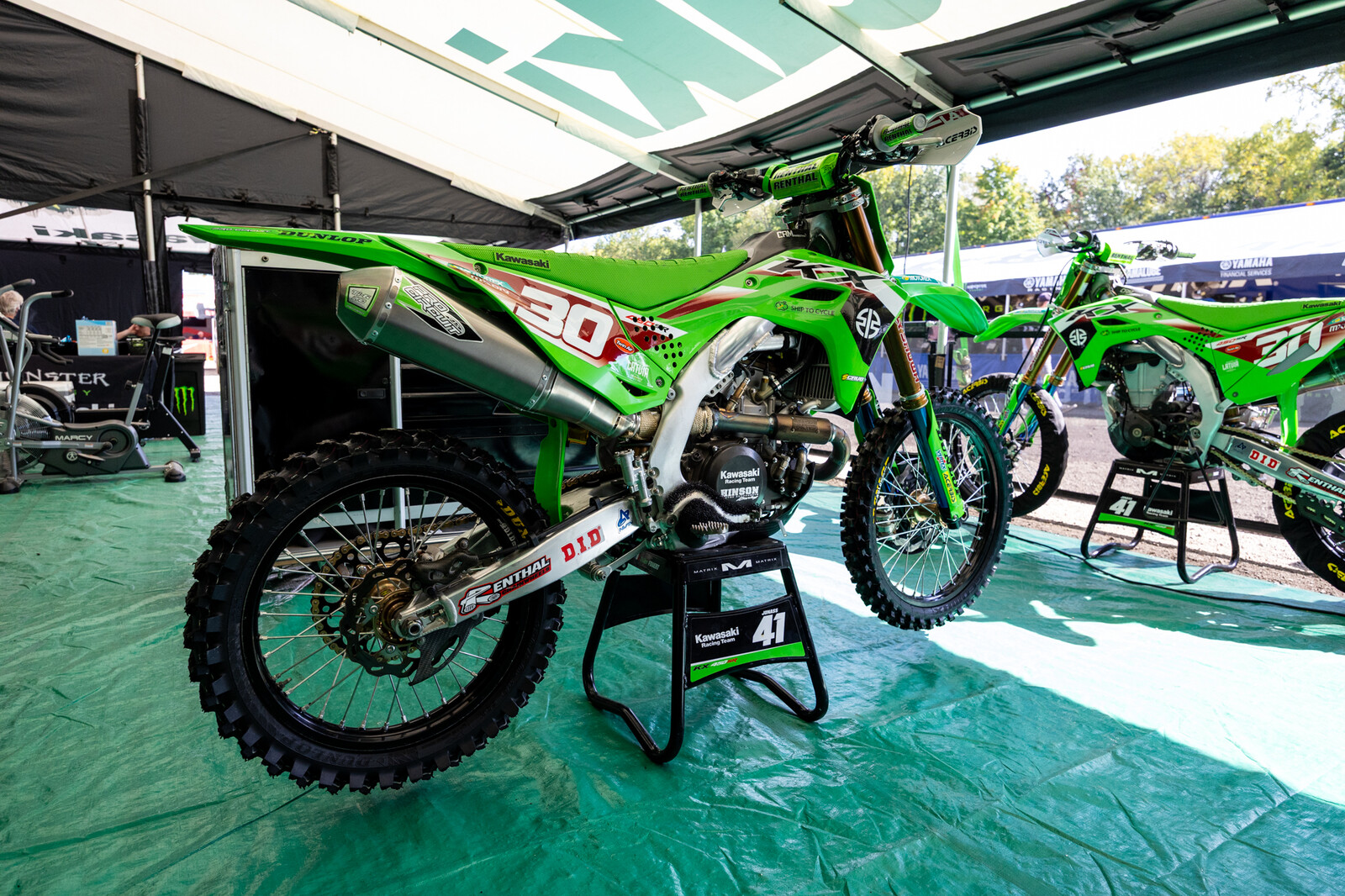 Pauls Jonass Kawasaki KX450SR.
Pauls Jonass Kawasaki KX450SR.
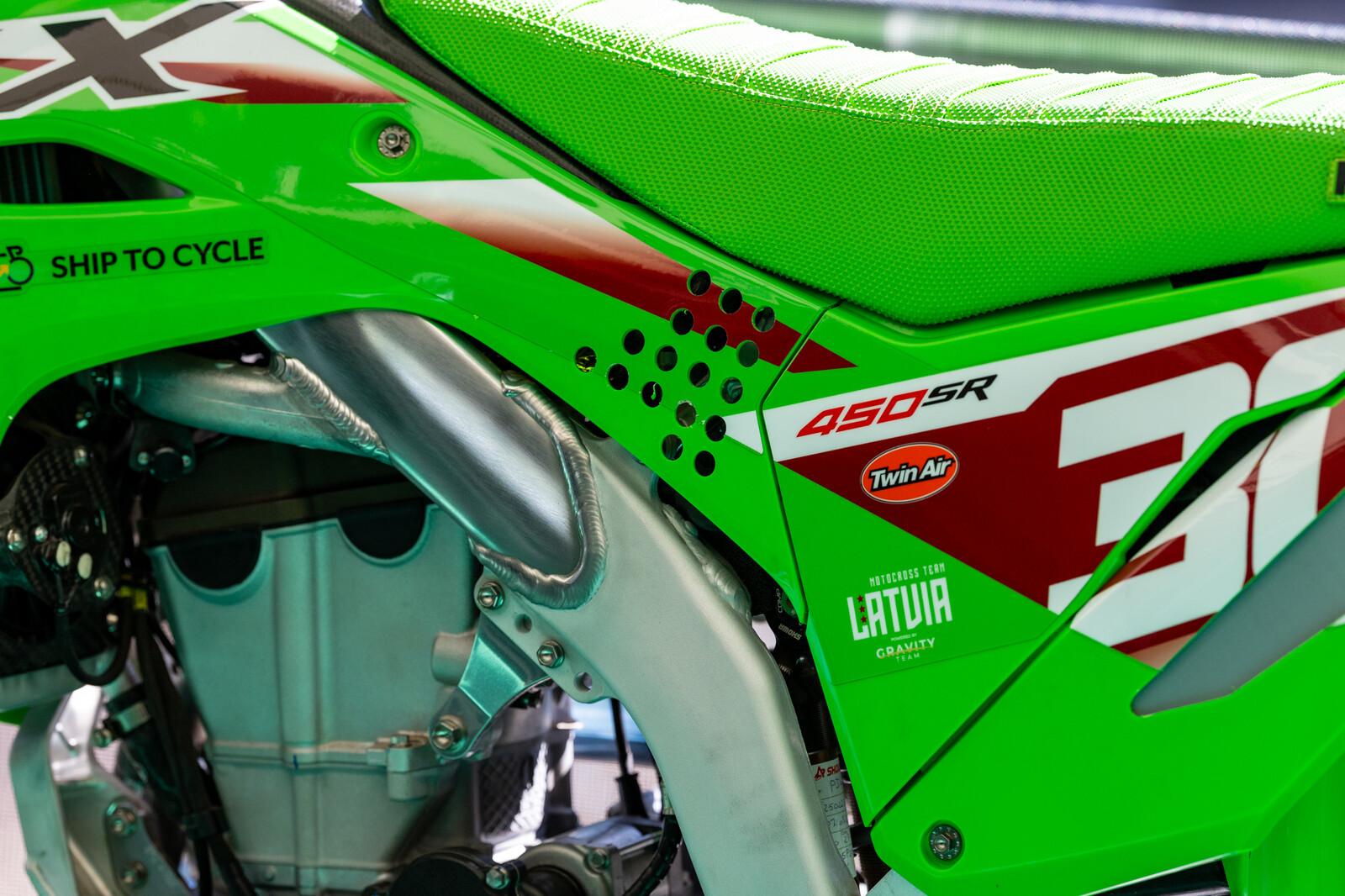 The drilled-out shroud here suggests to us that there is either one more small airbox feed near the front of the box, or they've added a bit of airflow here to feed the top of the airbox tray where the ECM and electronics lie.
The drilled-out shroud here suggests to us that there is either one more small airbox feed near the front of the box, or they've added a bit of airflow here to feed the top of the airbox tray where the ECM and electronics lie.
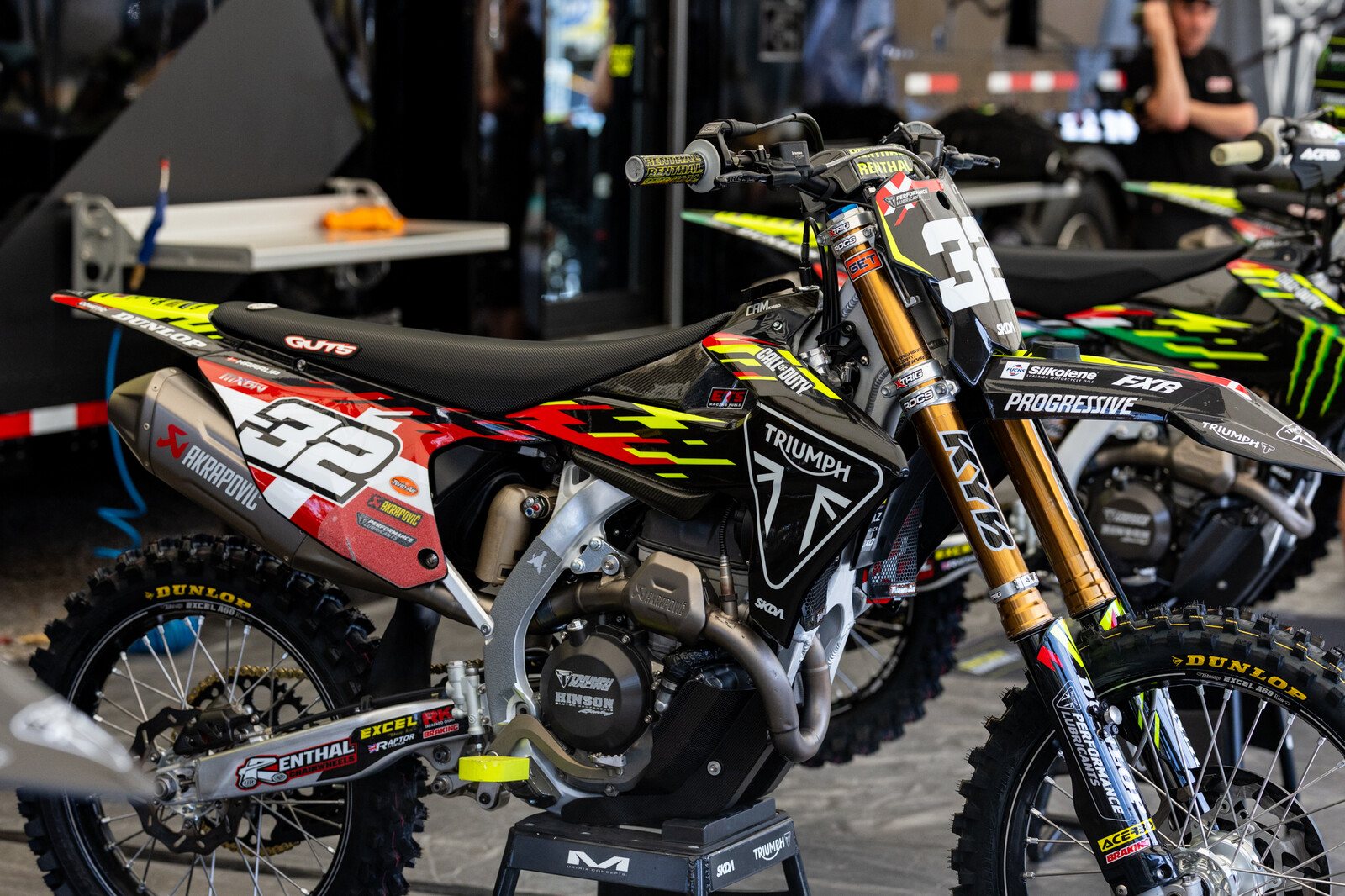 With Triumph having a rider from their US program and two from their MX2 program under the same tent, it was a good opportunity to see some of the external differences in their machines for each series. Mikkel Haarup's US spec bike pictured here.
With Triumph having a rider from their US program and two from their MX2 program under the same tent, it was a good opportunity to see some of the external differences in their machines for each series. Mikkel Haarup's US spec bike pictured here.
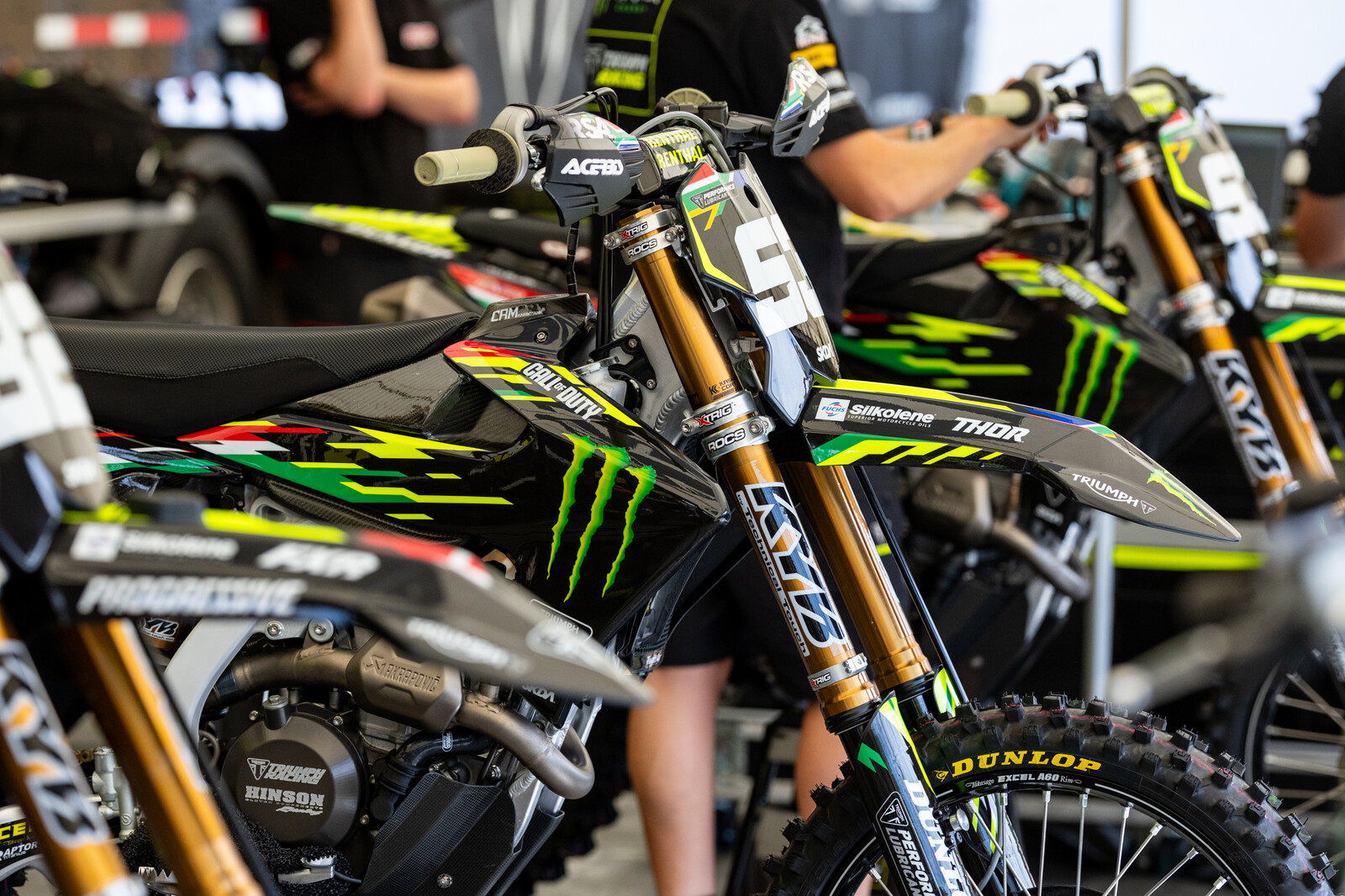 Camden McClellan's GP spec bike.
Camden McClellan's GP spec bike.
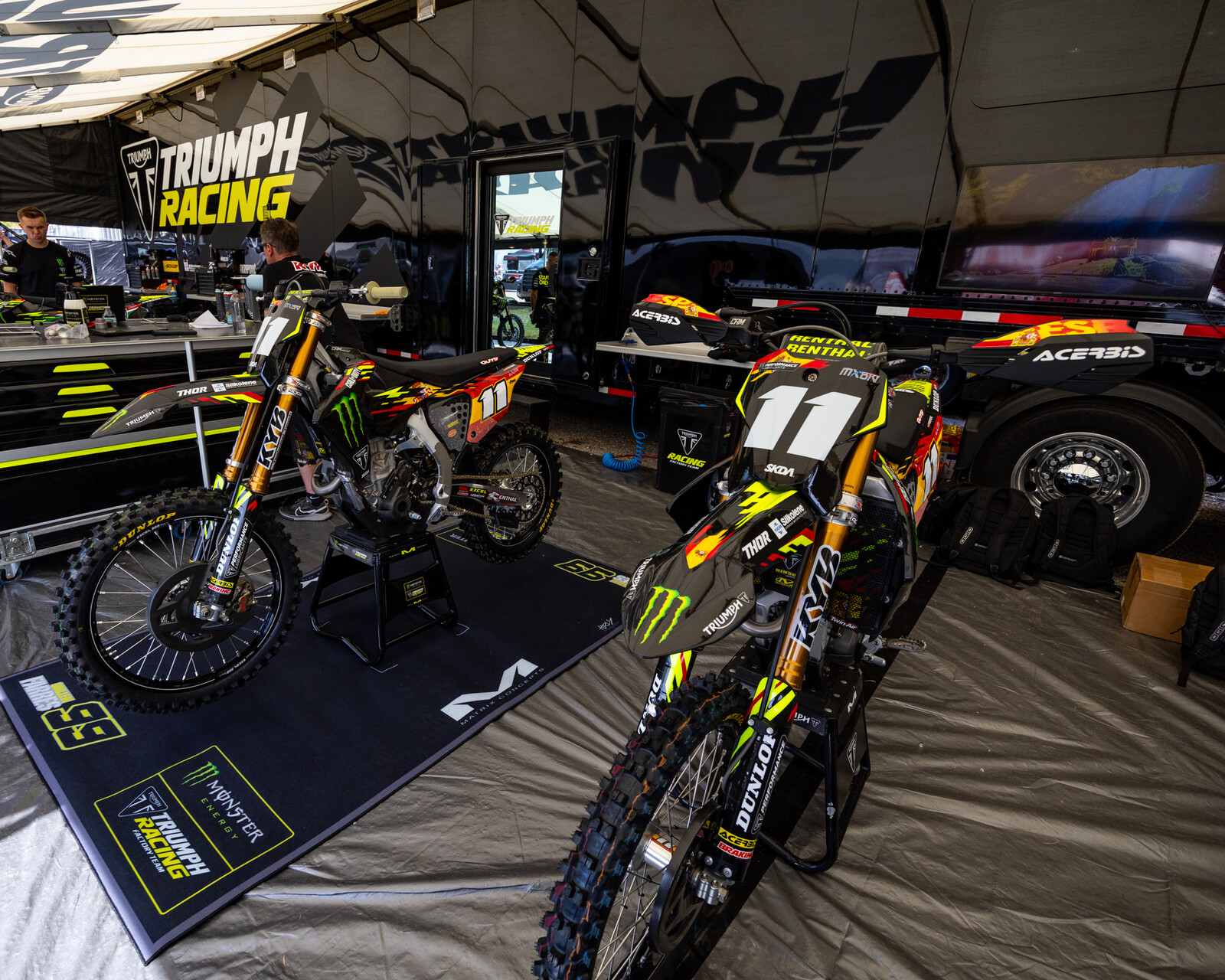 Along with Guillem Farres' GP spec bike.
Along with Guillem Farres' GP spec bike.
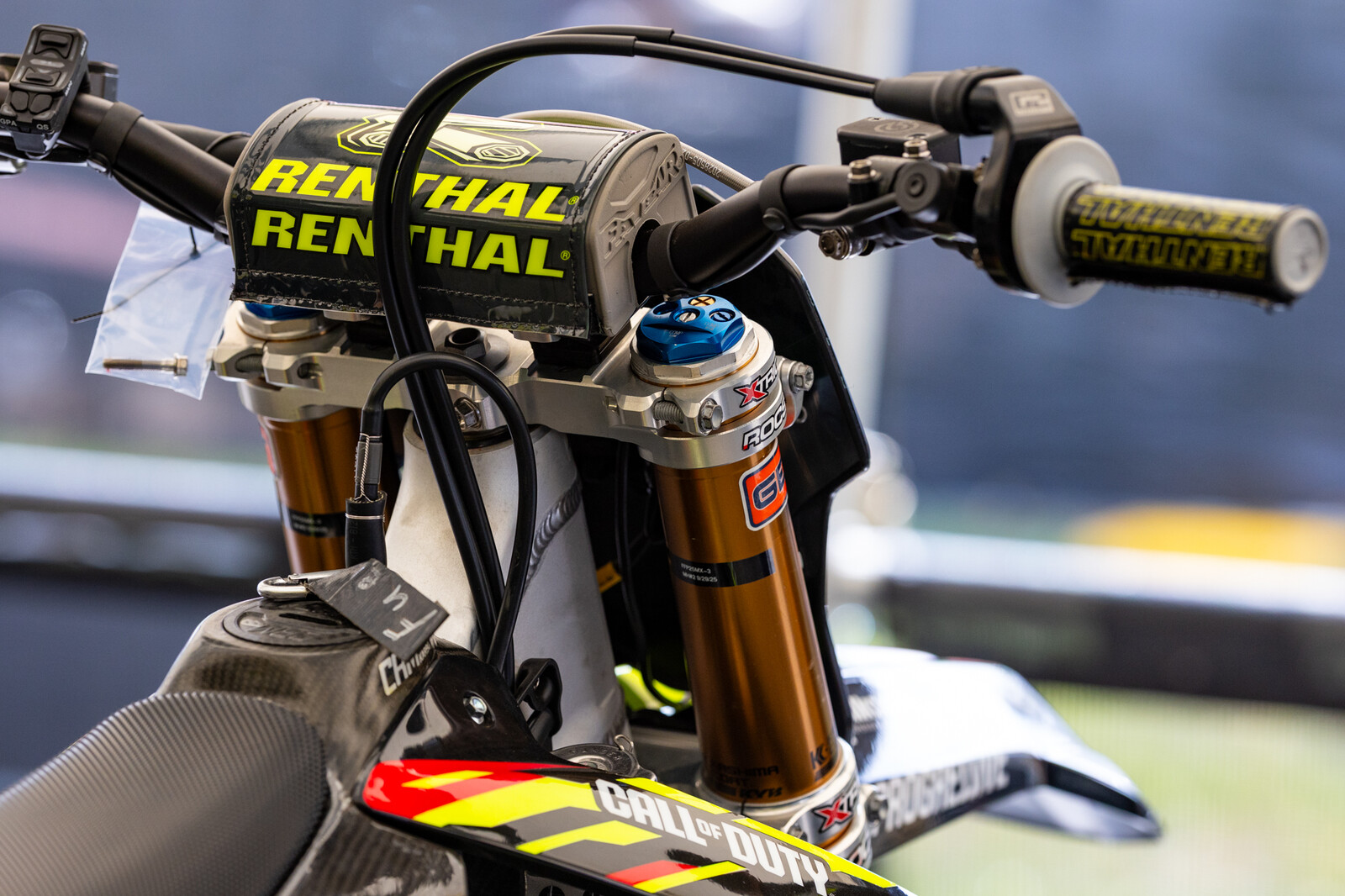 The US bike is running KYB PSF1 air forks, with the tuning done by the the team's in-house technician Drew Hopkins.
The US bike is running KYB PSF1 air forks, with the tuning done by the the team's in-house technician Drew Hopkins.
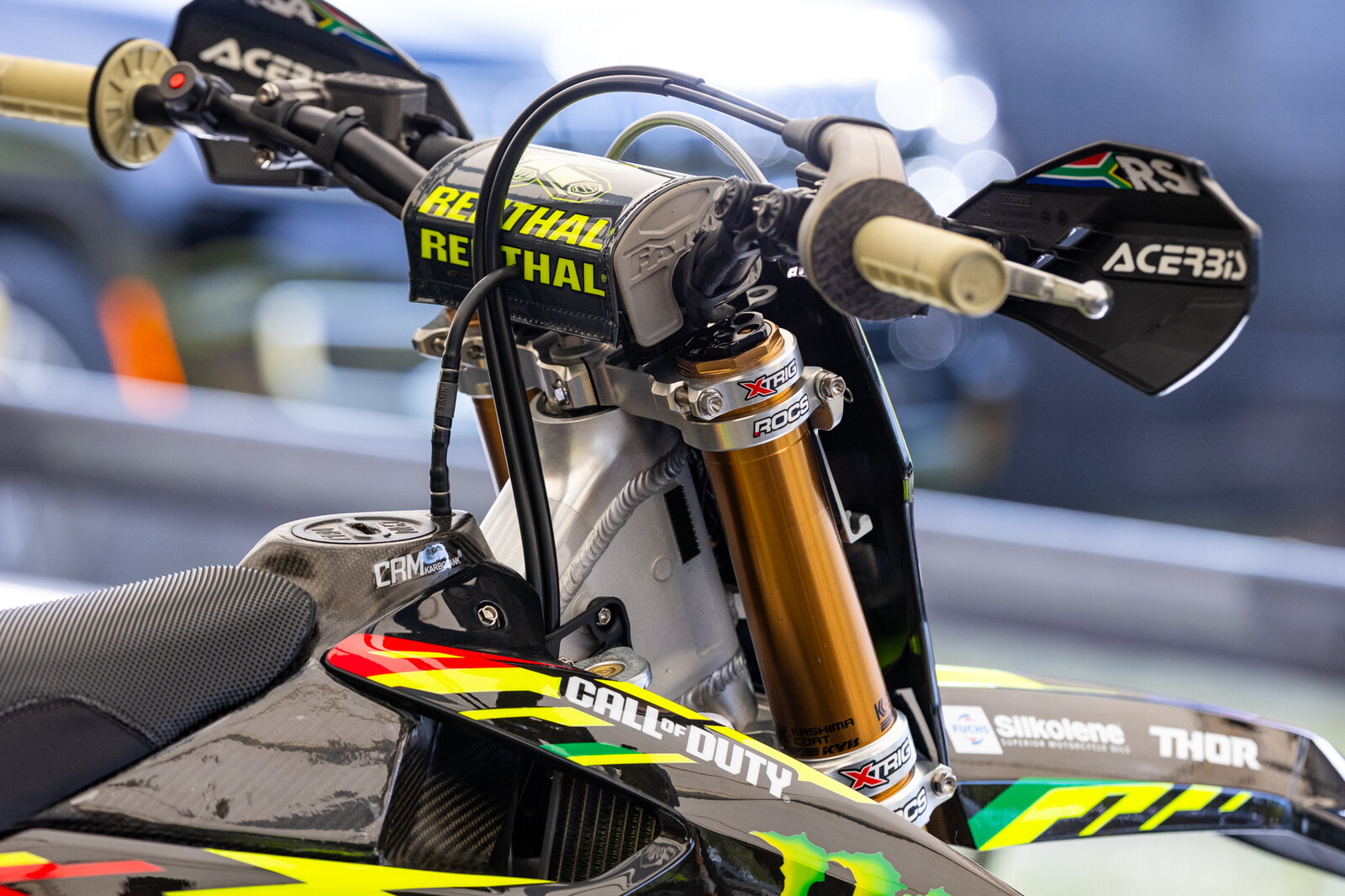 While the GP team uses spring forks, works triple adjuster caps, and the tuning is done by Technical Touch.
While the GP team uses spring forks, works triple adjuster caps, and the tuning is done by Technical Touch.
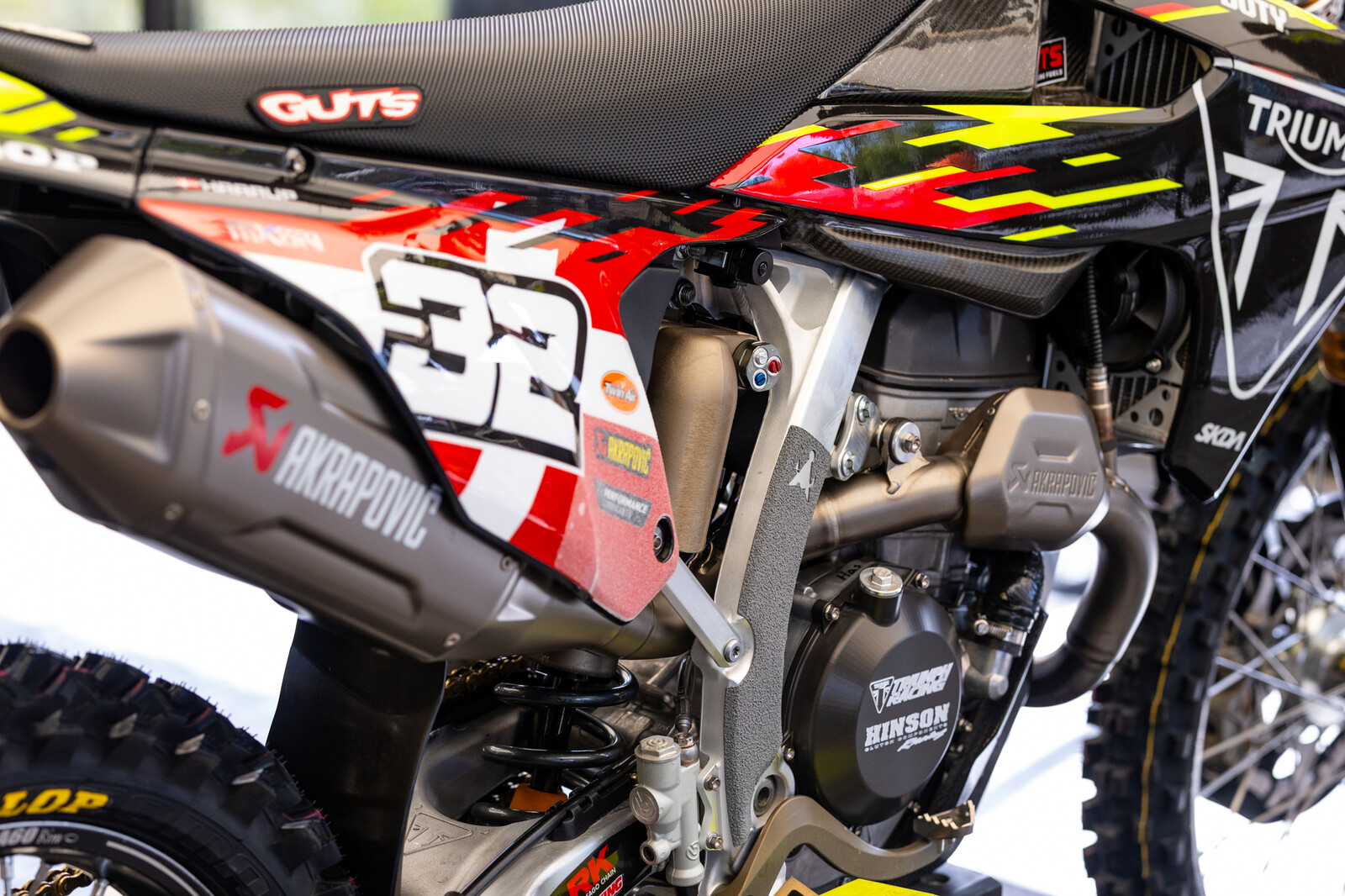 The US team uses a production shock body with a coated 18mm shaft.
The US team uses a production shock body with a coated 18mm shaft.
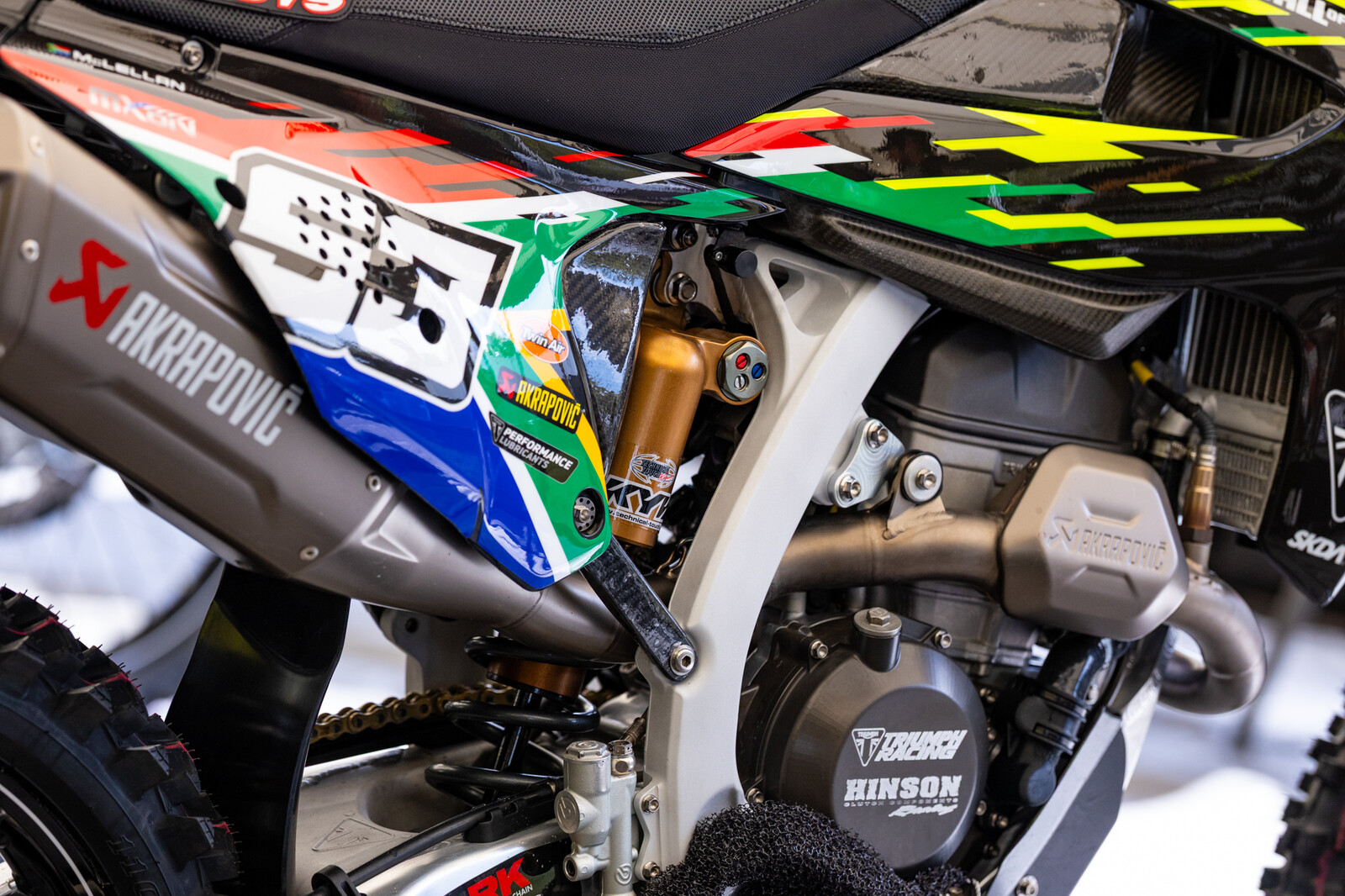 While the GP team uses a billet works KYB shock body with a larger compression adjuster. This shock would be legal in the US for the 450 class but not the 250 class due to homologation and cost.
While the GP team uses a billet works KYB shock body with a larger compression adjuster. This shock would be legal in the US for the 450 class but not the 250 class due to homologation and cost.
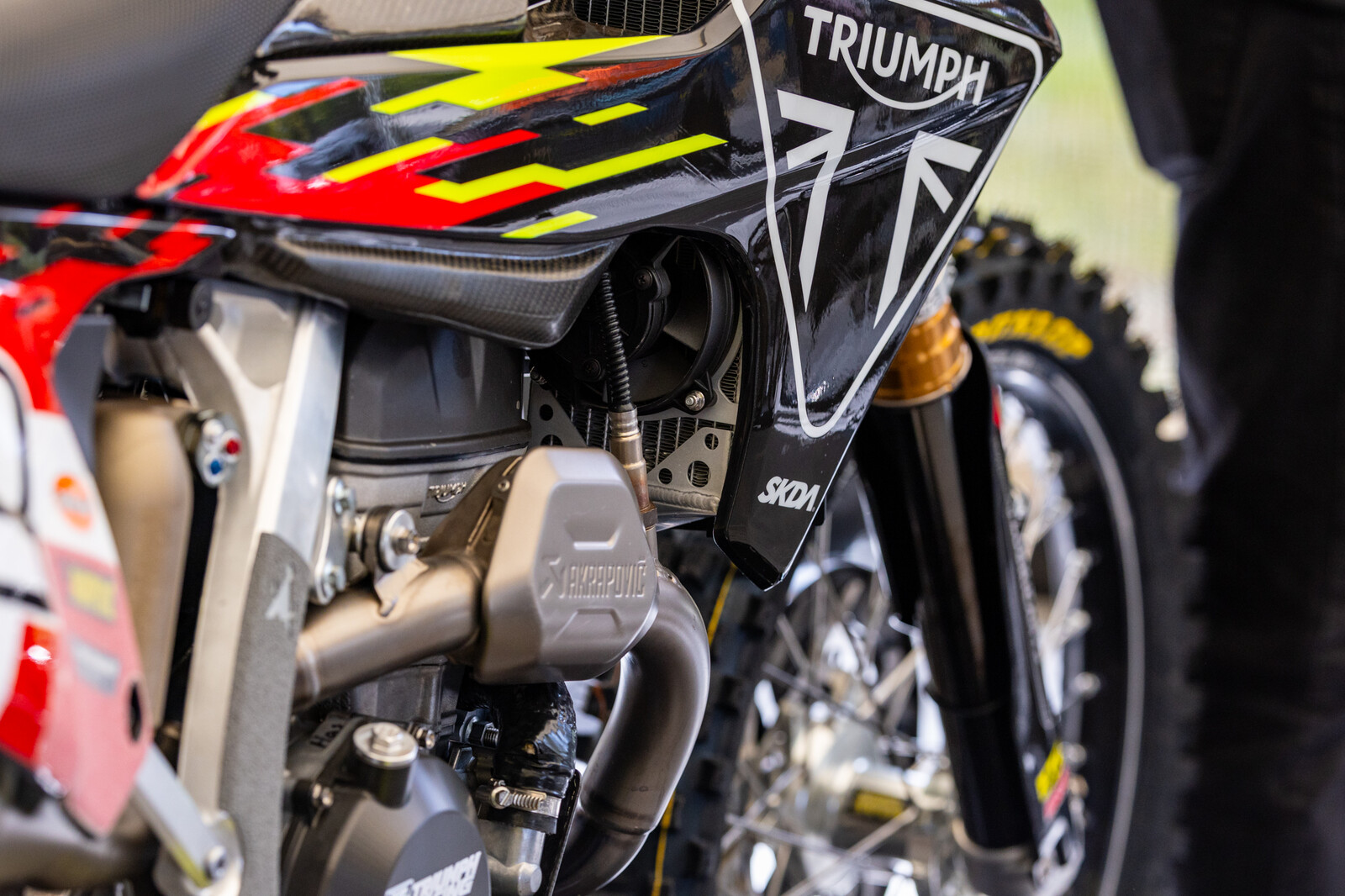 The US team uses a radiator fan on the right side.
The US team uses a radiator fan on the right side.
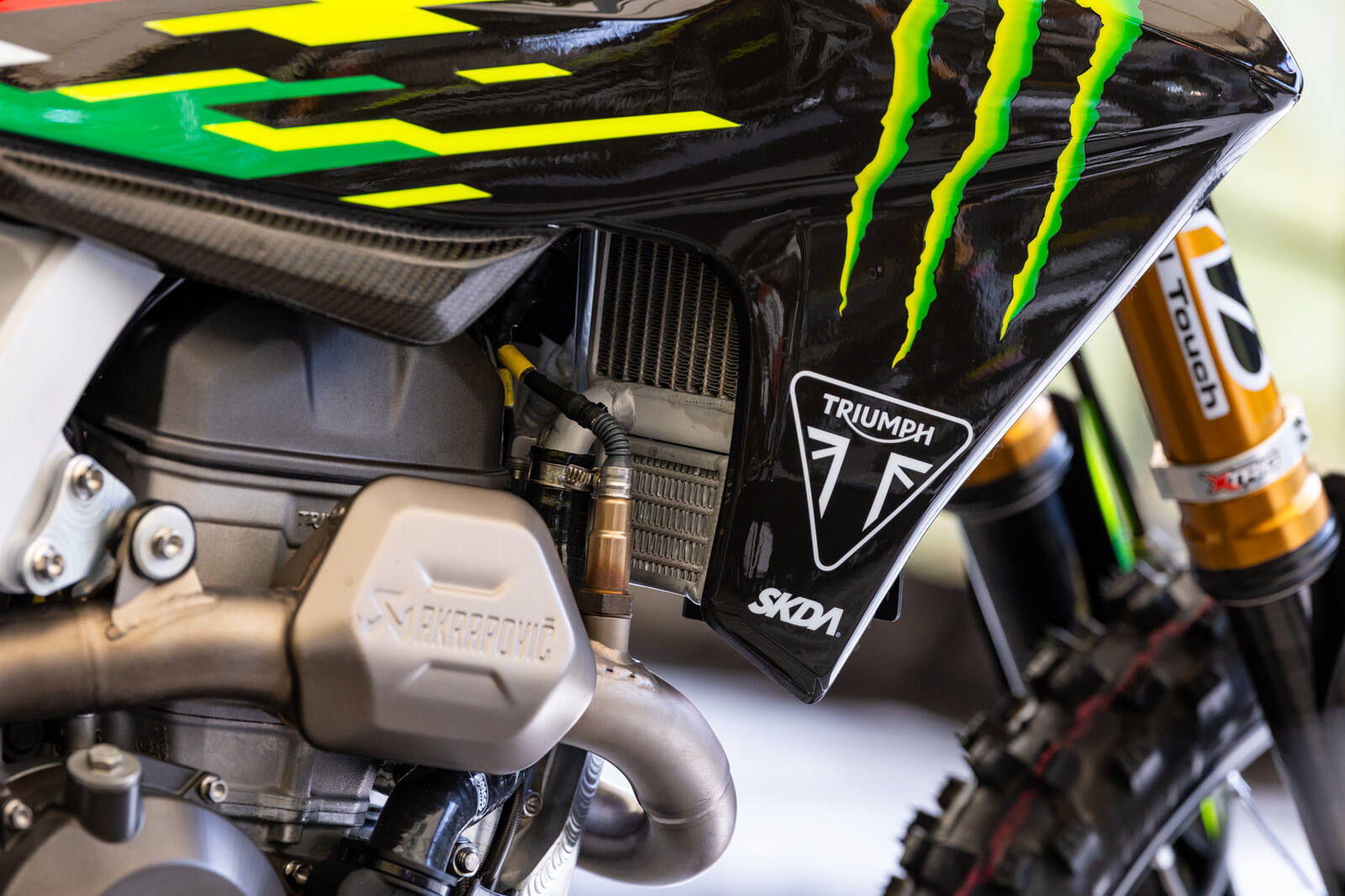 While the GP team's radiator fan is found on the left side, the right side has a smaller radiator so a separate oil cooler can be mounted under it.
While the GP team's radiator fan is found on the left side, the right side has a smaller radiator so a separate oil cooler can be mounted under it.
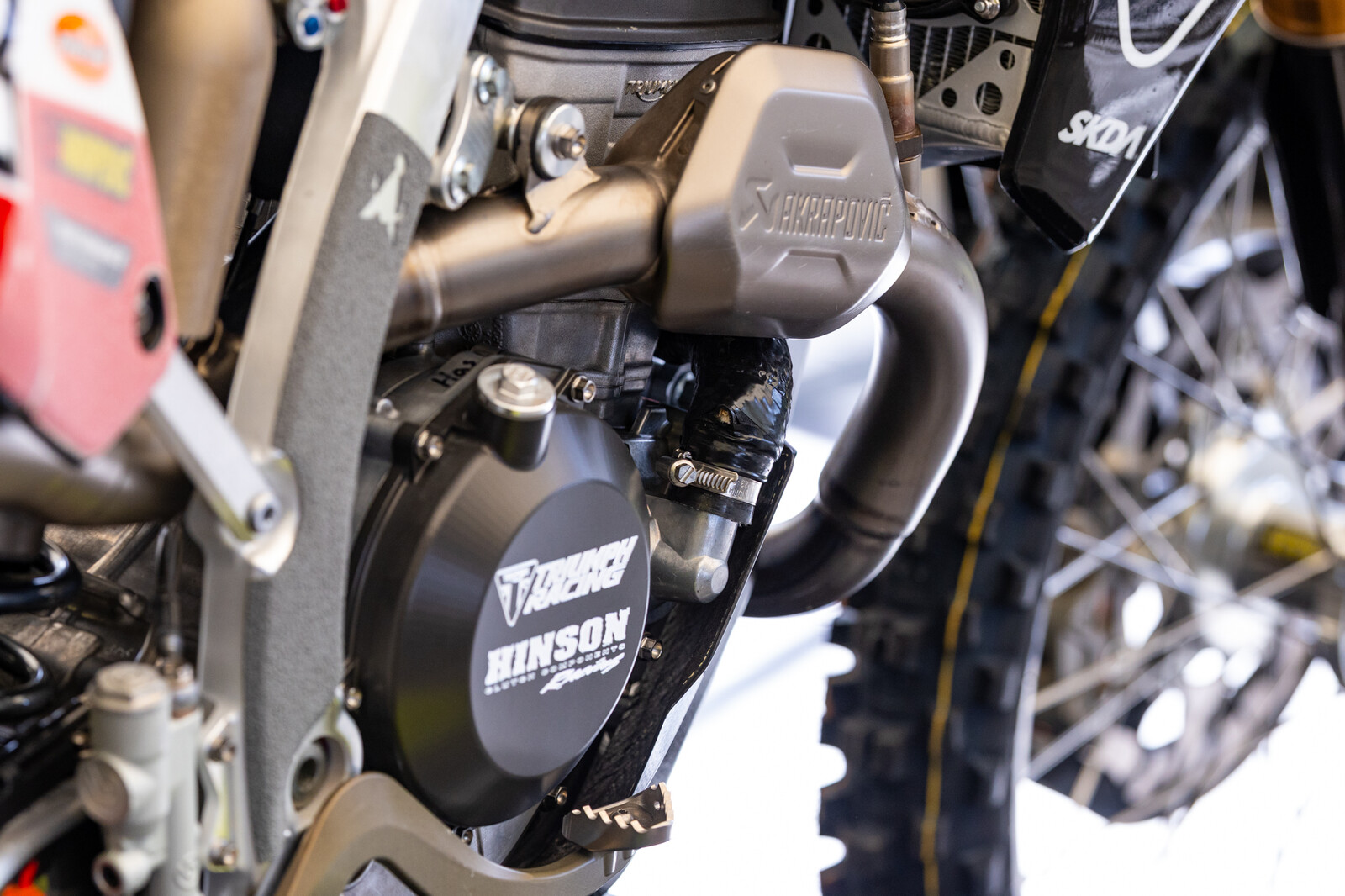 Some extra wrap to protect the lower radiator hose on the US bike.
Some extra wrap to protect the lower radiator hose on the US bike.
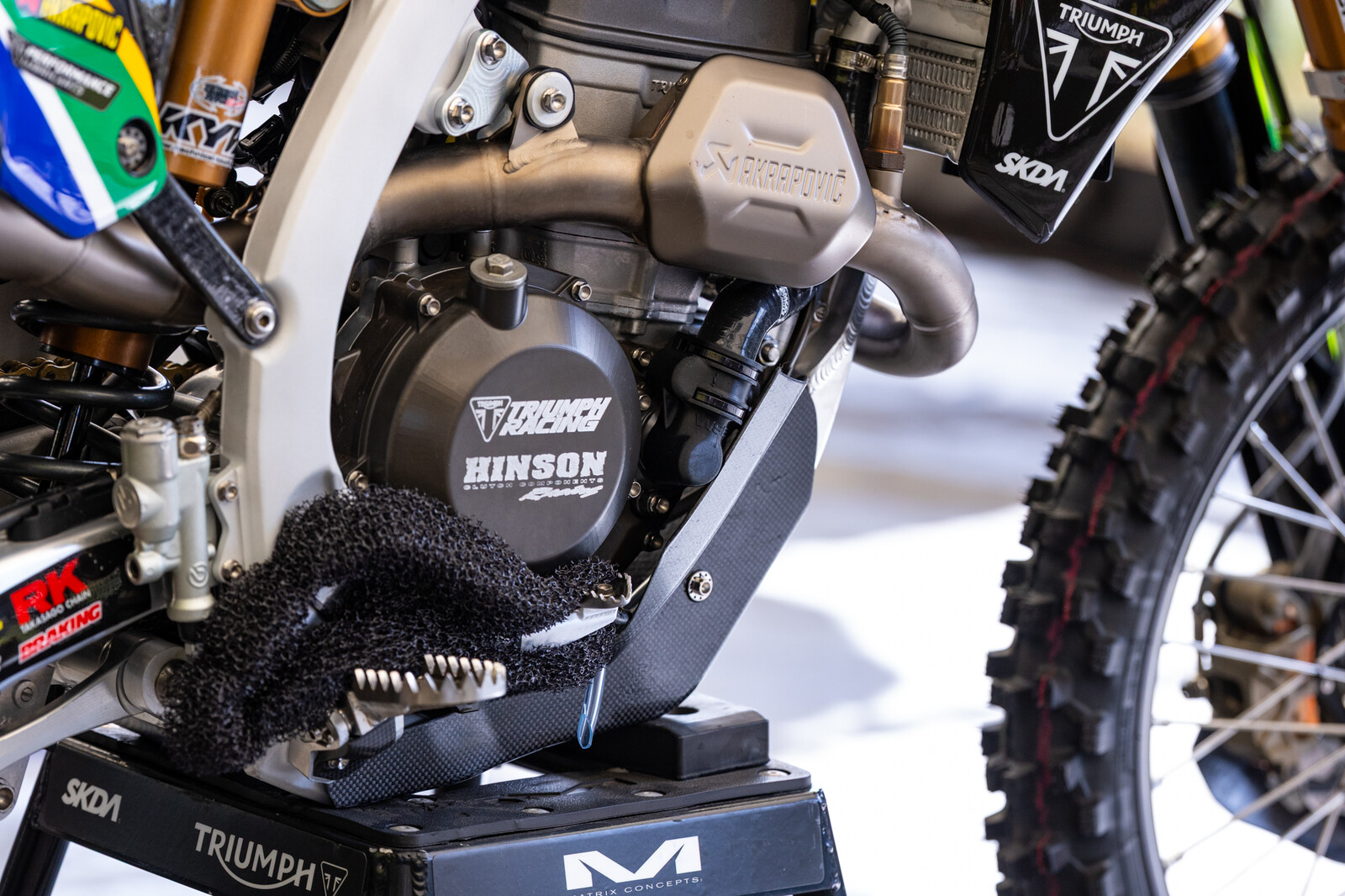 While the GP team has a custom plastic cover.
While the GP team has a custom plastic cover.
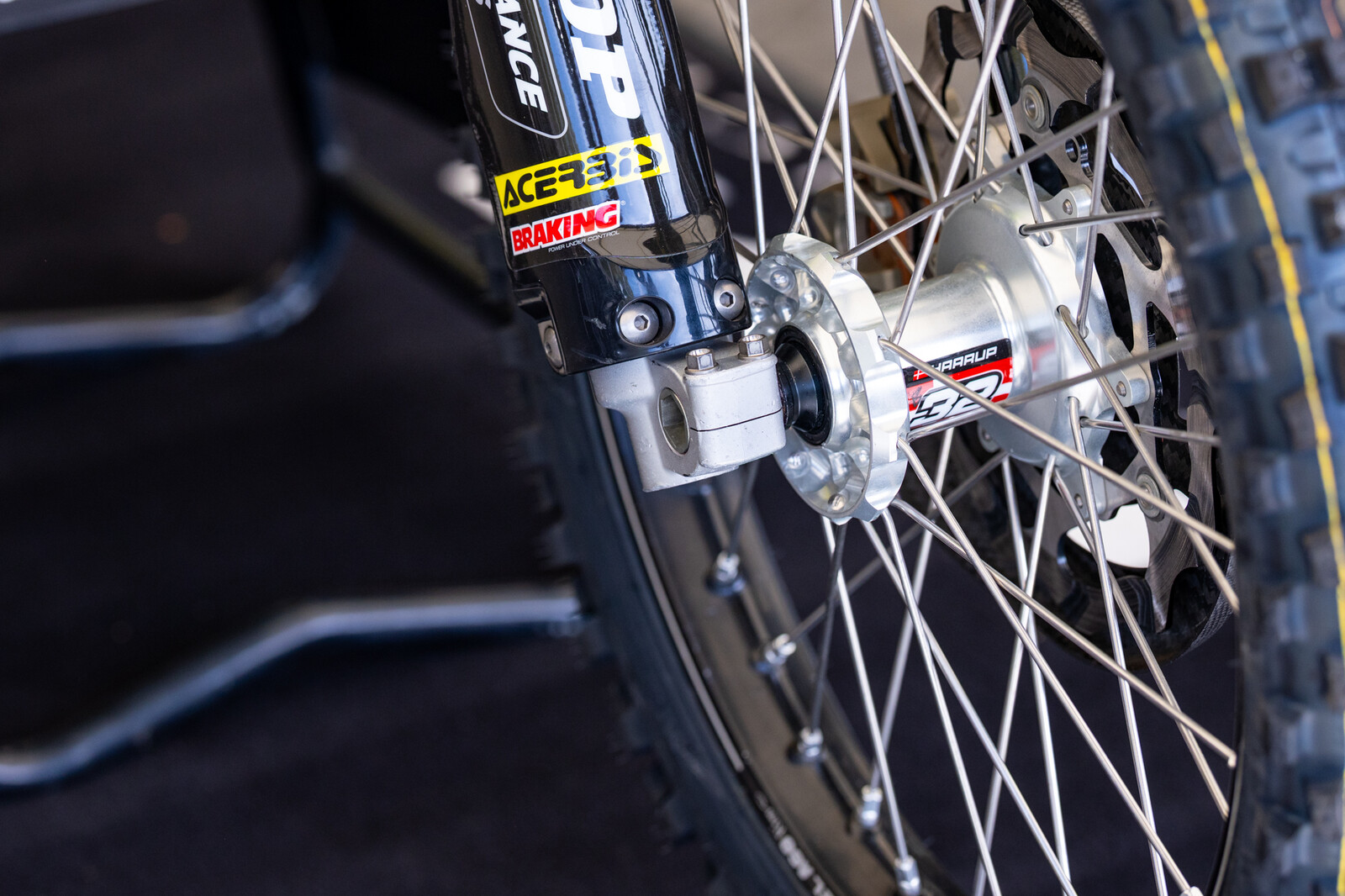 Stock fork lugs for the US bike.
Stock fork lugs for the US bike.
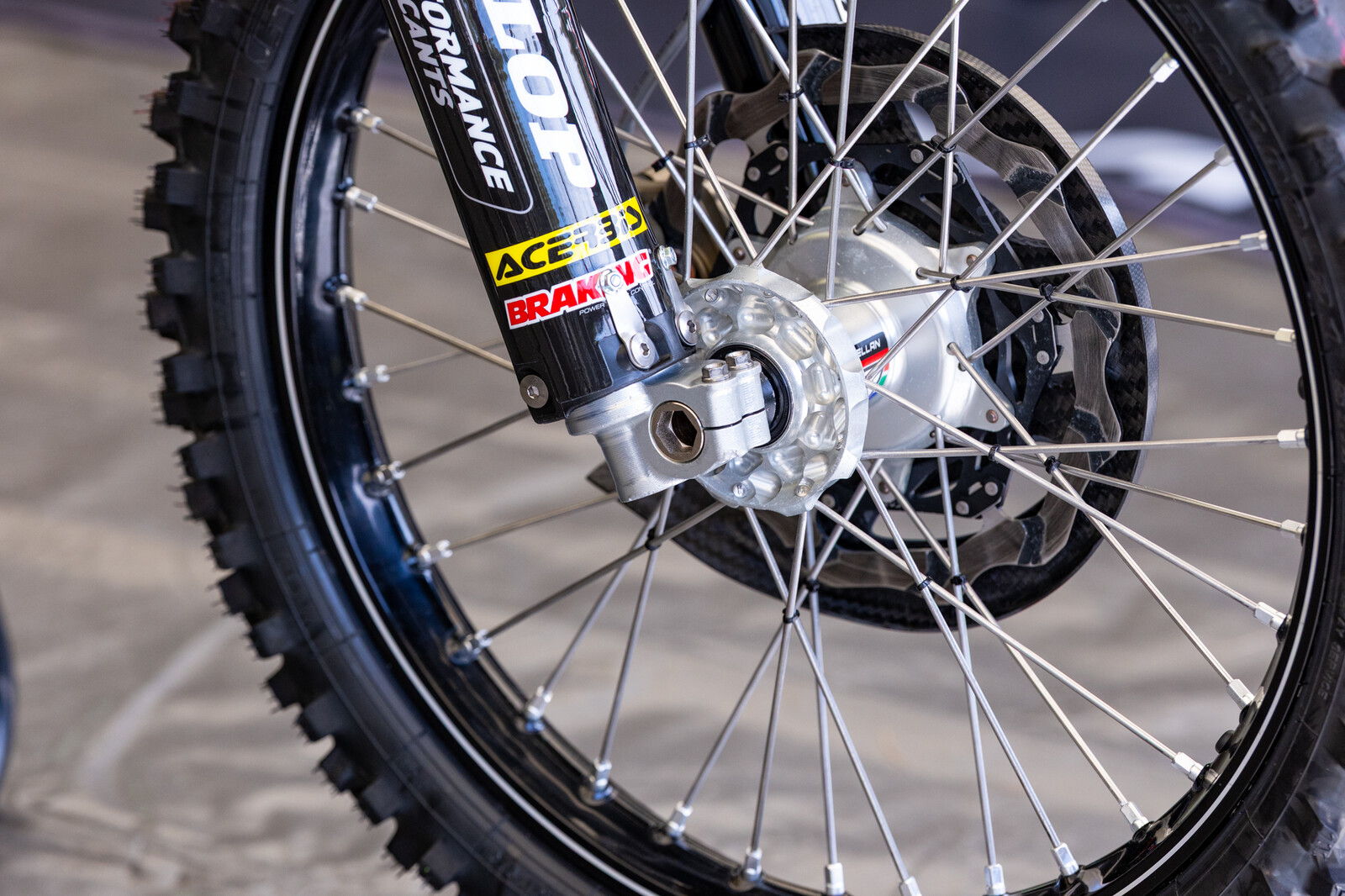 Billet lugs for the GP team.
Billet lugs for the GP team.
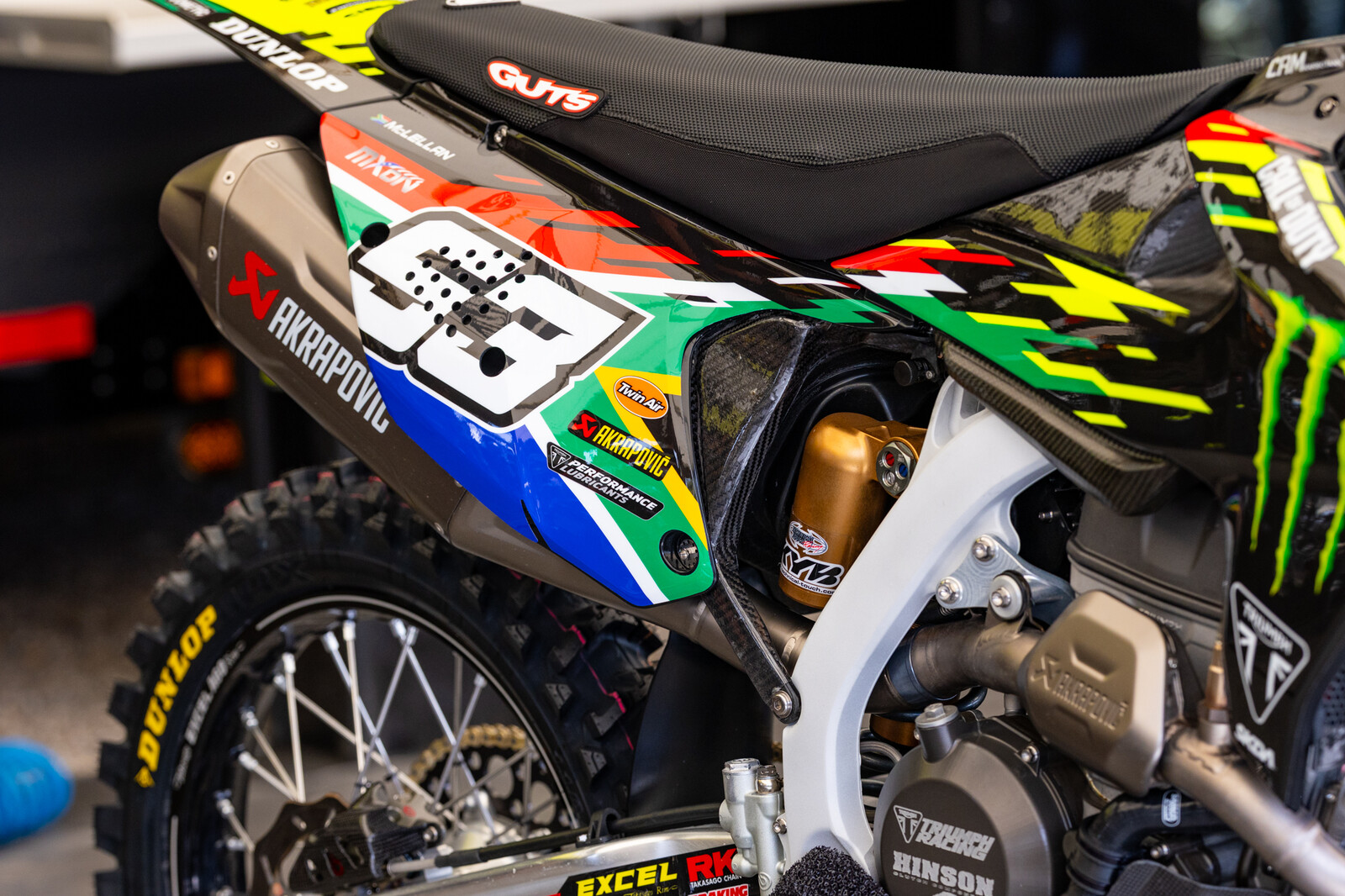 A full carbon fiber subframe/airbox is found on the GP team bike.
A full carbon fiber subframe/airbox is found on the GP team bike.
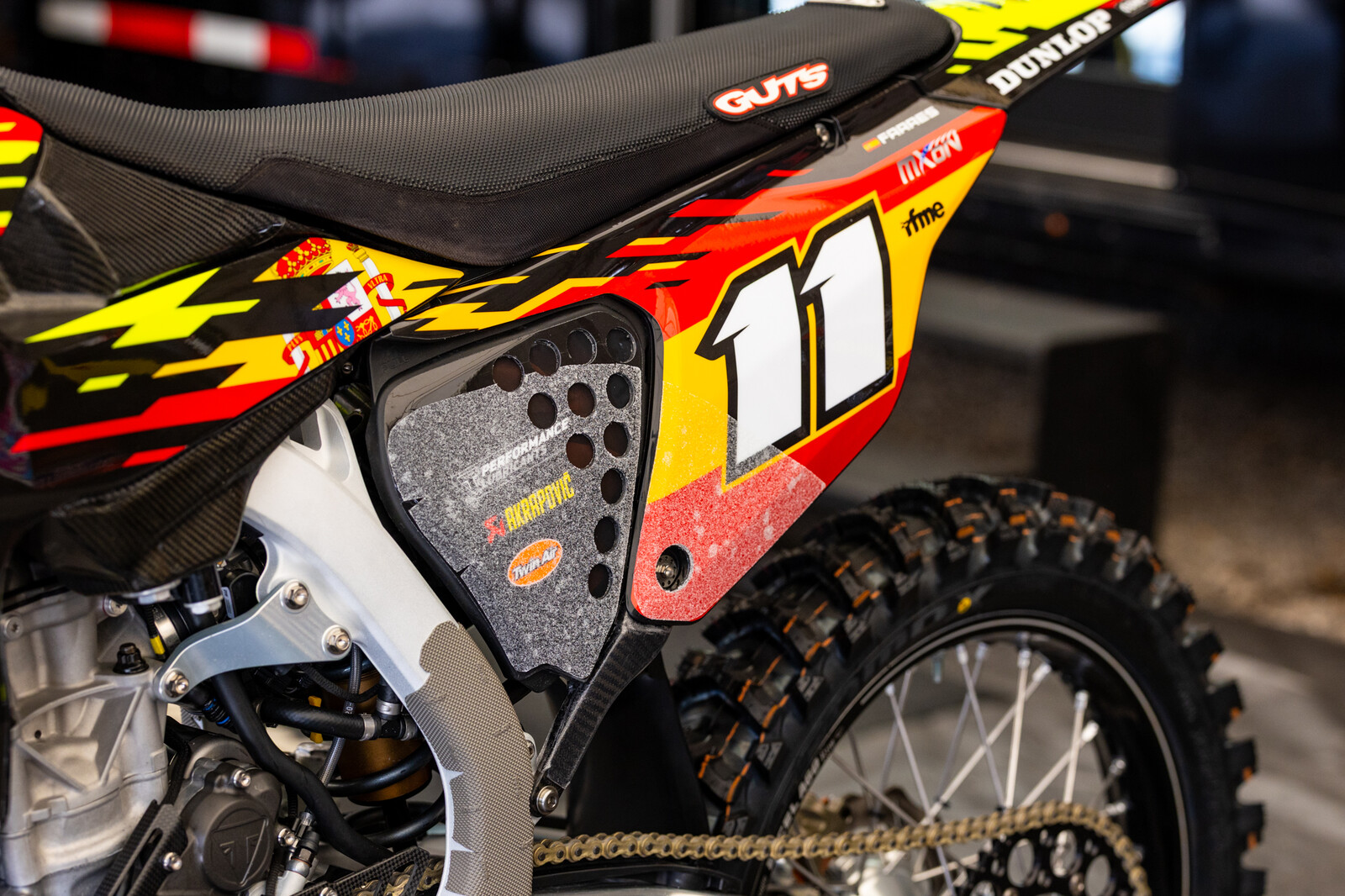 Another view. This setup isn't legal to run in the US.
Another view. This setup isn't legal to run in the US.
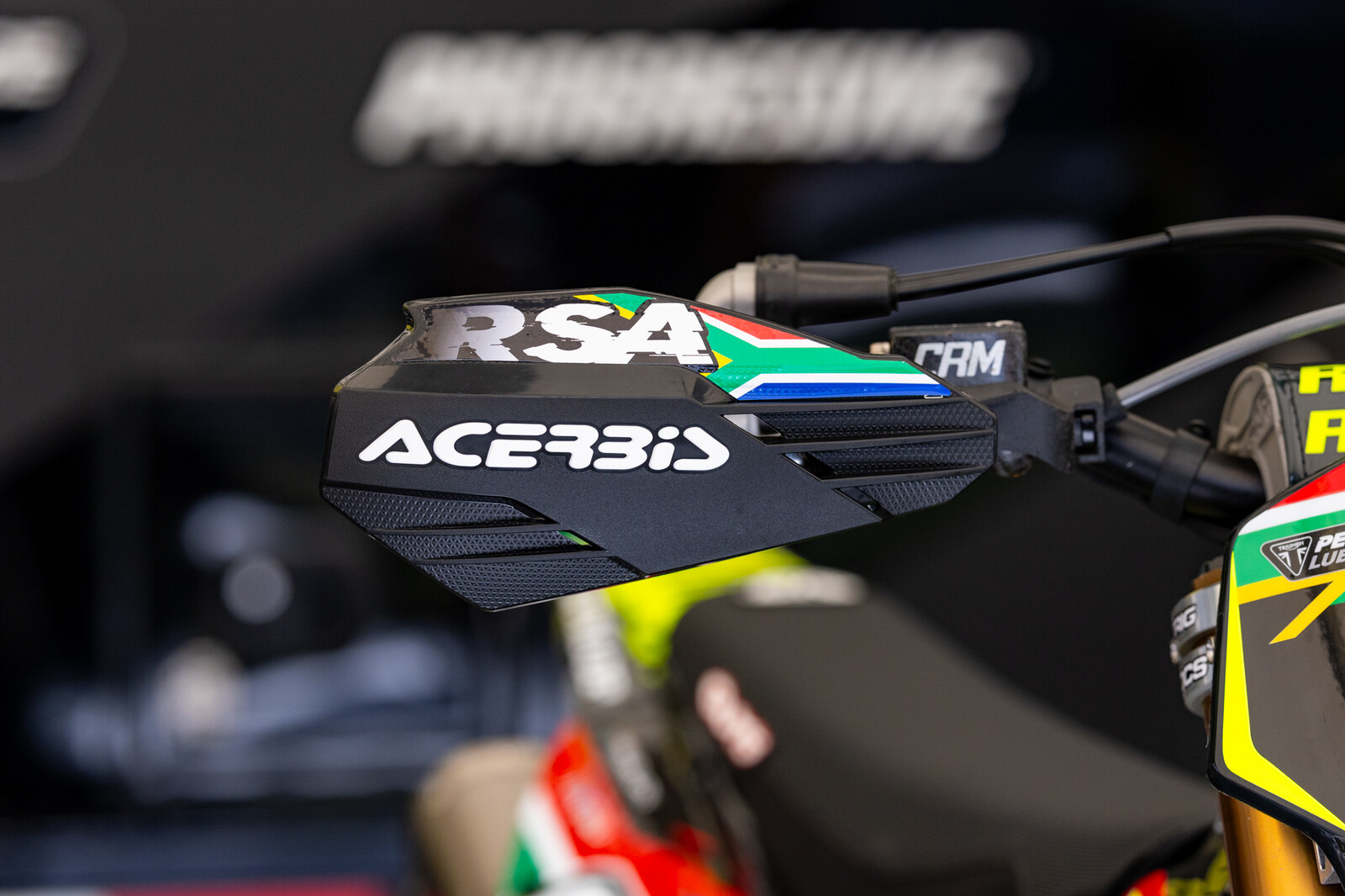 Acerbis hooked up a bunch of their teams with country-specific hanguard graphics.
Acerbis hooked up a bunch of their teams with country-specific hanguard graphics.
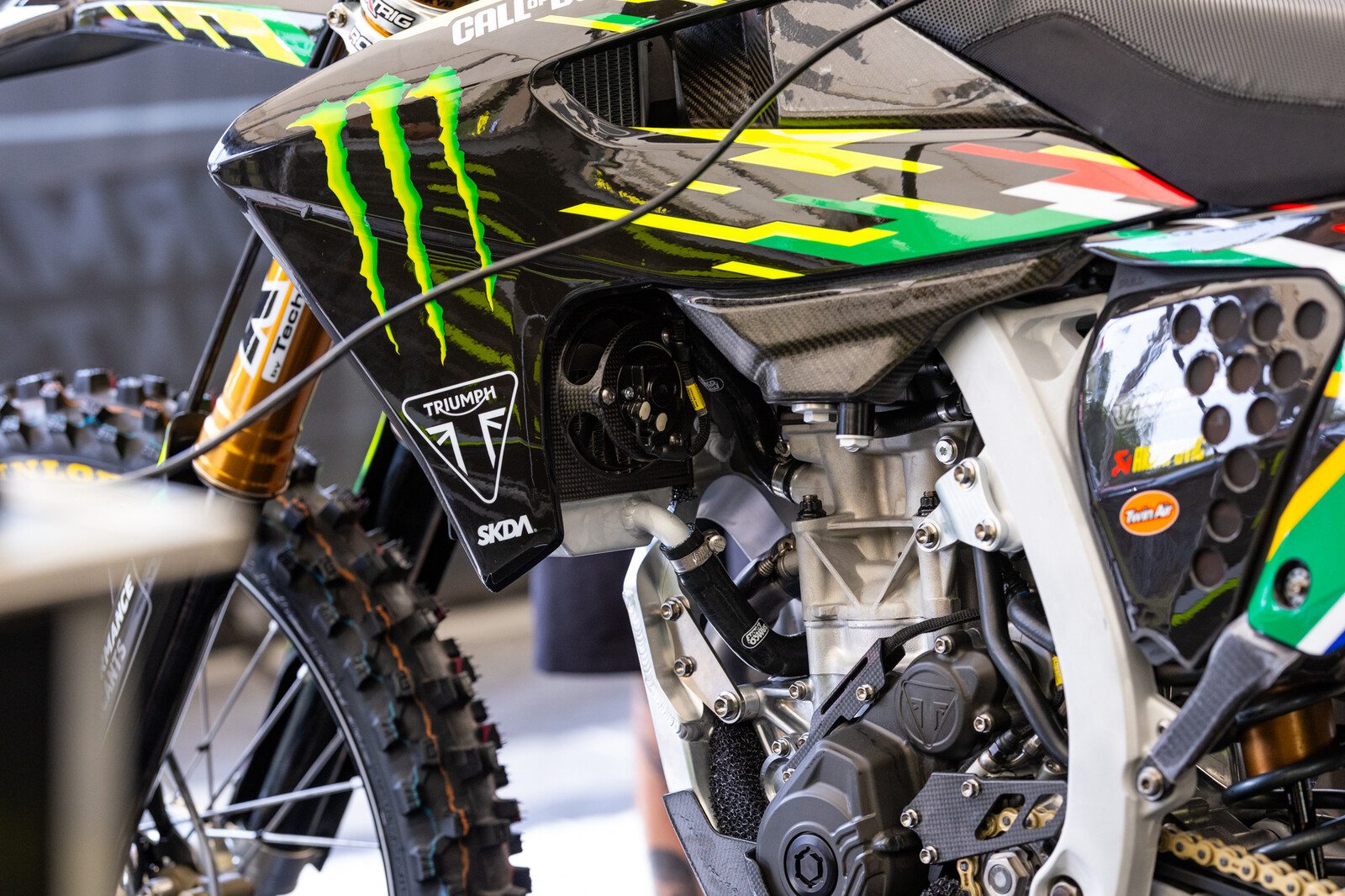 Radiator fan on the left side of the Triumph GP bike.
Radiator fan on the left side of the Triumph GP bike.
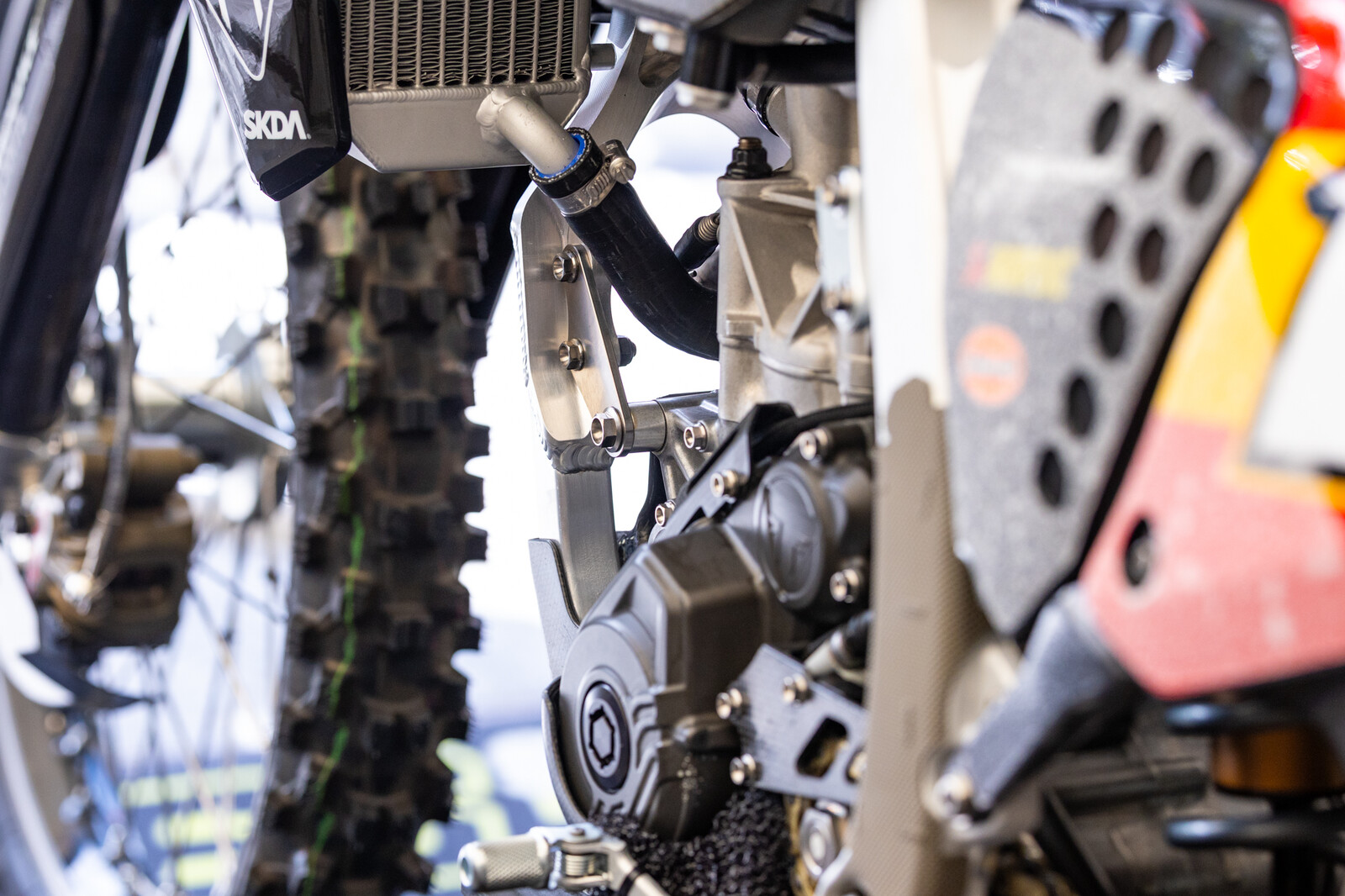 The GP team uses flat engine mounts with spacers, instead of curved units like stock.
The GP team uses flat engine mounts with spacers, instead of curved units like stock.
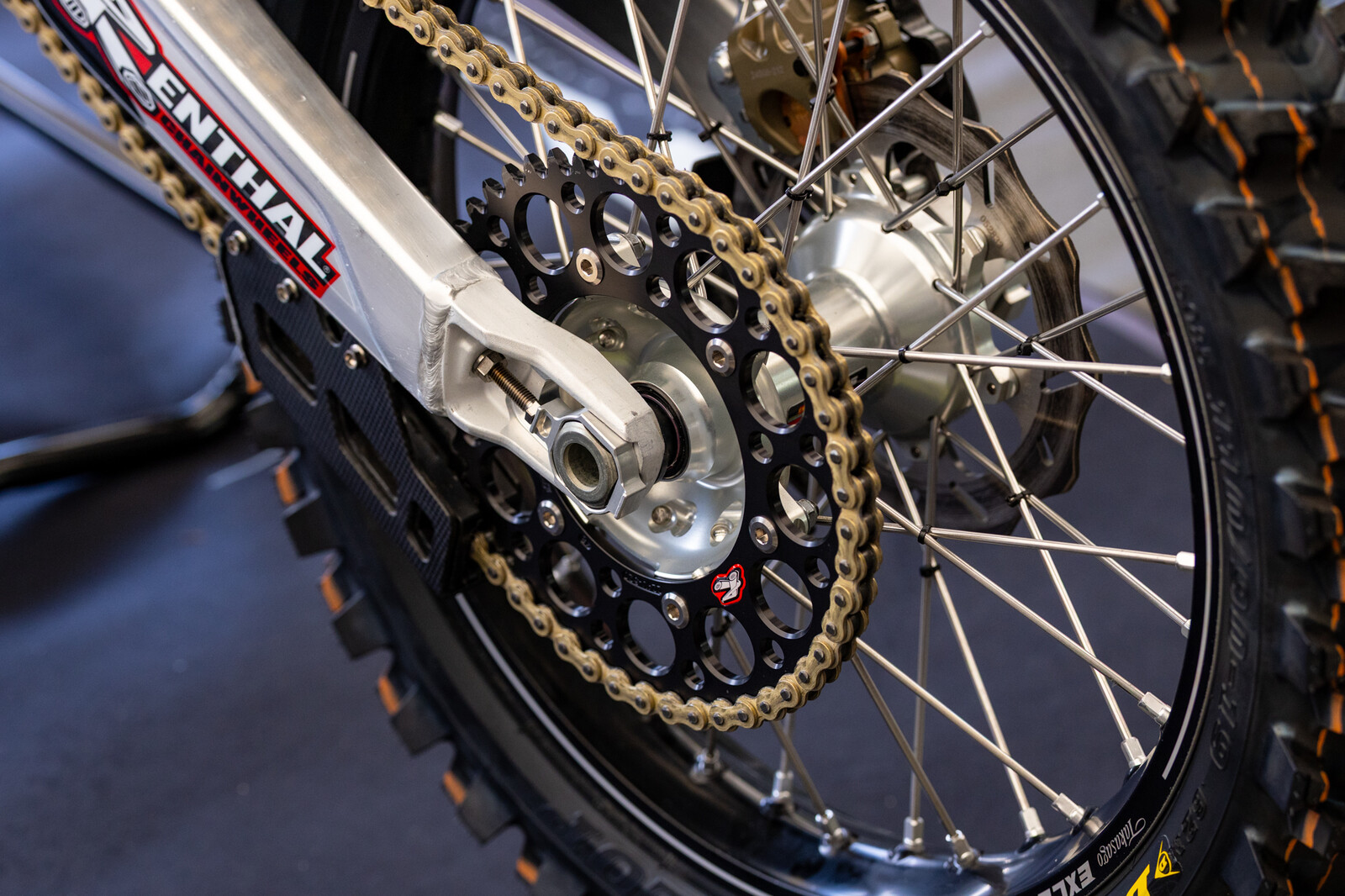 Now that's running the axle back...
Now that's running the axle back...
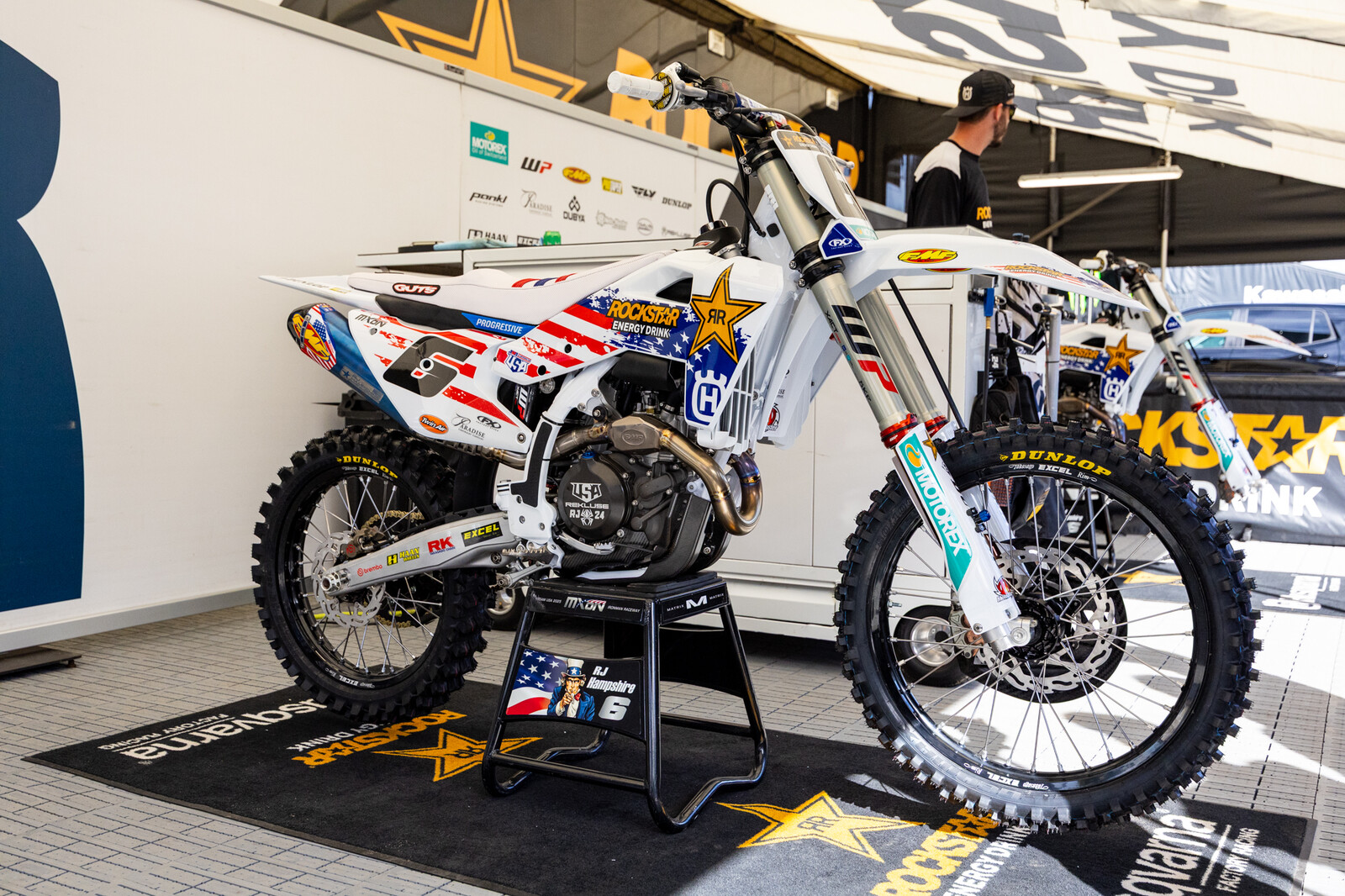 RJ Hampshire's Rockstar Energy Husqvarna FC450.
RJ Hampshire's Rockstar Energy Husqvarna FC450.
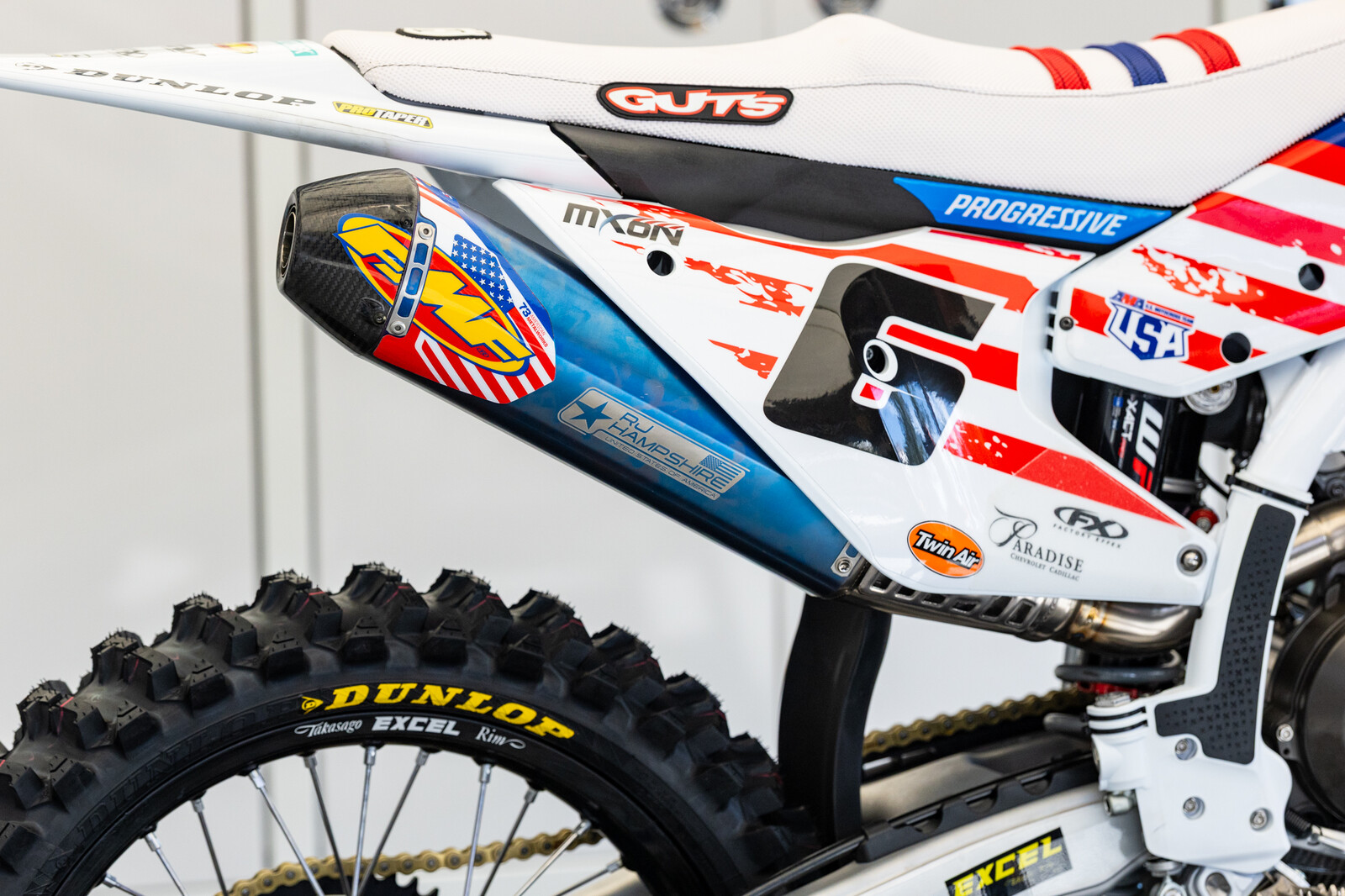 FMF did some custom laser-engraved exhausts for teams at MXoN.
FMF did some custom laser-engraved exhausts for teams at MXoN.
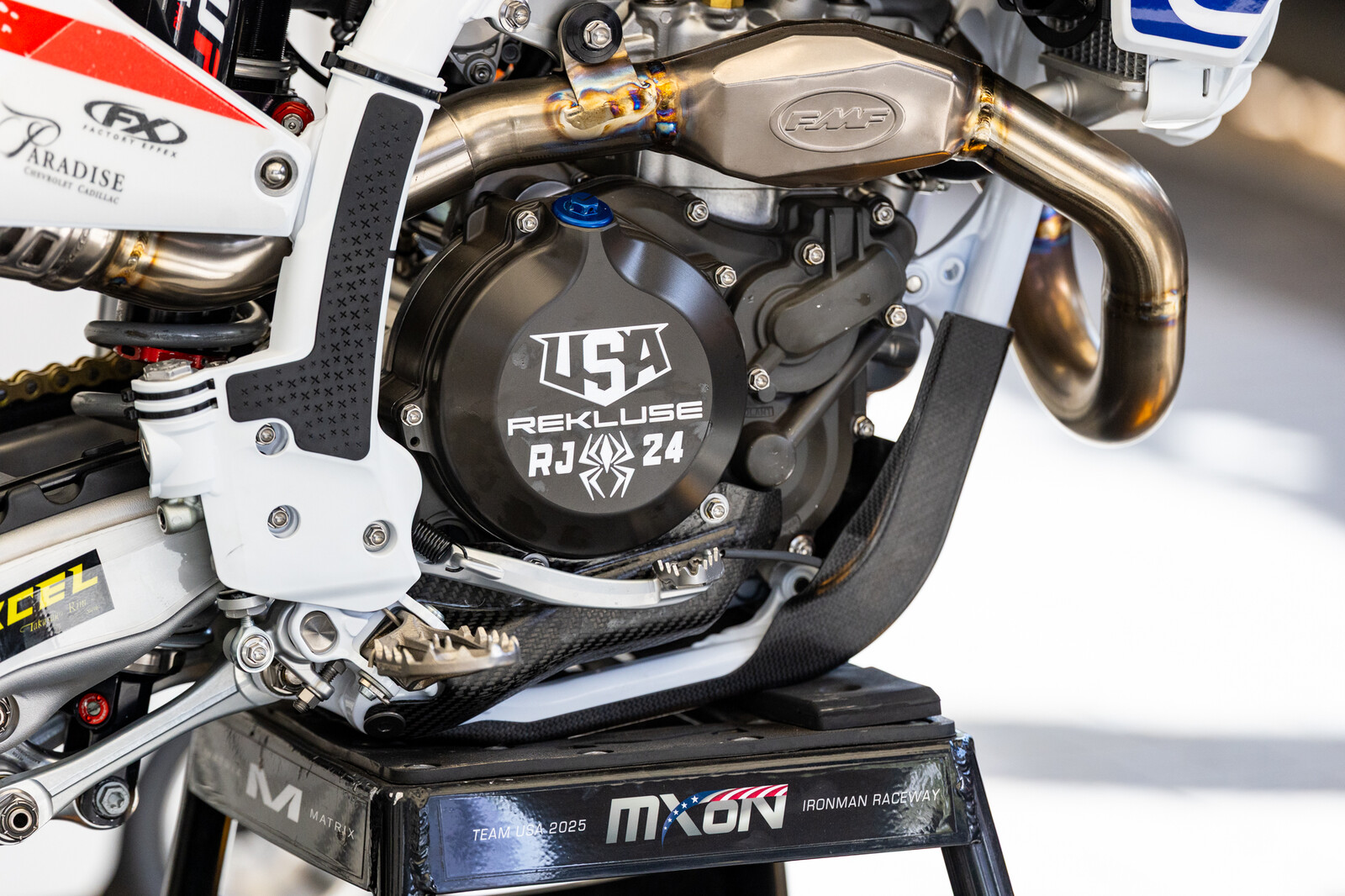 Ignore the fingerprints; that's a clean clutch cover right there. Also, we haven't fully figured out what the carbon guard on the bottom of the right side of the engine is for. We first saw it appear on Sexton and Plessinger's bike. It could be a simple as blocking mud and debris from getting between the engine case and brake pedal, or maybe there's something else their protecting.
Ignore the fingerprints; that's a clean clutch cover right there. Also, we haven't fully figured out what the carbon guard on the bottom of the right side of the engine is for. We first saw it appear on Sexton and Plessinger's bike. It could be a simple as blocking mud and debris from getting between the engine case and brake pedal, or maybe there's something else their protecting.
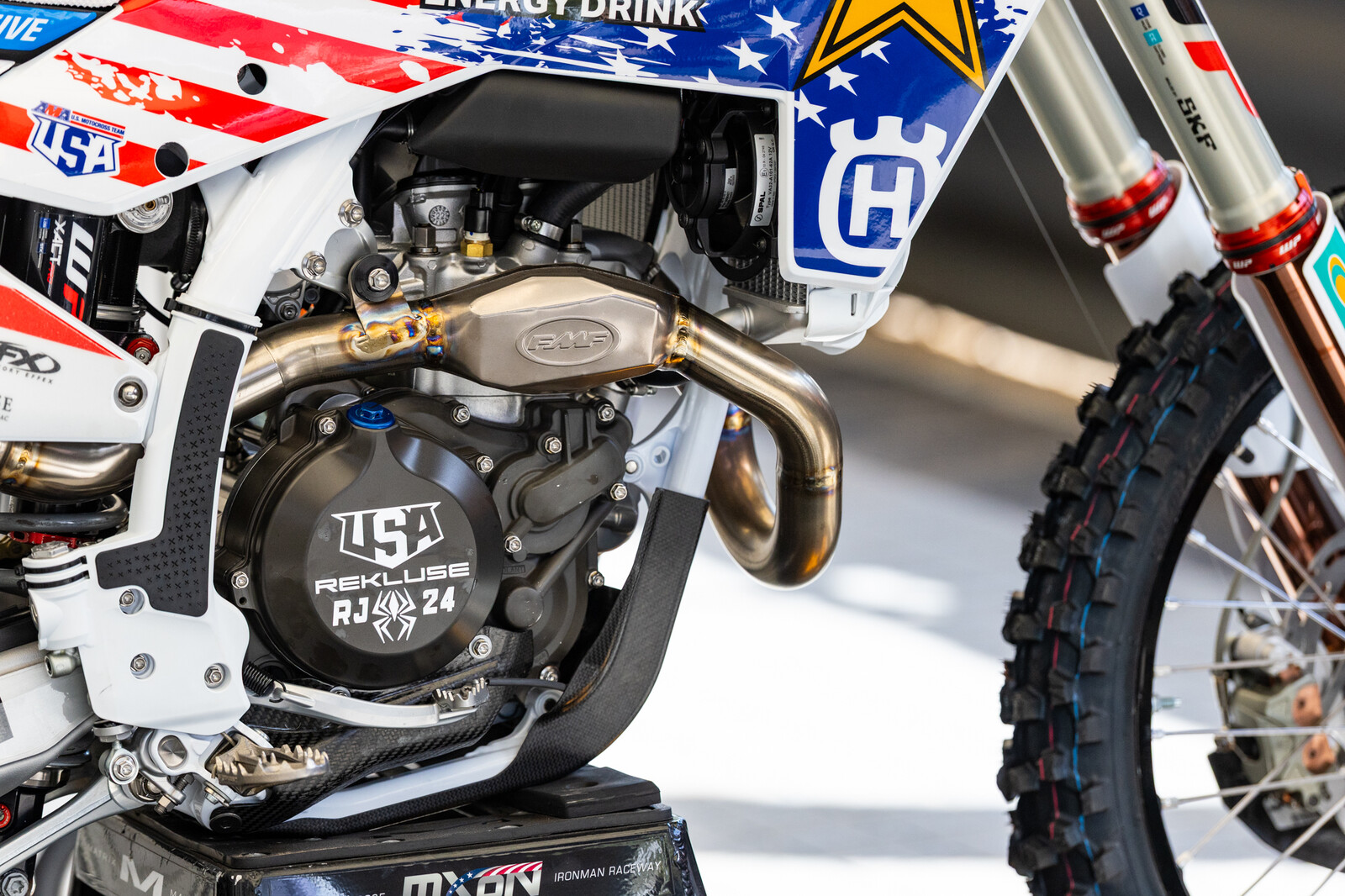
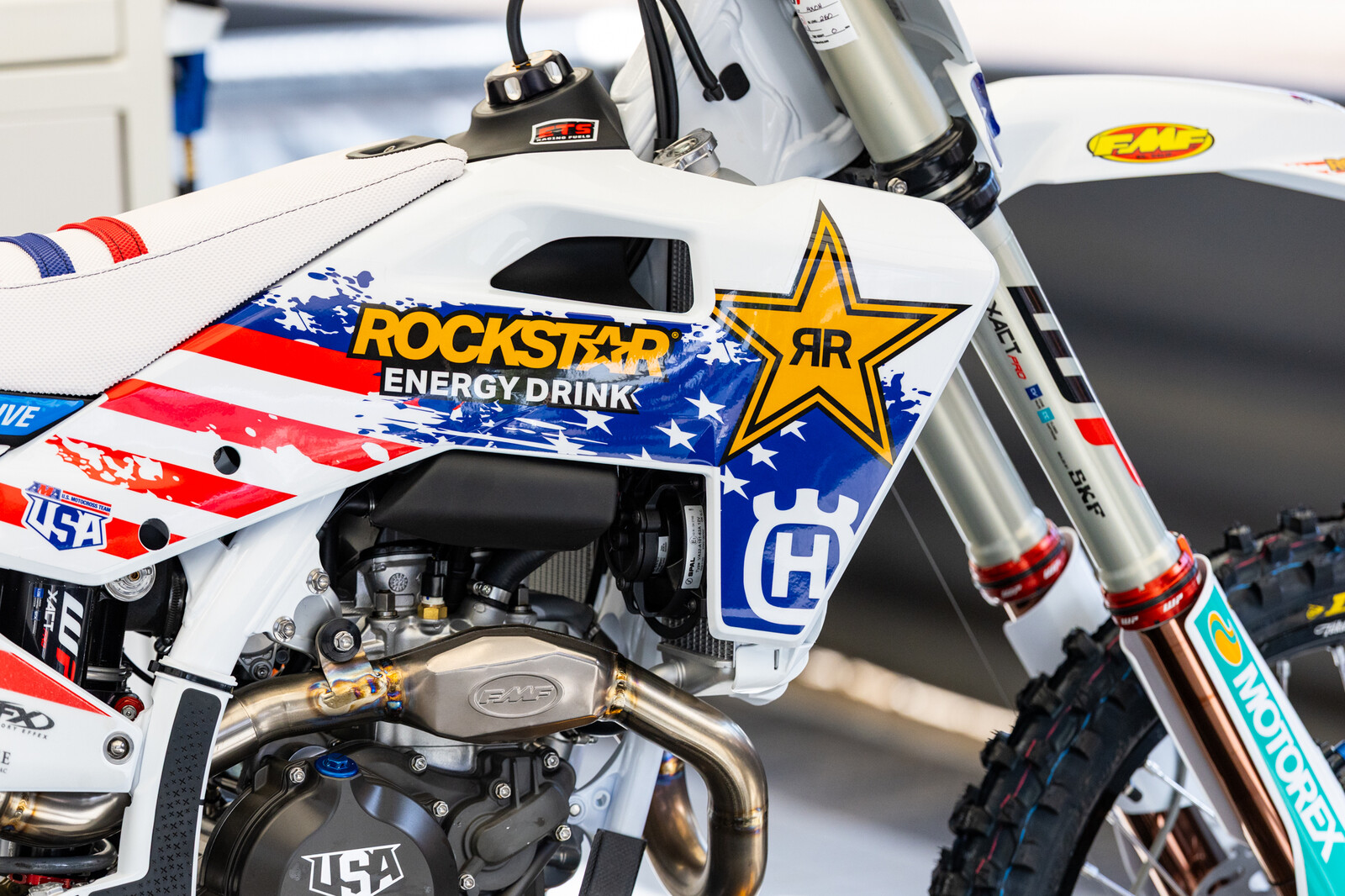 The Austrian factory teams have one of the cleaner radiator fan kits.
The Austrian factory teams have one of the cleaner radiator fan kits.
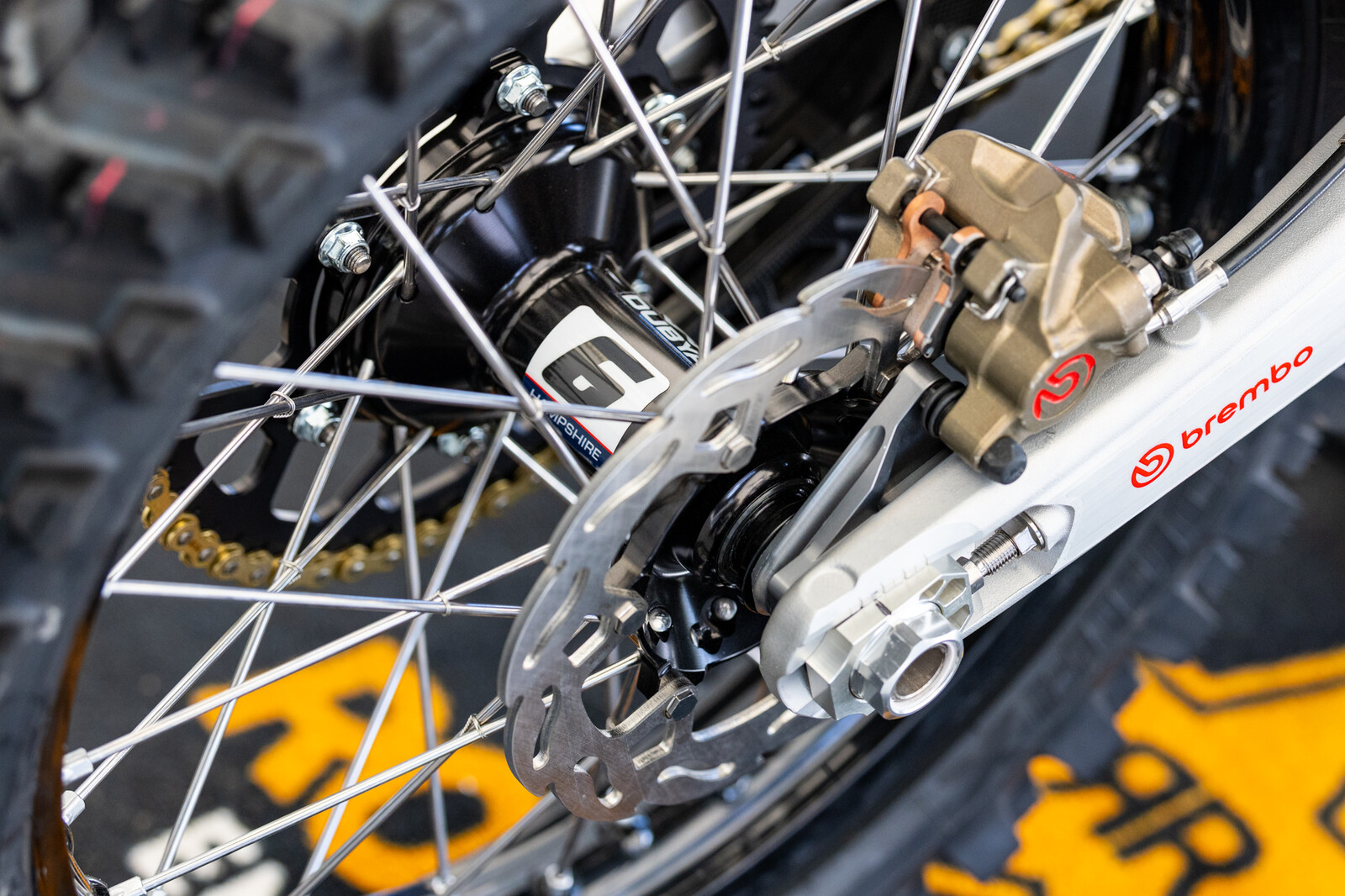 Just a little wire tie to keep the spokes from leaving the wheel in case of an issue mid-race.
Just a little wire tie to keep the spokes from leaving the wheel in case of an issue mid-race.
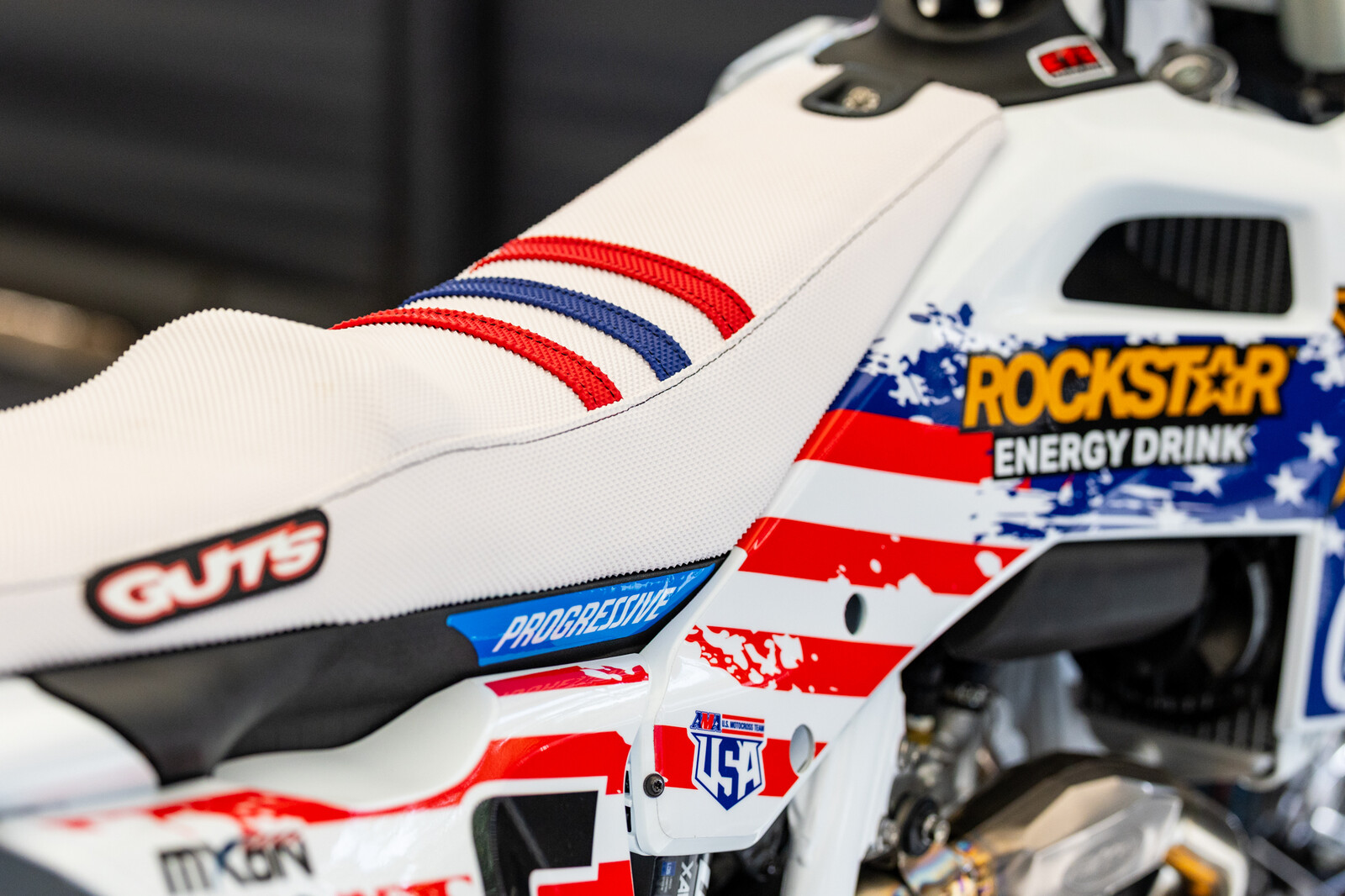 These stripes don't run.
These stripes don't run.
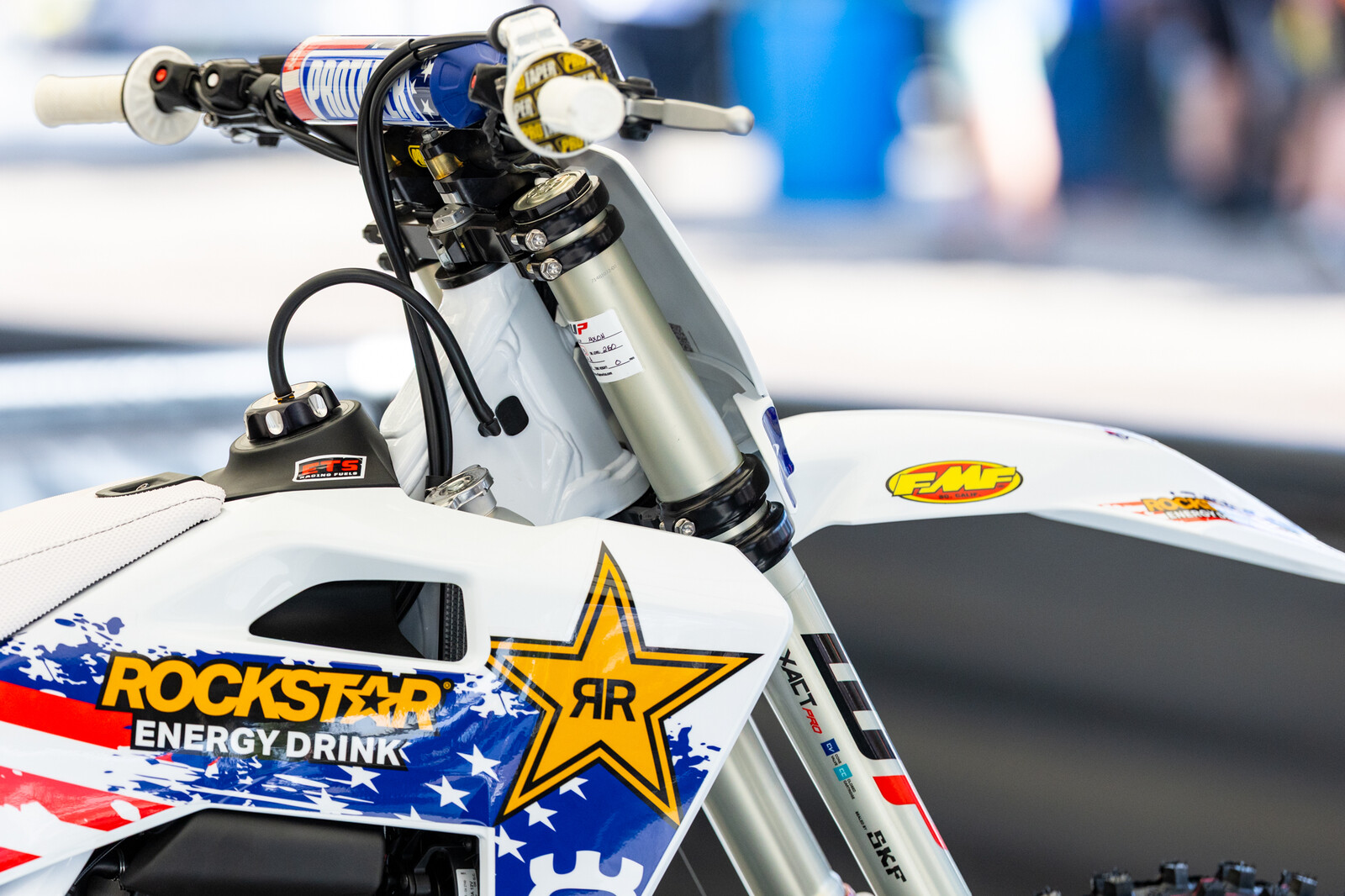 We're interested to see if WP's works airfork (which we've been told is only slightly different to the production airfork we see raced in the US), will make its way onto more than just RJ's bike in 2026. Tomac is a big air fork guy...maybe he will be on it?
We're interested to see if WP's works airfork (which we've been told is only slightly different to the production airfork we see raced in the US), will make its way onto more than just RJ's bike in 2026. Tomac is a big air fork guy...maybe he will be on it?
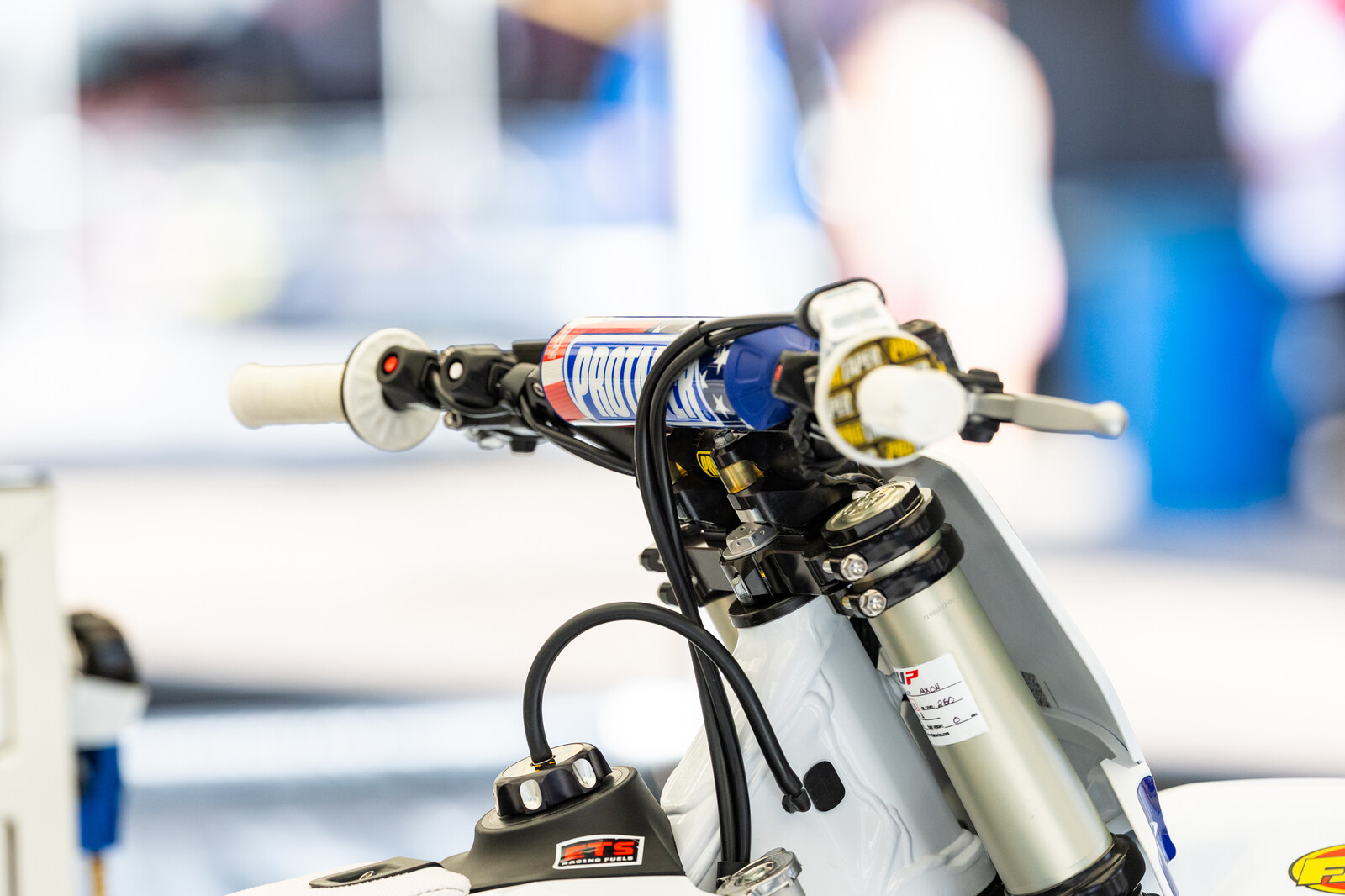 A complicated electronics console has been replaced by simple buttons for start, stop, and start map.
A complicated electronics console has been replaced by simple buttons for start, stop, and start map.
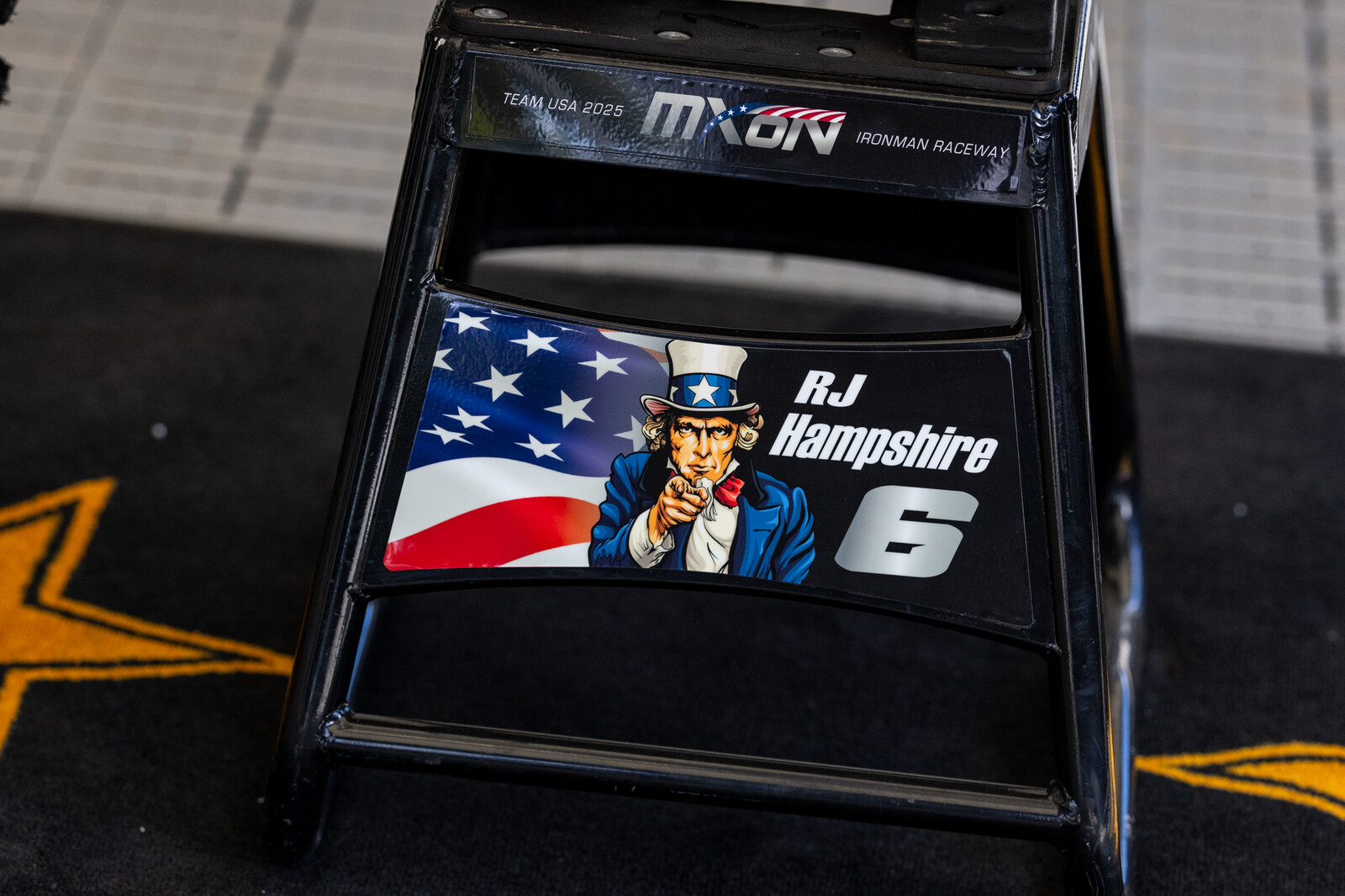 Uncle Sam needs you.
Uncle Sam needs you.
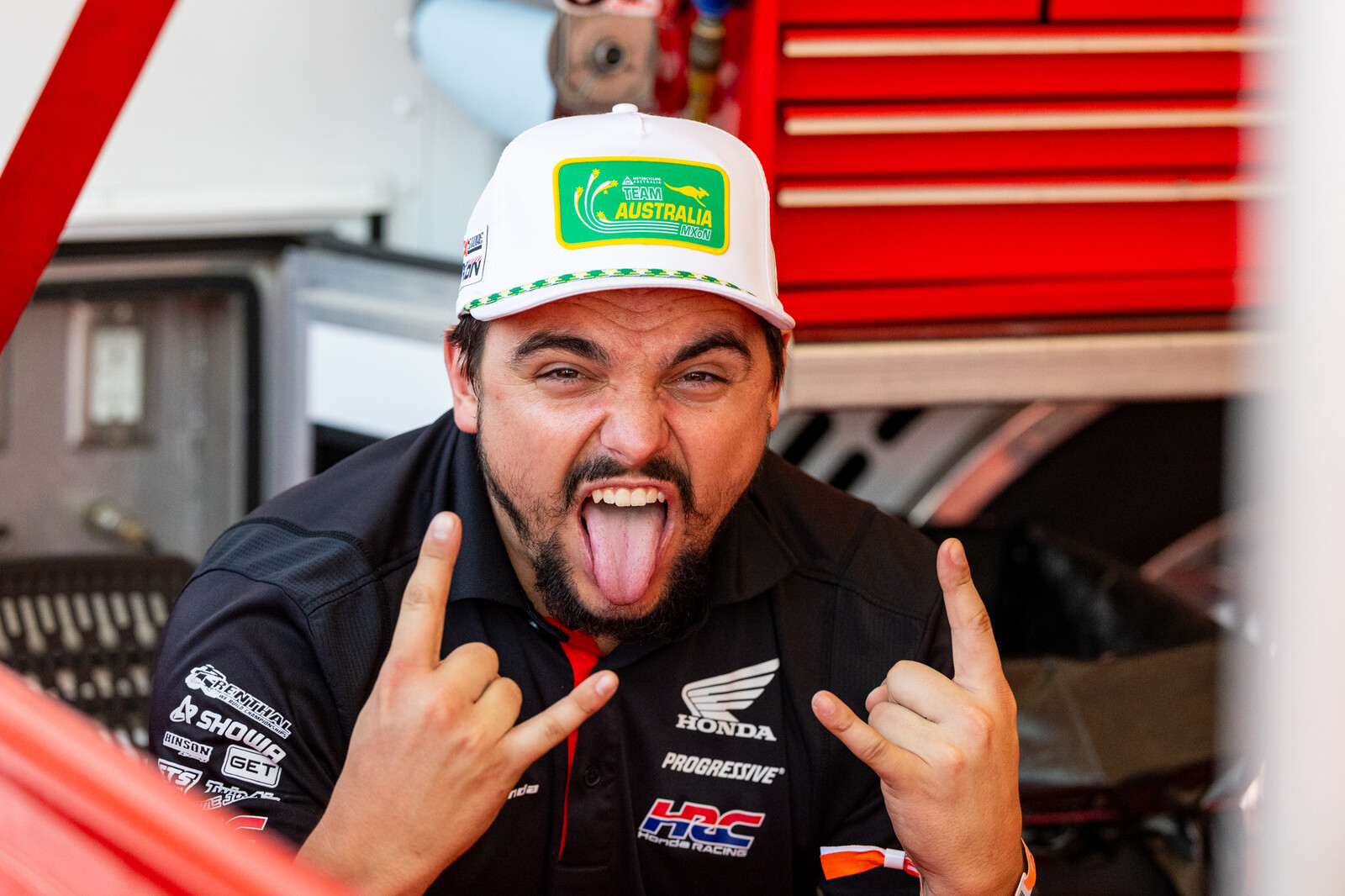 Off-season stoke? See you all at the next big race!
Off-season stoke? See you all at the next big race!
Pit Bits 2019


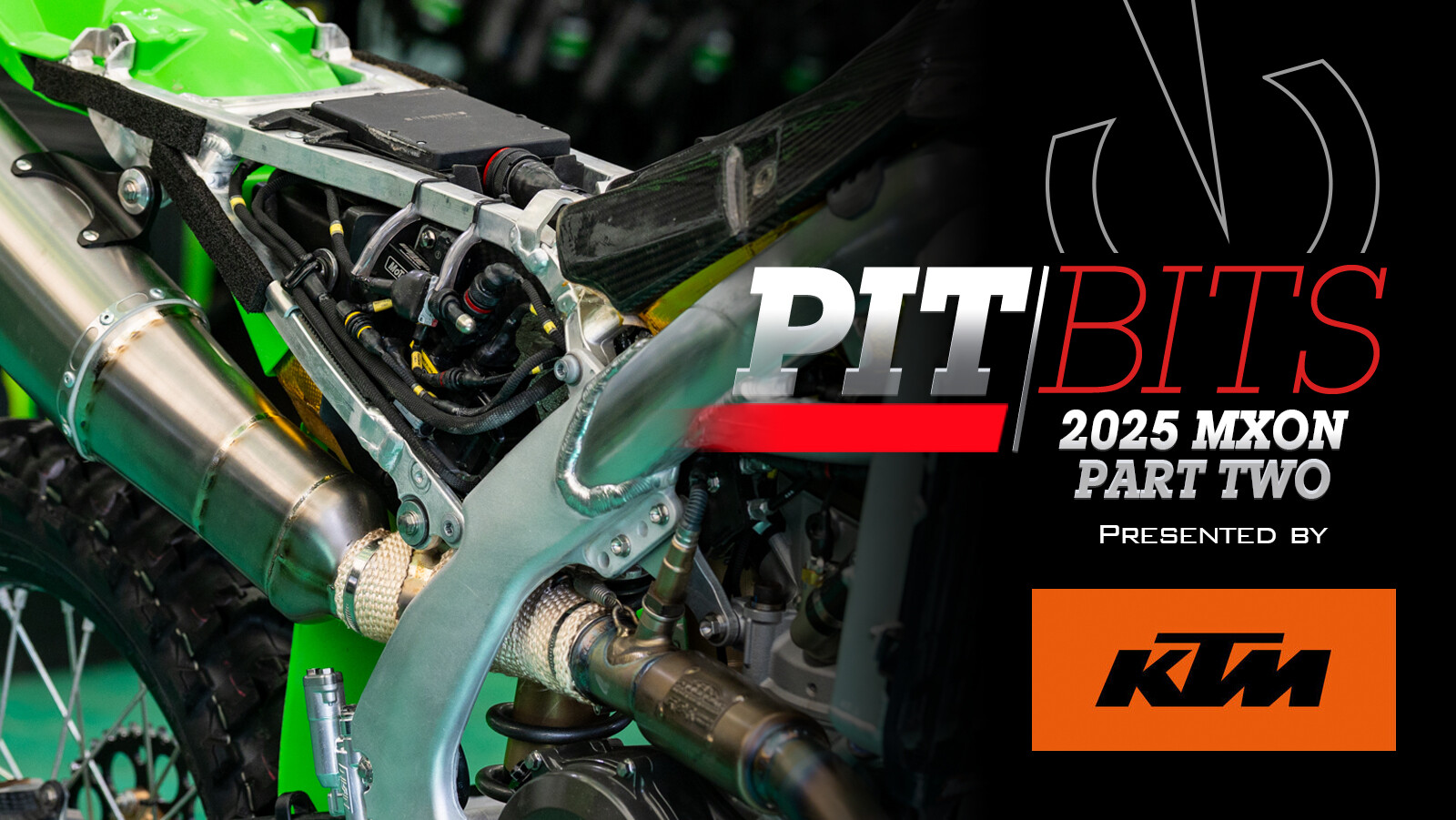




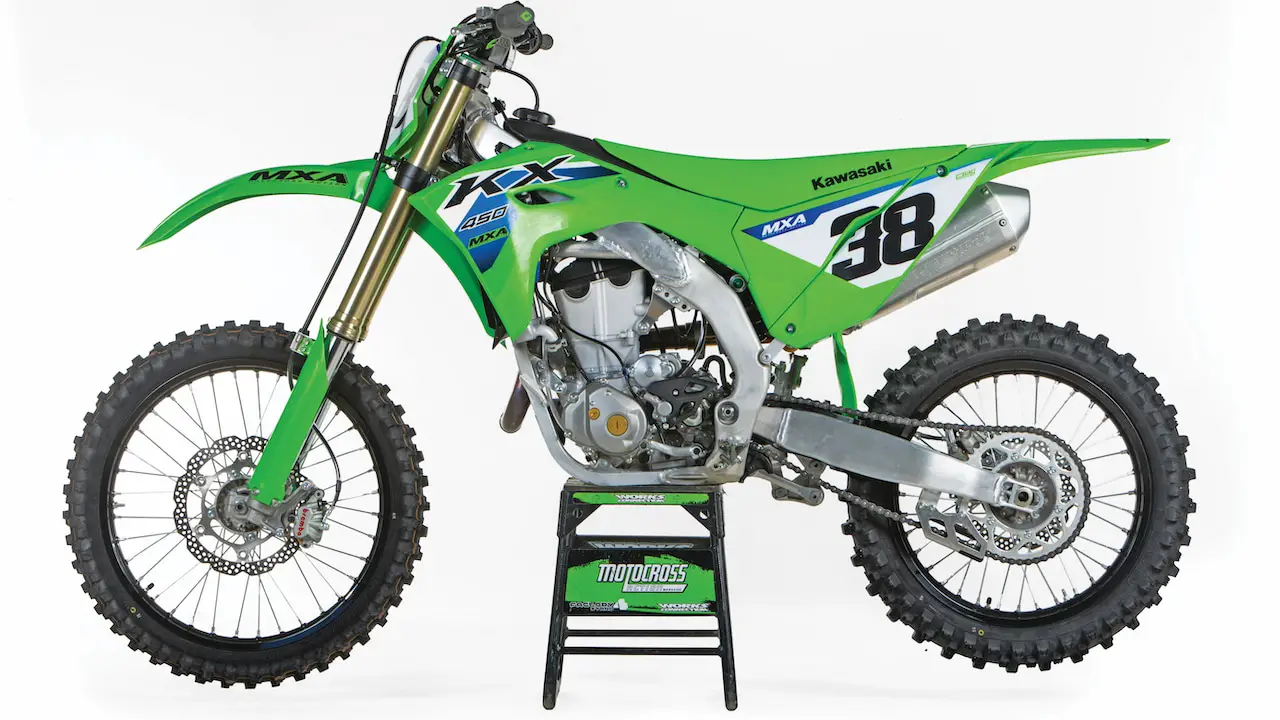





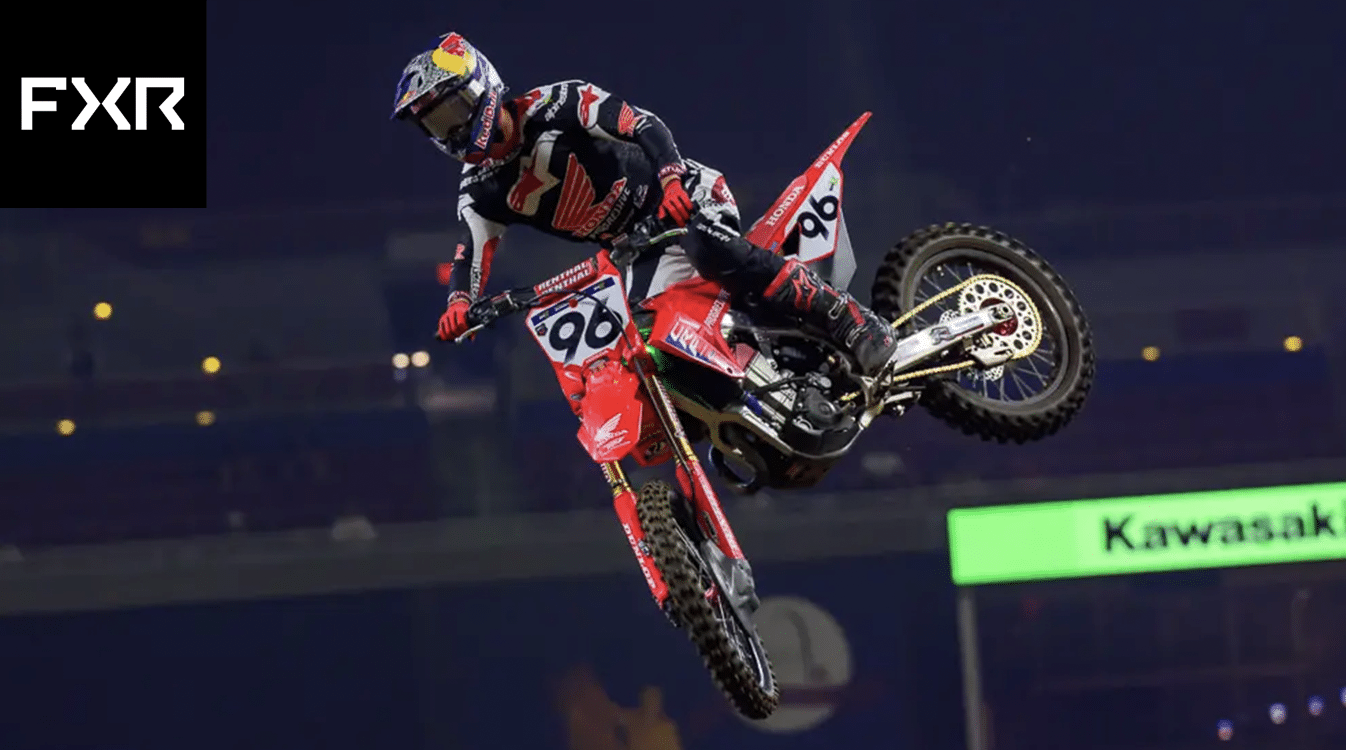




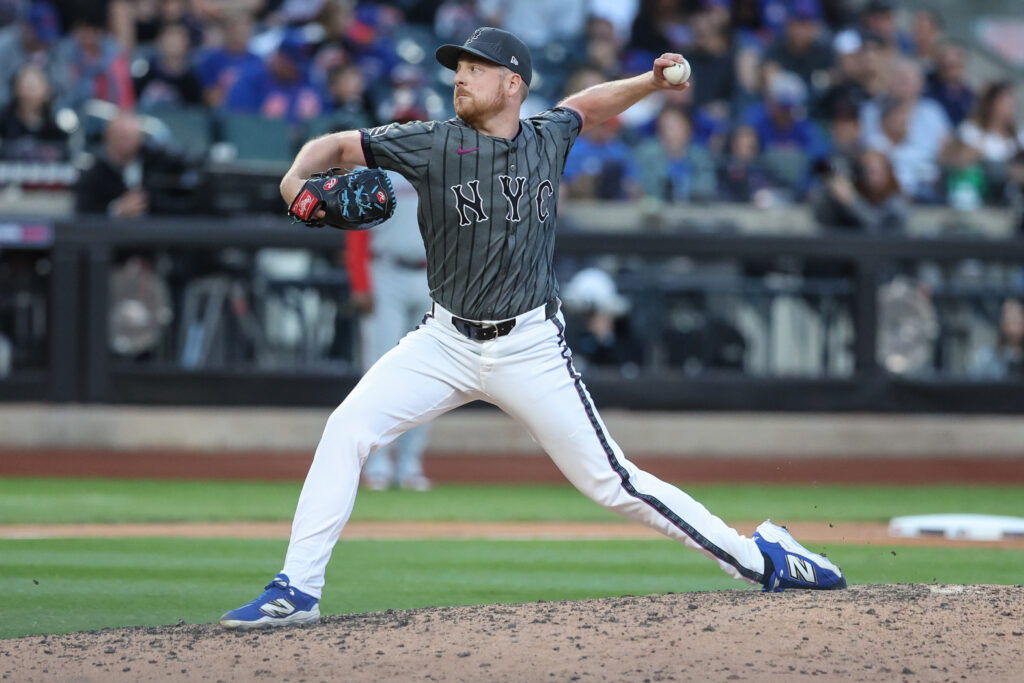

 English (US) ·
English (US) ·  French (CA) ·
French (CA) ·